Eleven days, 1650 kms of trails, for an amazing off-road adventure in Eastern Arabia!
We have recently posted a guide dedicated to the Sultanate of Oman, called the Oman trail. A 4.000 kms loop around the country along amazing trails. However, the original Oman trail, as described in my dairies – Letters from the Oman trail – was an off-road trip I did from Dubai all the way to Qalhat via Muscat, a couple of summers ago. This new travel guide, renamed the Al Hajar Traverse, is the result of that original journey, plus a new section in the Al Hajar Ash Sharqi, and can be linked to the Oman trail.

Available for you is the Google Earth .KMZ file you’ll need to open in Google Earth to visualise the trail, and then transfer as a GPX file on the gps device of your choice.
To open it, go to GOOGLE EARTH, click on FILE, then OPEN, go to DOWNLOADS, and select AlHajarTraverse.kmz
Please click on the link below to download the trail.
The Al Hajar Traverse
Table of contents
- Introduction
- Basic informations
- Ways to travel
- Local history
- The Al Hajar
- The route
- Day One – From Dubai to Mleiha
- Day Two – From Mleiha to Al Wadi Resort
- Day Three – From Al Wadi Resort to Fayyad
- Day Four – From Fayyad to Qubur Zalim
- Day Five – From Qubur Zalim to Bat
- Day Six – From Bat to Jabal Shams
- Day Seven – From Jabal Shams to Jabal Akhdar
- Day Eight – From Jabal Akhdar to Muscat
- Day Nine – Muscat
- Day Ten – From Muscat to Jabal Bani Jabir
- Day Eleven – From Jabal Bani Jabir to Fins
INTRODUCTION
Leaving Dubai behind, you will first drive through the sand dunes of the Emirates, before entering the Al Hajar mountain range in Ras al Khaimah. Once there, you will follow a successions of trails leading you across the border of Oman, and all the way to the sea port of Fins on the Gulf of Oman. This savvy mix of adventures across magnificent landscapes and stunning locations, will confront you with a wide spectrum of physical and technical challenges. You will observe and learn about local geology, discover a rich ancient history, and interact with an incredibly hospitable population. Jebal, wadii, forts, aflaj, ruins of old settlements, ancestral date gardens, beehive tombs, mosques, souks, and so much more, await you as you enter deep within a region entrenched in its traditions and ancestral ways…
This following guide tries to combines all the waypoints and informations you need to venture out safely and learn as much as you can about this enchanted land. Now, due to the rapid road network expansion in the region, not to mention natural alterations to the listed trails, the course described below may be subject to changes. Please make sure to come back to us in the comment section if you witness a roadblock or a new road where it used to be a trail, requiring us to modify our trace.
BASIC INFORMATIONS
This journey crossing two countries cannot be done in a rental car. No rental company in Dubai or Oman will allow you to cross the border between the two countries. As such, this guide is dedicated to the off-road enthusiasts of the region, or people willing to bring their own car/bike for the trip, such as overlanders on a broader journey. (However, I consider it too technical for larger overland vehicles such as campers)
-
- Languages. Arabic & some English. English will be fine most of the way. But be prepared in case you are confronted with a situation where you may need to interact with people that only speak arabic.
- Visas, CDP. The administrative requirements at the border between the UAE and Oman change often. Make sure to check with local authorities for the latests before leaving. What follows is what we know at the time of posting, but there is no guarantee it won’t change tomorrow.
- You are a GCC citizen: All you need is to show your ID at the border entering Oman.
- For the rest of us: At the UAE exit border, there is a 35 Dirham exit fee. At the Oman Border, you no longer can show up and get a visa on arrival. Instead you need to apply in advance online the Oman Royal Police website for an unsponsorded visa.
It’s meant to be pretty simple – Fill in the online form, attach travel documents, then pay the fee through a secure Global Payment Gateway. You’ll then receive your visa and notifications via email.
The tourist visa fee went up in April last year from OMR5 (Dhs47) to OMR20 (Dhs190). At the same time, the length of stay was increased from 10 days to a month.
Remember, some nationalities do not require a visa to visit Oman, and some nationalities (like New Zealanders) can obtain a visa free of charge. To find out which visa you’re eligible for, visit the website and click ‘apply for unsponsored visa’. After answering a few questions, it will show which visa types are available to you.
Regardless of your country of origin, if you are driving a vehicle from outside the GCC, your vehicle will require a Carnet de Passage to enter the UAE, as it will for Oman.
- Insurance:Valid insurance is required both in the UAE and Oman. Those can be purchased when entering the respected countries. Just know that those insurances do not cover off-road activities.
- Driving License: If holding a GCC country driving license you are fine. If not, you will need a valid international driving license.
- Money: The currency in the UAE is the Dirham, abbreviated AED. The currency in Oman is the Rial, abbreviated OMR.
- To find out the exchange rate click for Dirhams click here.
- To find out the exchange rate click for Rials click here.
- You can pay in Dirhams in Oman and get your change in Rial.
- Major credit cards are accepted almost everywhere, but when buying supplies in small food stores in remote villages it is advised strongly to have cash.
- Lodging: 99% of the time you’ll be camping under the stars. Camping is legal without restrictions in the UAE & Oman. It is very safe and the local population is extremely hospitable. It offers many beautiful sites for you to enjoy the nights.
Still you have hotel options along the way, some extremely luxurious. As the trail is divided by days, we have listed all available options each days for you in the following route breakdown. - Food: Again you are traveling in very remote areas. That is not to say there are no places to eat along the way, but most often you’ll be cooking at your campsite. We have listed all the restaurants as well as food stores you may find along the trail.
- When: The region can be extremely hot, and we strongly advise you to plan your trip between the end of November and the end of April. Any other time can be very hot, summer temperatures reaching 50° C on average.
- Weather: UAE weather – Oman weather.
- In case of an emergency: In the UAE call 999. In Oman call 9999
That being said, while you can get decent coverage in some areas, most of the time you won’t.
We strongly recommend you carry with you a satellite phone. As a matter of fact we think stupid and foolish to venture out without one.
- Languages. Arabic & some English. English will be fine most of the way. But be prepared in case you are confronted with a situation where you may need to interact with people that only speak arabic.
WAYS TO TRAVEL
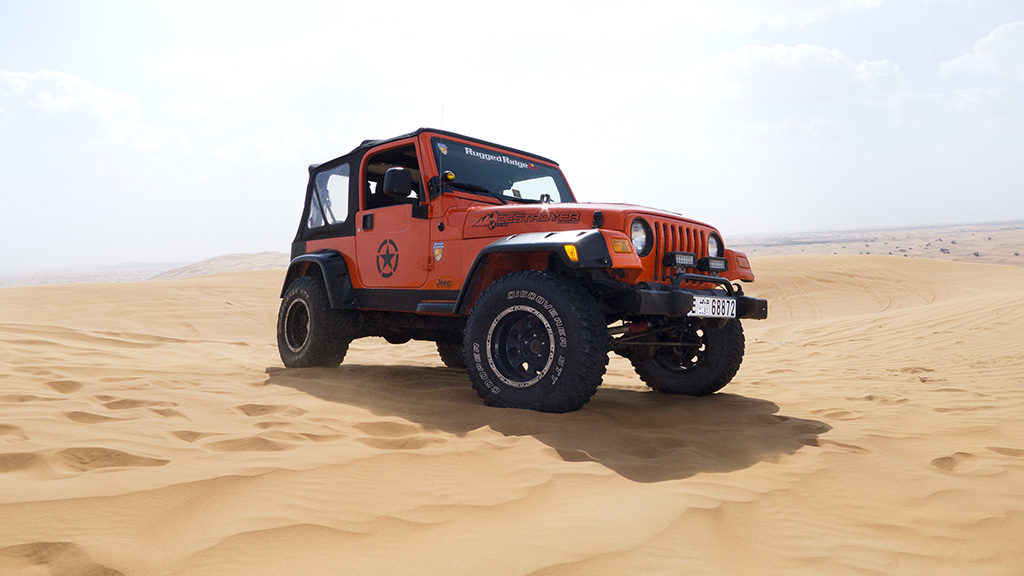
This is first and foremost an off-road adventure. When I first ventured out with the intention to create this trail, I did it with a 4×4. Being an expat living in Dubai at the time, taking my own Jeep was the obvious choice. It is the “easiest”, most comfortable and fastest option available by far! As such, the selection of the various tracks that compose this journey, was made with that type of vehicle specifications and requirements in mind.
I’m pretty sure most of you will venture in the same manner, but there are other options available to you. Depending on your preferences, your motivations, your experience, and the physical condition you are in, a quad or a motorcycle, are also very rewarding options.
Whatever your mean of travel, you must clearly understand and be well prepared for the specifics your choice implies. No matter what you decide, and the advantages it may offer you, they all include risks you cannot ignore. There is no such thing as a 100% trouble free adventure, and that’s precisely what makes it an “adventure”. The best way to minimize those risks is to be well prepared. How ? Do everything possible to avoid trouble before hand, and be sufficiently self reliable to get yourself out of trouble if necessary.
Finally, may you be a “through” traveler looking to complete the trail in its entirety in one journey, or explore a selected part at a time, or may you decide do it in reverse, is all up to you.
- Be prepared.
- Physically: No matter how you want to complete this journey, you must be sufficiently fit to survive any potential physical activity performed in this harsh and unforgiving environment. The heat, the lack of water, the isolation, are factors not to be taken lightly. Do not under-estimate the risks, thinking all will be just fine because you might be sitting comfortably in the air-cooled interior of a car. There will be many occasions for you to expose yourself and it can be brutal if not acclimated and ready. Again, to make it easier on you, plan your trip during the “cooler” months of the year, between late November and April.
- Mentally: This trail offers physical and technical challenges. Even though it was never designed with adrenaline junkies in mind, it may put you under stress every once in a while, depending on your level of experience. Be ready to reach out of your comfort zone now and then. Know yourself, observe, take your time and trust your judgement.
- Know your way: There are no maps or road atlas available in the region outlining the various dirt roads, trails or tracks you will follow for this journey. To safely navigate, you will need to download the routes (We strongly advise you to purchase the file to save you the time and effort – very soon ready for download in our boutique section) and all other pertinent navigation points onto a GPS device. To do so will required the use of softwares like Google Earth or Gamin’s Basecamp, etc.
However do not rely entirely on your GPS, study the trail on Google Earth as much as you can. You should almost have it memorized; its path, the points of interests, the gas stations and other food supplies stores, the escape routes, etc… Your first asset is your personal knowledge. It will be extremely precious when confronted with unexpected alterations and roadblocks, may they be the result of natural degradations or human “progress”. I will try to update this guide with the latest evolutions based on the feedback I get from fellow travelers and authorities, and offer alternate options, but there is always a risk to be confronted with the unexpected, and you should be able to “improvise” on your own.
- Be technically savvy: Make sure your vehicle is in good working order before leaving. If you use your own, have it checked by a professional mechanic, and perform all due required service. To keep it in good order during your trip, drive/ride it with caution at all times. Your car or bike breaking down on its own is very unlikely, the odds of you breaking it by reckless driving, are unfortunately much higher. In case something is to happen, you must know how to diagnose the problem, and have the parts and the skills to fix it on the spot.
- Physically: No matter how you want to complete this journey, you must be sufficiently fit to survive any potential physical activity performed in this harsh and unforgiving environment. The heat, the lack of water, the isolation, are factors not to be taken lightly. Do not under-estimate the risks, thinking all will be just fine because you might be sitting comfortably in the air-cooled interior of a car. There will be many occasions for you to expose yourself and it can be brutal if not acclimated and ready. Again, to make it easier on you, plan your trip during the “cooler” months of the year, between late November and April.
- Driving.
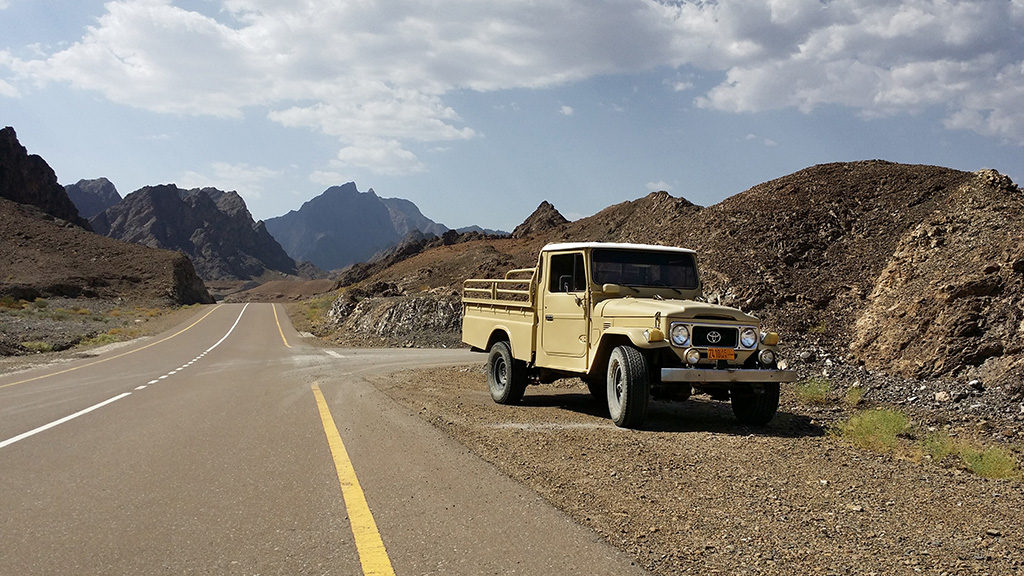
Toyota Land Cruiser HJ45 by the side of the road - 4×4: As outlined above, a real 4×4 is the obvious choice. It has the off-road capacity to take you everywhere safely on this trail, no matter how technical it may get.
- Tires: All terrain tires are a minimum if you want to avoid punctures. Road and sand tires are to be avoided. Have a spare in good condition with you and a puncture kit for emergencies. (Learn how to use it before you’ll need it)
- Enhancements: No modifications are necessary for this trip. I belong to a very small group, that believes a 4×4 is best kept in its original specifications. Driving a vehicle well thought of by experienced engineers and tested thoroughly by qualified technicians, sounds safer to me than an “artistically” modified “beast” assembled by a local backstreet garage. To each its own !
- Tires: All terrain tires are a minimum if you want to avoid punctures. Road and sand tires are to be avoided. Have a spare in good condition with you and a puncture kit for emergencies. (Learn how to use it before you’ll need it)
- Motorcycle / Quad: It’s not the size that matters, some complete the Dakar race on 125cc machines. It’s how you drive it and its fuel autonomy that matters. Keep it light, some of the climbs are really really steep and too much baggage will really drag you down.
Listed on the following routes are all the fuel options along the way. Plan your fuel needs accordingly.
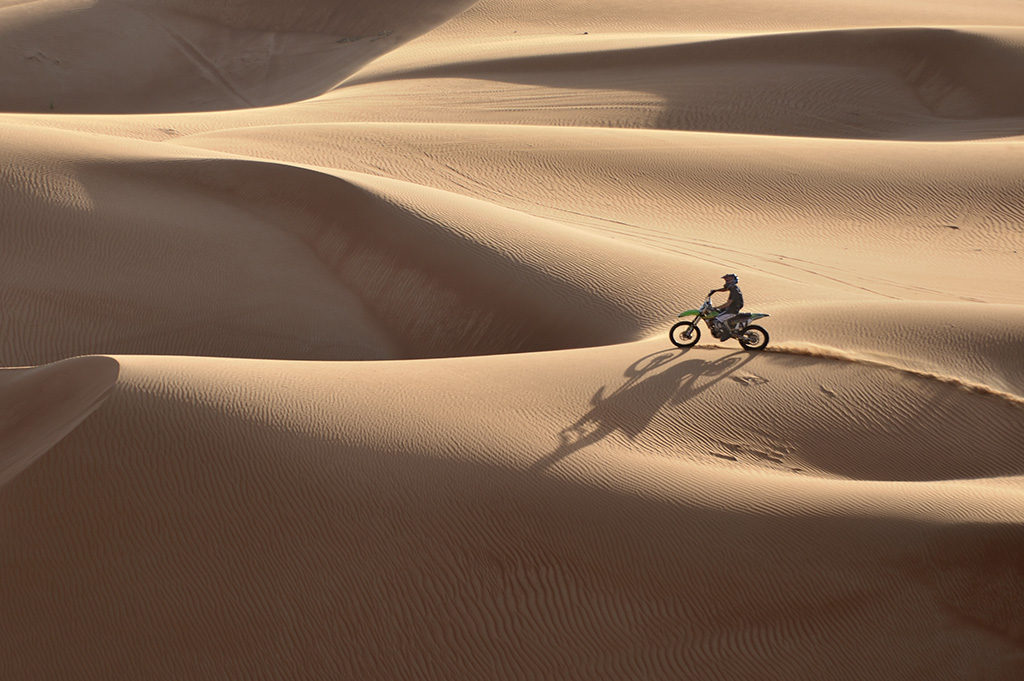
Nothing beats adventure on a bike - 4×4: As outlined above, a real 4×4 is the obvious choice. It has the off-road capacity to take you everywhere safely on this trail, no matter how technical it may get.
- Driving tips:
if you are not familiar with off-road driving we strongly suggest you spend time reading our beginners guide to off-road driving. However, If you have no experience and plan on doing this alone, you are looking for a lot of troubles, especially in the desert section. More on solo driving below. The parts in the Al Hajar mountains are not too complicated, and if you are alone with little desert experience, I suggest you avoid the desert section and start the trail on day 3.
- Basic rules: First and foremost you must follow and stay on the indicated or visible track.
A – because it’s the best way not to get lost,
B – because the mountain terrain is way too hazardous to allow you some improvisation safely.
A common mistake is to take a wrong path, and then decide to “cut through” to get back on the right one, instead of safely going backwards to the point where you took the wrong turn. What seemed like a short cut is 9 times out of ten a recipe for disaster.
C – Do not enter a portion of the trail if you don’t feel capable of passing through. Turn around when you still can. There is no shame in knowing your limits. A u-turn under stress on a narrow track shouldering a cliff is not a fun nor safe experience, reversing is even worse. When in doubt, get out of your car and walk it first to make sure you know what you are getting yourself into. Then take your decision. There are many alternatives available for you on the trail.Most of the trails you will drive on are vital to local villagers and as such are in general well maintained… That is until it rains. Rain running down mountain slopes will follow the easiest path available to reach the wadi below. That path is your trail. In doing so, it will create trenches, gulleys and displace rocks of all sizes. It may even take down entire stretches of the trail if passing through it perpendicularly. For some, it is when the real fun begins, for others this is when unwanted complications will slow you down.
- Sand: Check out this dedicated post.
- Wadii: A wadi is a river bed. Most of the time it is dry. But that can change in a matter of minutes in case of rain. Flash floods are a real hazard in this region and claim the lives of careless travelers every year.
Do not enter a narrow wadi if it is raining or the sky is menacing.
When confronted with water crossing. Before entering, first check how deep the water is and how loose the ground underneath it is. In most cases it is very shallow as seen on the picture below and doesn’t require any particular skills. However, when in doubt, get out of the car, cross it on foot first all the way and back before engaging your car. If the water is deep enough to reach your brakes, once on the other side, press a couple times on your brake pedal to make sure they have not been affected by the maneuver.
Do not attempt to cross during a flash flood. Instead, wait for the rain to stop and the water to go down, (it can happen rapidly and is well worth the wait), or simply turn around and find another way.
- Mud: Your chance of encountering mud on this trip is very slim. It only happens after a brief shower and usually dries rapidly. It is very similar to driving in sand. Good traction, the right gear and momentum is what matters.
When confronted with mud, stop, assess the obstacle, deflate your tires for increase traction if you deem helpful, select the right gear combination and enter. Do not engage too fast by fear of getting stuck in the middle, chances are you will slide, spin your wheels and get stuck or worse hit too hard an obstacle you couldn’t see at first underneath and break something.
If stuck in mud. Either get towed out if you are in a group, or get your Maxtrax or winch or a shovel if you are alone. If you have nothing like that with you, (then you are ill prepared !) pile rocks you can find around you underneath your tires to get better traction.
- Driving at night: Besides the obvious safety issues, what is the point ? You are on this trail to admire the landscape.
The main reason why you might be tempted to drive at night is most likely to be because you want to reach a pre-determined campsite and you’re late. Don’t ! In case you realize you are not going to make it on time, look around you and find a suitable space while it is still daytime. There are plenty along the way. Just don’t settle for a spot in the middle of a wadi bed. As mentioned before, flash-floods are a serious threat to your life.
- Solo or in a group ?
A group is almost always a safer way to enjoy this or any other adventurous endeavor. But it requires more organization and more discipline than going away on your own. When planning a group “expedition”, there is a lot more at stake than group chemistry. Being good friends is great, but it is not enough. Everybody must bring something to the team. Being responsible and in charge of a needed skill. May it be driving, navigation, mechanic, cooking, language, etc… A group of 10 drivers where nobody knows how to fix a flat tire, understands a map, doesn’t speak a word of arabic or ever started a fire, is not a team but a moving traffic jam looking for trouble.
A team needs a leader, a person with authority that can open the road and guide others according to everyone’s potential. It takes a lot of experience and psychology to be a leader. It also needs a second “in command” sweeping at the back of the convoy, helping those in trouble. Communication among all team members is key. (However, it be noted for those coming from Dubai, that Walky-talkies are illegal in Dubai and can be confiscated at the border when returning from your trip. I had mine confiscated after a meticulous 1 hour search of my vehicle at 3 AM in the morning at the border. – No Comments – )
Make sure you build a qualified team around you and try it on a few short outings before making the big jump.On the other hand, solo driving offers more freedom and flexibility but requires a certain amount of experience in many domains as you will have to solve every challenge that comes your way on your own. Now, if you are coming to the region for the first time, are on your own to do this trip, have no experience with off-road driving in this environment, speak no english or arabic, it goes without saying that renting a car to tackle this trail alone is foolish at best, and I can’t be held responsible for all the troubles you might get yourself into. You’ve been warned !
- Fuel: There are many gas stations along the way, all indicated by gps points. As a general rule I always carry an extra 20L Jerrycan of fuel in case of an emergency (But I have a long range with my car you may not have – plan accordingly). I also refuel whenever I can regardless of how much gas I have left. Always play it safe. Know your car’s range and average fuel consumption based on encountered terrains to avoid surprises. As an example, there is a big gas-mileage difference between my Diesel Jeep Wrangler Unlimited and a 2 door petrol version. Study the trail before venturing out. Look at the distance between each gas station on google earth, check the opening hours of the various stations and if they carry your specified requirements. We have listed them in our daily route breakdown below.
There is also a substantial consumption difference between driving in 2WD or 4WD mode. Stay in 2WD as much as you can will save you a lot of gas.
- Equipment: Less is more. Why ? Because weight is your enemy.
We live in a society that thrives on consumption, where marketing gurus will have you feel naked unless you possess everything for anything. Through ads, brochures and reviews, they will lead you to believe that you can’t do in life without the latest, the most, the best, the highest, the biggest and the useless. I, too, at first, felt for it, thinking I needed to look like an explorer to explore, convinced my safety, my comfort, worst, my credibility depended on it. And while most of the inhabitants you will meet while exploring remote areas, thrive with close to nothing, we feel obligated to carry the world with us to just survive. It not only has a cost, it also has consequences. The heavier you are, the harder it gets to move it. It’s called weight versus performance. Or how a simple climb can quickly become an Everest because you took too much useless stuff with you.Here is a list of what I bring with me.
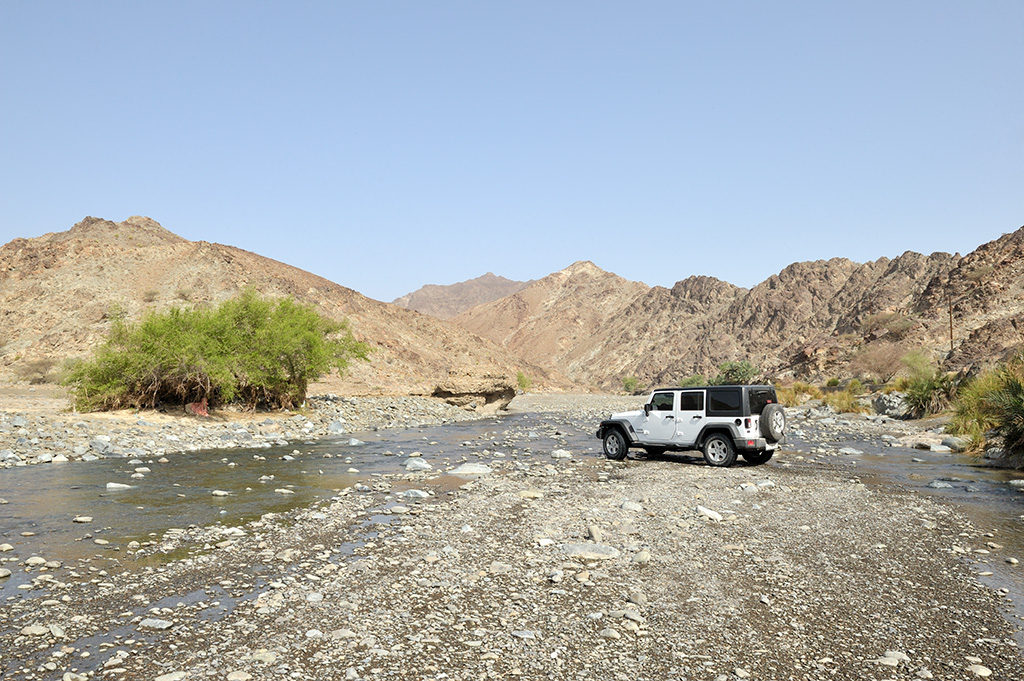
Crossing a wadi - Basic rules: First and foremost you must follow and stay on the indicated or visible track.
- Camping.
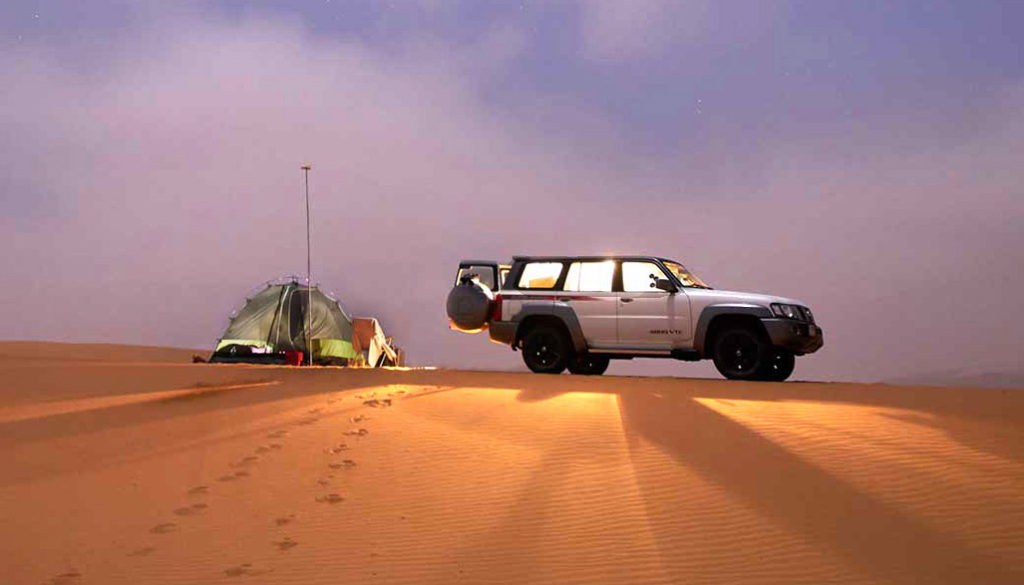
© Neil Walton Camping is for me one of the best part of the trip. A night under the stars, enjoying a good book by a fire, away from the crowd and the noise… Is easier said than done ! And like everything else, it requires proper planning. As a rule, you should know where your next campsite will be, as you leave the previous one. Do not set your mind on a single option. Instead consider several locations listed on your way to account for potential delays and other complications. Understand the more attractive the site you selected is, the more popular and crowded it may be. Make sure to consider week days and week-ends. A white sandy beach at the end of a beautiful wadi might be a good choice on a Tuesday night, but will most likely be a very crowded party spot on a week-end.
Try to set up camp an hour before sunset. Finding the location, unpacking, getting your tent up in the dark is not as nice, worse can lead to unpleasant surprises.KEEP THE PLACE CLEAN.
I shouldn’t have to say this, and it should be obvious to anyone. Unfortunately it isn’t. Do not leave anything behind. No one is here to clean up after you !!
Check my tutorials on camping for more informations on the do’s and don’ts and how to leave no trace.I have tried to list the best potential sites, feel free to improvise if you find a spot you like. In some areas, due to the terrain, your options are minimal, in others, there was just too many possibilities to bother listing them. As it should be obvious, just respect your environment and the people around you.
I shouldn’t have to say this, and it should be obvious to anyone. Unfortunately it isn’t. Do not leave anything behind. No one is here to clean up after you !!
- Other activities.
Trekking, climbing, canyoning, etc…
Because there is a lot more to do than just drive. The Al Hajar mountains in particular offer great outdoor opportunities. Bring along with you the required equipment to explore the surrounding wonders. If interested in trekking through the Wadii, you need canyoning equipment, specially if interested in Wadi Awf in Jabal Akhdar. In Wadii Shab and Tiwi, you’ll need to swim your way through. This guide won’t get into the specifics of each activity and the skills and tools you need to bring along. It is understood that if you decide to explore out, you have the experience and ability to do it.
LOCAL HISTORY
Because knowing a little about where you are always helps appreciating what you’re looking at !
Pre-Historical times.
The region’s first history, as we know it, goes all the way back to 135,000 years ago, when the first climate migrants (already!), escaped the prolonged droughts of the African plains they lived on. At the time, the Arabian peninsula was far more hospitable than it is now, and offered better surviving conditions. Crossing a much narrower and shallower Red Sea, the early settlers moved on, some finding relief in what is today the Sultanate of Oman and the UAE. Stone tools dated from 125,000 years ago have been found in the area attesting of their presence.
As shown by other recent archeological discoveries, men flourished in this land. Throughout what we like to call the Stone, Bronze and Iron ages, all the way to the arrival of the first muslim fighters, the region was linked to a complex and sophisticated regional trading network, recognized as a well established outpost within the antique civilizations of the Middle-East, one that never stopped to grow.
During that time tribes of the mountains erected sophisticated architectural structures made of local stones and mud, some as early as 5.500 years ago. Complex Necropolis sites from that era, like the beehive tombs of Al Ayn, are still visible today. In them we have found weapons and jeweleries, as well as potteries from Southern Mesopotamia, confirming the prosperous regional trade activities. Their ability to survive an environment turning more arid with the help of complex irrigation systems, allowed them to settle and prosper, feeding on livestocks or crops like cereals and date. Rich in natural resources, such as copper, the region, know as “Magan” in ancient Mesopotamian writings, (which could mean the copper mountain), exported some early on as far as the Indus river Valley, also confirming their nautical abilities.
With time, the original Persian population was replace by Arab tribes coming from Yemen. And as the population grew, the early settlements turned into fortified towns and ports, looking over fishermen, farmers and merchants.
The Mleiha archeological museum is a fantastic place to find out more about this era. The trail makes a point of stopping there and we encourage you strongly to spend time for a visit.
Islamic times.
The next major cultural shift within the population came with the arrival of the first Muslim fighters in 630 AD led by Amr ibn al’As. The local Arab ruling family in Oman, the Julanda, welcomed the general and his army hoping it would freed them from Persian domination. In 632, thanks to reinforcements send from Medina by Khalifa Abu Bakr, the muslims finally turned victorious at the battle of Dibba (In today’s Fujairah emirate), opening the way for the spread of Islam through the region. As much as local arabs were quick to embrace the new religion, it didn’t take long for the tribes of Oman to branch out with their own version of the prophet’s preachings, called Ibadhism, making it one of the earliest branch of Islam.
Ibadhism’s intent is to remain true to the original preachings, before it was “corrupted” by the third Khalifa Uthman. Concentrated mostly in Oman, where about 75% of the local population still consider itself Ibadhi, the school has been very prolific in regards to islamic law. Under Ibadhi law, local Sheikhs decided to elect their rulers by communal consensus, as opposed to hereditary rules as custom in other muslim teachings of the time. In order to be Imam in Oman, you had to be first nominated by the Ulema (the guardians of the religious doctrine), then receive allegiance from all local Sheikhs, as well as the local population. Due to its isolation, as well as its peaceful ways, this system survived all the way to the middle of the 20th century, and cohabited well with its sunni neighbors of the Emirates.
Opening to the sea.
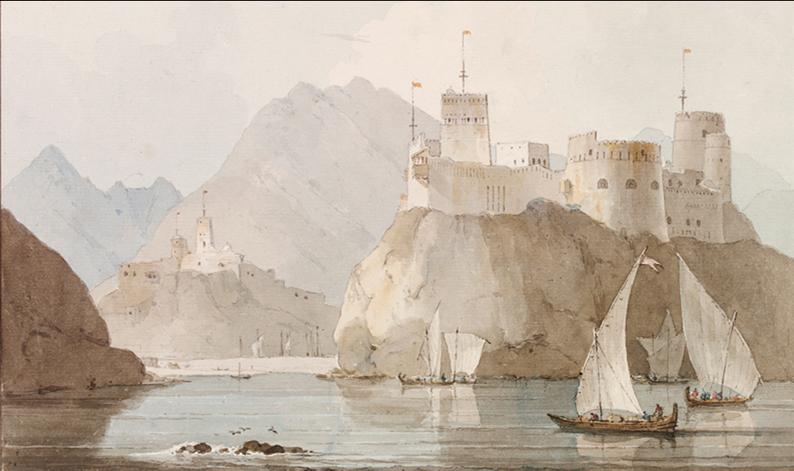
As every land opened to the sea, Oman and the Emirates made the most of their geographical position. Very early on, as soon as it could safely venture off-shore, local merchants went on to explore new trade opportunities. First concentrated on direct neighboring countries, it then expended to India, Eastern Africa, and as far as China, bringing riches to local merchants.
With the arrival of the Europeans, Oman mostly became an important trading stop on the road to Asia. Here, goods from all over were exchanged, providing great revenues to locals. Combining their own navigating skills with those learned from foreigners, by the late XVII century the Omanis were a naval force to be reckoned with, expending their own territories to part of East Africa, all the way down to Zanzibar, making it for a while their own capital.
By then, they were not alone making their presence felt on the sea. On the other side of Hormuz, the tribes of Sharjah, Umm al Quwain, and Ras al Khaimah, know as the Qawasim pirates, ransomed merchant ships trading around the area. Their presence became such a menace to the business equilibrium of the area, it had to be put to an end by the British navy, taking over the control of the region in the process.
Foreign influences.

The British take over in 1820, of what was then called Oman and soon to be referred to as the Trucial states is the last of a long list of foreign powers controlling this strategic geographical position.
Looking over the straight of Hormuz, not to mention its rich natural resources, the region has always been the prey of numerous foreign powers. From the beginning of time the Persians have had a strong hold on the region. As mentioned above, other Arab tribes came in from Yemen and Medina. In the middle of the tenth century, the Qarmatians Tribes from Eastern Arabia, a little north of present day Qatar, seized control, shortly followed by the Iranian Buyyids dynasty from 967 to 1053, themselves replaced by the Turco-Iranian Seljuk Empire from 1053 to 1154.
Having managed to regain their own destiny in 1154 under the rule of the Nabahni Kings, Oman fell again, this time to European influence, with the arrival of the Portuguese in 1508. They stayed on till 1650, leaving behind the many forts along the coast you see today. Shortly after, Persians will get involved again for a little while, before a second golden age of Omani independence from 1744 till 1820, interrupted again by the British domination.
The great dynasties of Oman.
Ya’ruba dynasty.
In 1648, Iman Sultan ibn Saif, defeated the Portuguese in Muscat, before chasing them all the way to India, taking over most of their colonies in the process. At the time, Nizwa is the capital of the Imamate of Oman. Status reinforced by the erection of a new fortress still visible today. Saif Ibn Sultan, his son, will continue the work of his father, stripping the Portuguese of even more colonies, particularly on the Eastern African coast. The liberation and the following unification of the country, the military conquests, the strength of the Oman navy, have allowed the Imams to negotiate as equals with the other European actors in the region. The new trade agreements are no longer imposed on Oman by force, as the Portuguese had done. Instead the British are now invited to the business table as equals. All of which did bring almost a century of peace and wealth to the nation.
Unfortunately, after the death of Sultan ibn Saif in 1718, the Ya’ruba dynasty and the rest of the country did fall into a succession war the Persian ultimately took advantage of, until the rise of Ahmed ibn Said in 1747.
The Al Bu Said dynasty.
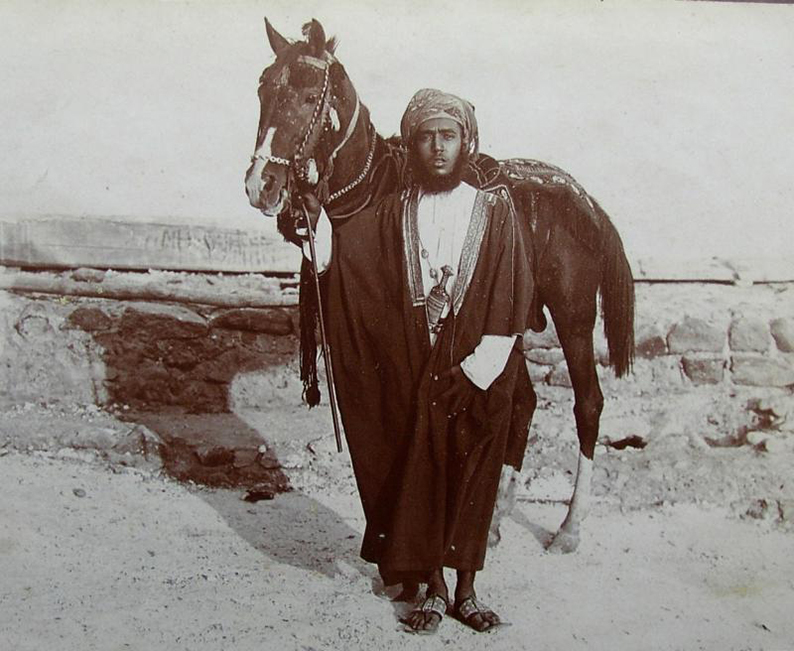
The Said dynasty starts with the rise of Ahmed ibn Said who, after expelling the Persians managed to reunite the country again. Despite constant attacks from outside powers, on land or at sea, the Saids kept control over the trade transiting through the straight of Hormuz, and imposed their conditions on all local exchanges. During the reign of Sayyid Said ibn Sultan (1804-1856) Oman expanded so much it actually moved its government to Zanzibar, making it its new official capital. However his death announced the end of a golden age, with two of his sons involved in a new succession dispute. Oman is divided and split between the two. One son taking control of the Sultanate, the other Zanzibar. Not all will be easy from then on for Oman. The Al Bu Said clan, now a royal dynasty suffered the same internecine power struggles, murders and treasons common in all ruling parties. But despite all the in fighting, notably between the Imams of Nizwa and the Sultans from Muscat, the Said family has managed to keep the reins of Oman’s destiny, Sultan Qaboos being the last of them ruling the country today.
Imams and Sultans.
One of the many problems Oman had to overcome was the constant battle for power between the elected Imams residing in Nizwa and controlling the mountains, and the hereditary Sultans rulling Muscat and the coast.The Said dynasty, in an attempt to unify the country had ceased to recognized the Imam of the interior. While the interior tribes refused to consider anyone else than the elected Imam as their legitimate ruler.
This antagonism was multiplied by the discovery of Oil in Oman in the early 1950’s, and the right to grant concessions to foreign contractors. The Sultan was quick to claim his authority over the deals and its revenues, Only to be contradicted by the Imam arguing the oil was on his territories, and as such belonged to him. This dispute elevated in 1955 with the beginning of the Jabal Akhdar wars, when the Sultan send his troops to occupy Nizwa and Ibri, the two Imam’s stronghold. By 1957, the Sultan forces had to withdraw, suffering numerous casualties during repeated ambushes in the mountains. At the time Jabal Akhdar was a very isolated stretch of rocky mountains, and it took the military intervention of British forces, who had taken side for the Sultan, to eradicate the rebellion. Many remarkable ancient villages, like Tanuf, were sadly reduced to complete ruins in the process.
The tribes of the Emirates.
The tribal organization of what is known today as the United Arab Emirates can be divided into two main separate entities. The Qawasim of the north – Sharjah, Ajman, Umm al Quwain, Ras al Khaimah and Fujairah – and the Bani Yas of the South – Abu Dhabi and Dubai. The Qawasim rise to fame came with their prowess on the sea. Fishermen and pearl divers turned pirates, they efficiently disrupted the trade routes around Hormuz for many years, raiding merchant ships until the english finally had to put a stop to it in 1820. The Bani Yas survival, on the other hand, came with the culture of inland desert oases such as Al Ayn or Liwa, and coastal fishing activities in the mangroves of Abu Dhabi. With the English destruction of the main Qawasim ports, Abu Dhabi was able to embrace a much more prominent role at sea, and imposed itself on the pearl trade. This expansion allowed some members of the Bani Yas clan, known as the Al Bu Falasah, lead by the Al Maktoum family to migrate up north to the small port of Dubai, and transformed the then small creek into the commercial force we know today.
Today.
Oman’s destiny changed in 1970 with the arrival of Sultan Qaboos. Taking over his father after a coup, the new Sultan, decided to put all his energy in transforming his country into a modern state. His first task was to reunite the country once and for all. Then with the revenues of oil and natural gas, and the support of the British government began the modernization of the country. New infrastructures, new and more efficient services, Oman slowly began to catch up with its neighbors. It is today a great mix between modernity and tradition.

The other leader changing the destiny of his future nation is Sheikh Zayed of Abu Dhabi. When he takes over from his brother Sheikh Shahkbut in 1966, oil extraction has only begun 4 years before and the British are about to announce their withdrawal from the region. With their exit the region is loosing the protection it desperately needs during those troubled times. With the perspective of instability looming over the Emirate, as it is just beginning to recover from the years of economical hardships created by the downfall of the pearl trade, the new charismatic leader decides to reach out to its neighbor, Sheikh Rashid of Dubai, in an attempt to lay the grounds for a future Emirati federation. It is obvious to him that a stable region benefiting from the riches of oil is in everyone’s interest. After intense negotiations among the local Sheikhs of the Qawasim tribes, the United Arab Emirates are created the 2nd of December 1971. What seemed improbable at the time as proven to be the most stable and prolific union in the Middle-East, generating not only peace and wealth, but a model to be followed.
AL HAJAR MOUNTAINS
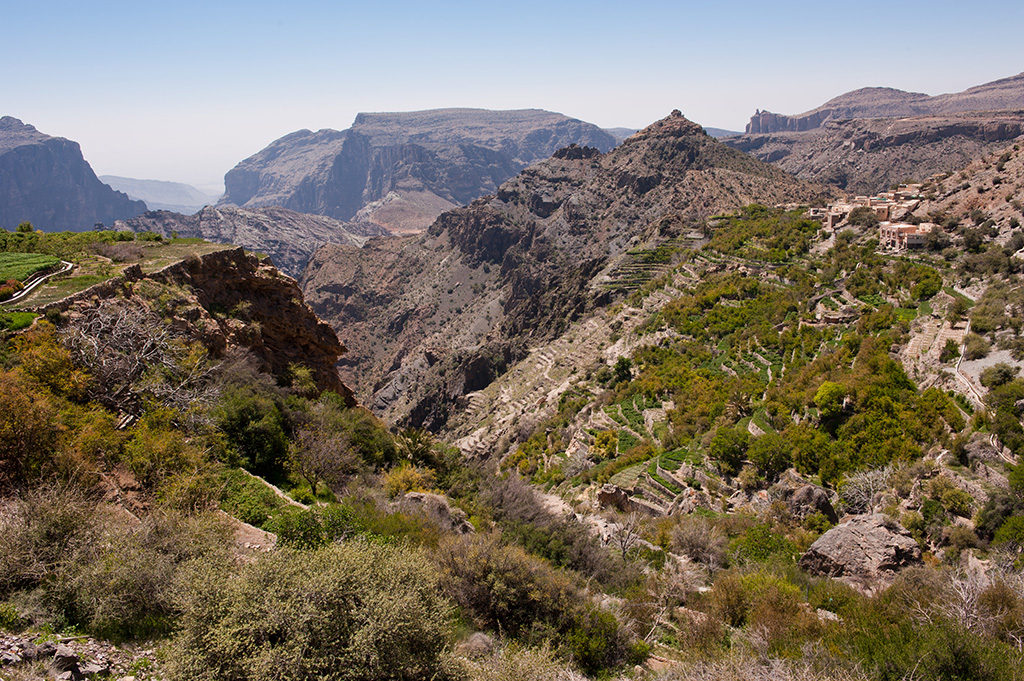
Al Hajar mountains, understand in english; the Rocky mountains. Hard to find a more obvious choice of a name to describe this spectacular mountain range. A mix of limestone, ocean crust and earth upper mantle exposed as nowhere else in the world, making this region an geological wonderland.
Located on the eastern corner of the Arabian peninsula, standing tall above an ocean of sand, it began its formation when the old Afro/Arabian plate began to move towards the Asian plate. As a result, the crust and deep mantle of the Indian ocean were pushed upwards over the edge of the tectonic plate. This ongoing obduction and subduction process created a massive structure of various rock formations; ophiolites, metamorphosed ocean sediments, limestones, Hawasina and other exotic sediments piling up vertically above sea level during the late Cretaceous (90 – 75 million years ago), before eroding rapidly, and falling under see level again, where shallow marine sediments began to cover it again.
It’s only 30 million years ago, during the late Oligocene, that a new and still active uplift re-exposed the rocky mountains we see today. All this movement is believed to be related to the separation of the Arabian and African plates, with the opening of the Red Sea, and the resulting shift towards the Eurasian plates, where the Zagros mountain range in Iran erected simultaneously.
Maps will separate the range in two geographical entities; the Eastern Hajar and the Western Hajar, separated by Wadi Samail near Muscat. In reality the true distinction lays geologically between the Musandam Peninsula, also called the Ru’us al Jibal (the head of the mountains) and the rest of the range, starting on the Fujairah Emirate border by Dibbah. The Ru’us al Jabal is mainly composed of Mesozoic carbonates sediments, found barried under sand throughout the rest of the arabic Peninsula, while the rest of the range is a mix of solidified lava from the ocean crust and upper mantle formed deep within the earth called ophiolites, mixed with shallow water sediments and limestones.
THE ROUTE
Day One
Dubai to Mleiha
144 km.
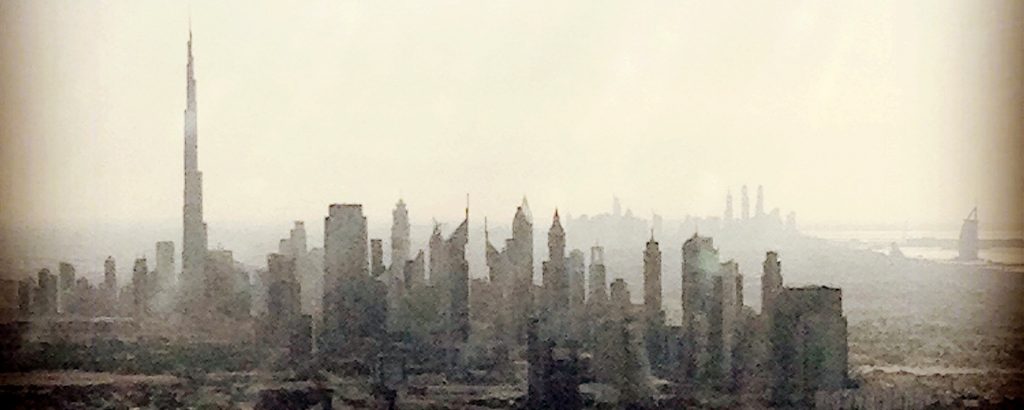
Introduction.
Time to start our Journey and leave Dubai behind. Today’s drive takes you through some of the most stunning natural landmarks in Dubai and Sharjah. Al Qudra lakes, Pink Rock, Big Dune, Camel Rock, Fossil Rock. It also makes a stop at the Mleiha Archeological museum. Time has been spared for you to stop and appreciate each one of them. The Museum being essential in order to understand the importance of the region in Middle-Eastern history.
Recommendations.
Those recommendations, as for the rest of this guide, applies to 4×4. I don’t have the required experience to advise you when it comes to bikes or quads.
Today is a mix of roads, desert tracks and fun dune sections. Deflate your tires to 15 psi as you enter the first desert track near Al Qudra Lakes. No point getting your tires back to normal each time you enter a new road section, they are too small in distance to matter. Just drive on them with caution. There are plenty of gas stations along the way, no need to worry about running out today.
Food wise, I believe you have packed up all you need before heading out. If not you’ll be saved by local food stores along the way.
Tonight you will camp in the desert. Enjoy, but remember to leave no trace !
For those not trusting themselves through dune sections, do not try venturing alone if you don’t have the experience required. No shame in being safe. I advise you to skip today and the following day. Instead you should start the trail at this way-point and enter the mountains directly.
The drive.
Starting Point.
25°08’56.65” N – 55°11’46.23”E
This is our starting point. The beach overlooking one of Dubai’s most famous landmarks, the Burj al Arab. Enjoy the view for a while before taking Zaglaba street on the left, leading you to Jumeirah Beach Road, where you’ll then take right and head towards the gas station.
25°08’50.45” N – 55°11’47.12”E
This is your first gas station, you also have a small food market there for you. Once done, get back on Jumeirah Beach Road and head towards Umm Suqeim Street D 63.
25°07’57.81” N – 55°11’17.06”E
Turn left on Umm Suqeim Street D 63 and stay on that road all the way to the end in Al Qudra.
There will be two more gas stations and food stores along the way. Stop if needed.
24°51’05.69” N – 55°20’41.65”E
This is the end of Road D 63 which is now called Al Qudra street, at the junction with Saih al Salam Street D40 in Al Qudra. Take the second exit at the round-about.
24°51’02.40” N – 55°20’44.14”E
Leave the main road D 40 and take right towards the bike shop, then immediately take left.
24°51’01.46” N – 55°20’46.52”E
Leave the main road and take right on the track leading towards the Al Qudra lakes.
The Al Qudra Lakes
“Al Qudra Lake is a man-made lake in the middle of the Saih Al Salam Desert in Dubai, UAE. The Lake, spread over 10 hectares, is home to more than one hundred species of birds including many migratory birds.” Wikipedia
The lakes used to be a fantastic place to camp and observe wildlife. However, thank to inconsiderate people leaving their trash behind, authorities have decided to ban outdoor activities in the area to preserve it from human stupidity !
Since you can no longer drive through the area. Just park your car and have a look around. Once your are done get back on D 40 heading East.
24°51’28.52” N – 55°22’14.24”E
Leave the road for the dirt track on your right. This is the place to deflate your tires to 15 PSI for the rest of the day.
24°51’23.38” N – 55°22’17.57”E
Take the first desert track on your right. And follow that same track all the way to the Pylons as it goes around the lakes you just visited.
24°50’17.65” N – 55°25’25.58”E
You’ve reached the pylons. Take left and follow the pylon track straight on. (If you’re looking for something more fun and more challenging than the main track, nothing stops you from enjoying the dunes on each side of the pylons – The ones on the right are the best – as long as you keep heading in the same direction.)
24°55’20.17” N – 55°31’06.55”E
Take right.
24°55’09.26” N – 55°31’15.73”E
Take left and follow the road passing underneath E66 Dubai – Al Ayn Road. At the following round-about take the second exit.
24°55’14.91” N – 55°33’38.44”E
Leave the road for the desert track on your left.
24°57’23.96” N – 55°34’32.46”E
At the Y-section keep left on the main track.
24°57’41.76” N – 55°34’58.38”E
You’re entering a small and easy dune section through the Margham desert. Keep heading in the same direction until you reach 24°58’20.90” N – 55°35’38.51”E and the desert track following the edges of the plantations. Take right on that track.
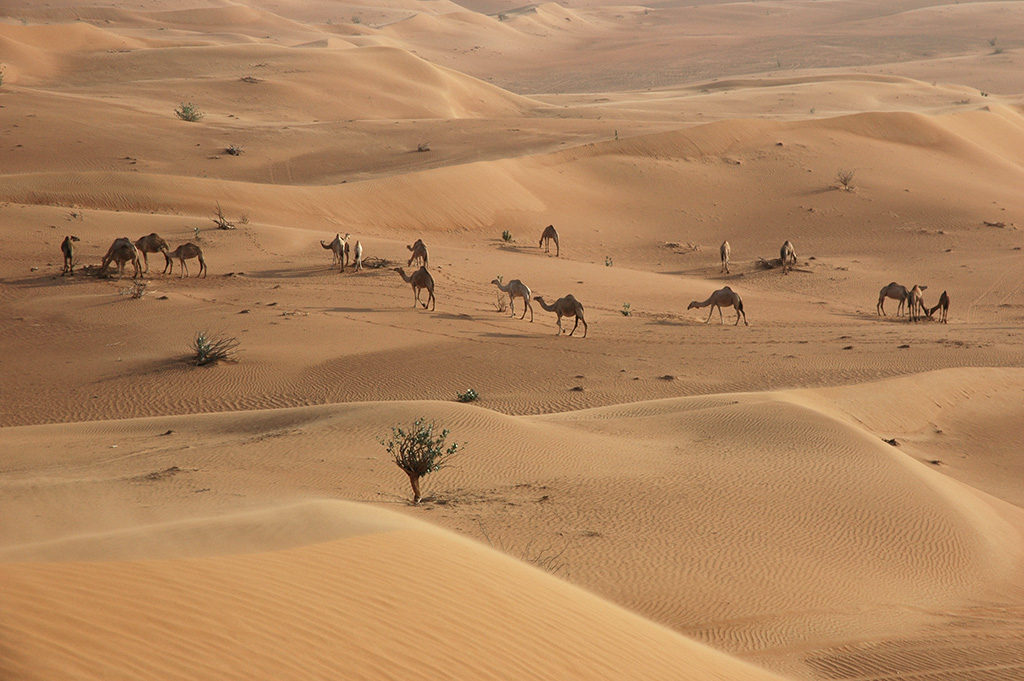
24°58’29.96” N – 55°36’51.69”E
Take left on the road, and pass in front of the industrial area.
24°59’20.00” N – 55°36’57.06”E
Take right on the desert track, then right again, and left at the following fork.
24°59’18.38” N – 55°37’38.66”E
This is the first real desert driving test (unless you have left the pylon track for the dunes earlier). You’re about to enter a small dune section.

Head East towards 24°59’54.13” N – 55°39’39.28”E and the Junction between D40 and Madam Road E44 also know as the Hatta road 44. There you will find a gas station in case you need it, as well as a food store and a “burger” joint (its a place often busy with tourists on their Dune bashing trip to Al Badayer). Get on E44 heading towards Madam.
24°59’45.97” N – 55°39’47.08”E
Get off the Hatta road and follow the exit as it passes underneath the main road. At the round-about on the other side take the first exit. You’re now in Sharjah.
24°59’48.64” N – 55°39’52.60”E
At the end of the tarmac, take left around the school. (I think it is a school)
24°59’54.78” N – 55°40’06.70”E
Take right.
24°59’47.85” N – 55°40’11.81”E
Take left at the junction.
24°59’43.23” N – 55°40’15.91”E
Take left at the junction, then left on tarmac.
25°00’02.02” N – 55°40’15.71”E
Leave the tarmac road and enter right on desert track.
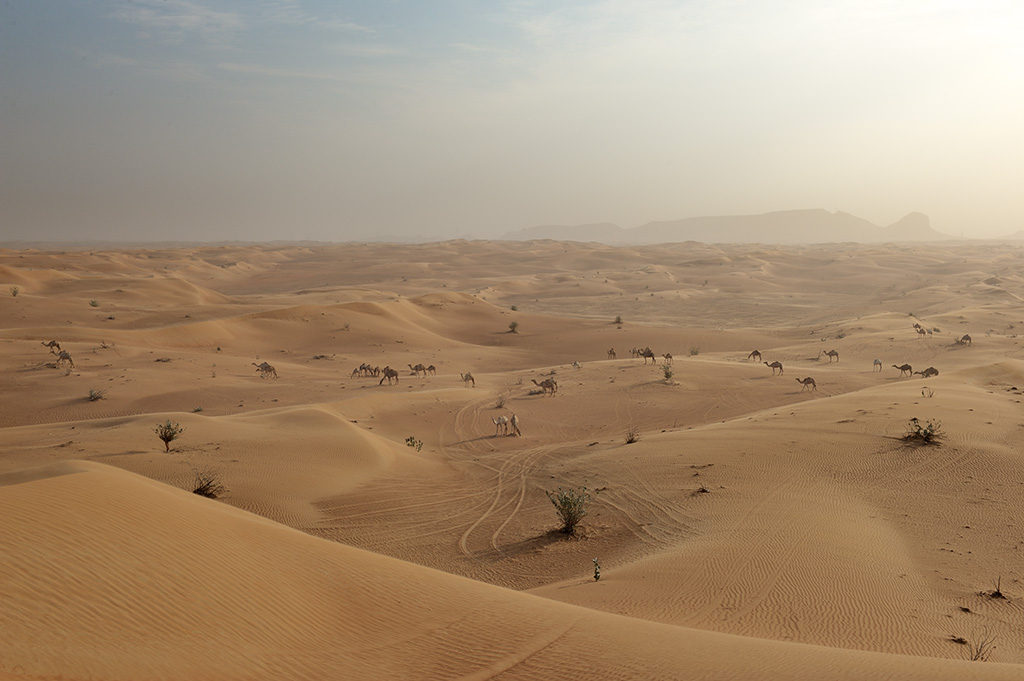
25°00’15.65” N – 55°40’38.88”E
Follow the main track as it bends right.
25°00’14.29” N – 55°40’57.58”E
As you arrive to the farm, take right.
25°00’06.95” N – 55°41’02.64”E
Take left. You’re entering a new dune section as you head East towards Pink Rock at 25°00’50.79” N – 55°43’27.22”E
Have a break, get out of the car and climb up for the better view of the surrounding desert.
After driving around Pink rock, aim for the 2nd of December “cafeteria” by the road at 25°02’26.89” N – 55°43’55.49”E. Cross the road and follow the track on the other side called the Tawi trail. Keep heading East.
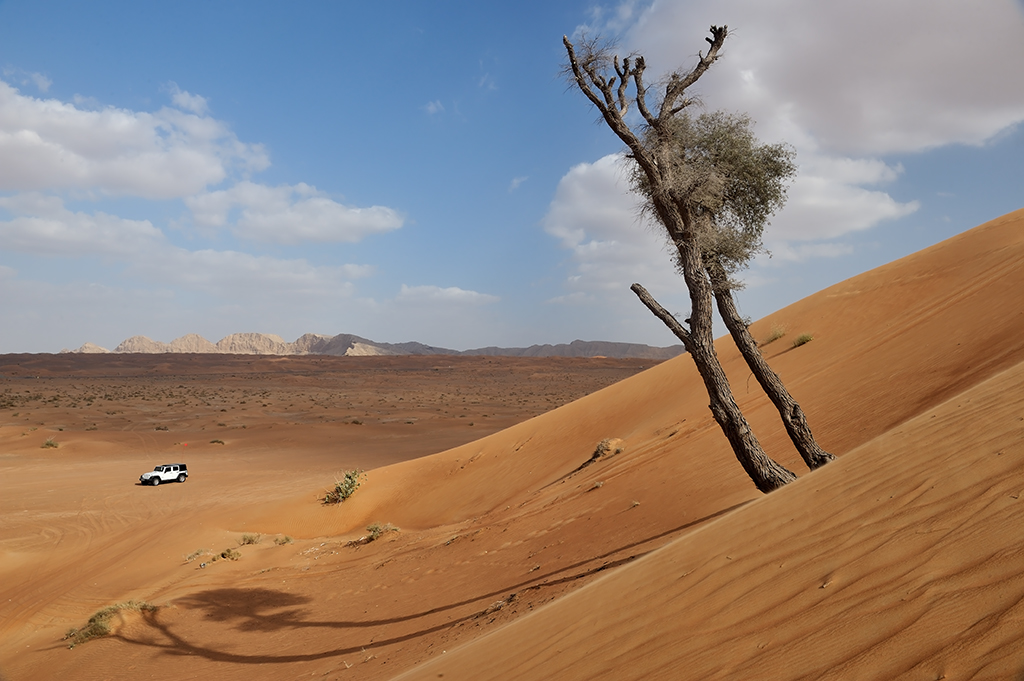
25°05’29.66” N – 55°47’27.69”E
From here you can proceed with caution as you drive down the wadi and continue towards the Al Batayey – Al Faya road S149. As you get on the road, you will have to drive to the next U-turn option and come back to 25°05’13.90” N – 55°48’11.18”E on the other side. You will find a place to drink if you want before driving towards big dune.
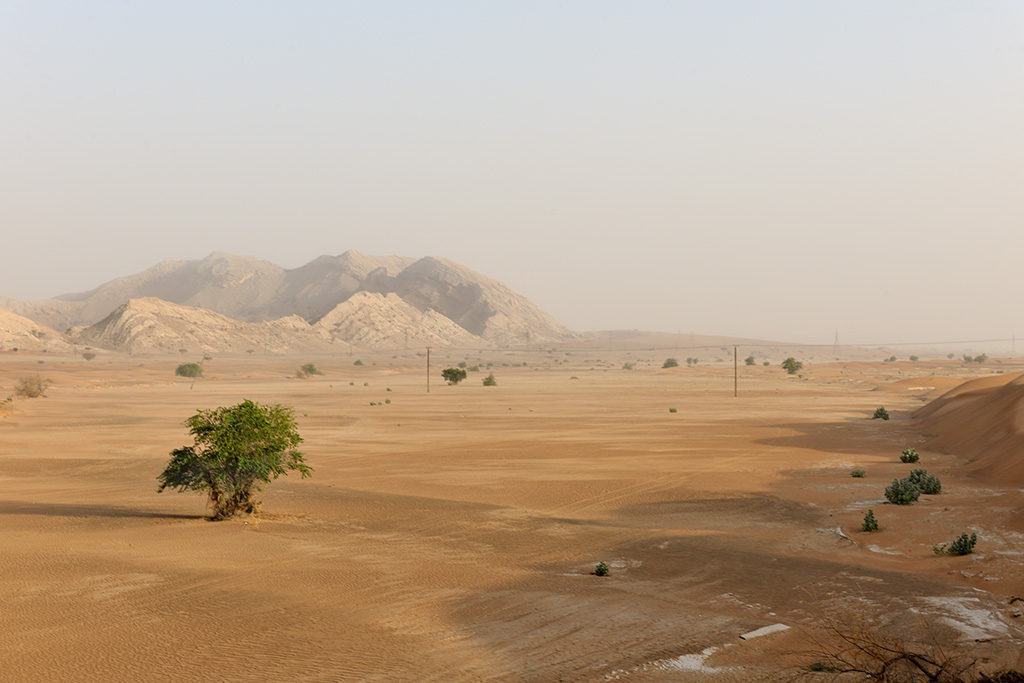
25°05’13.90” N – 55°48’11.18”E
Leave the tarmac and drive towards big dune. You can climb up if you want for a better view. If not, or after you have come back down, pass the dune on its right as the track heads toward the wadi and follow the edge of the dune ridge heading East.
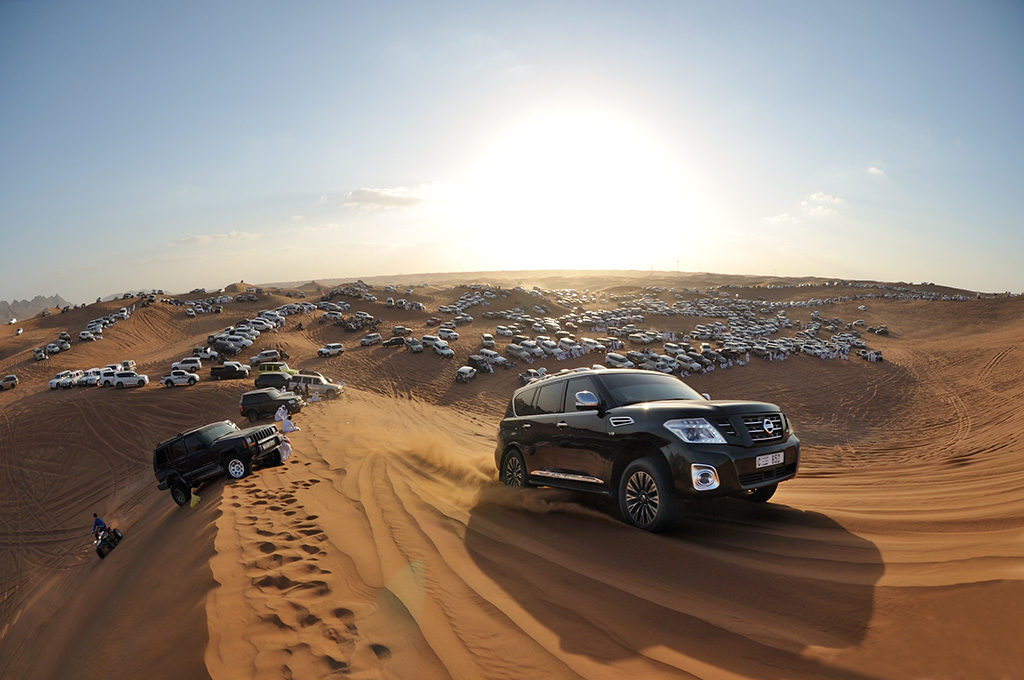
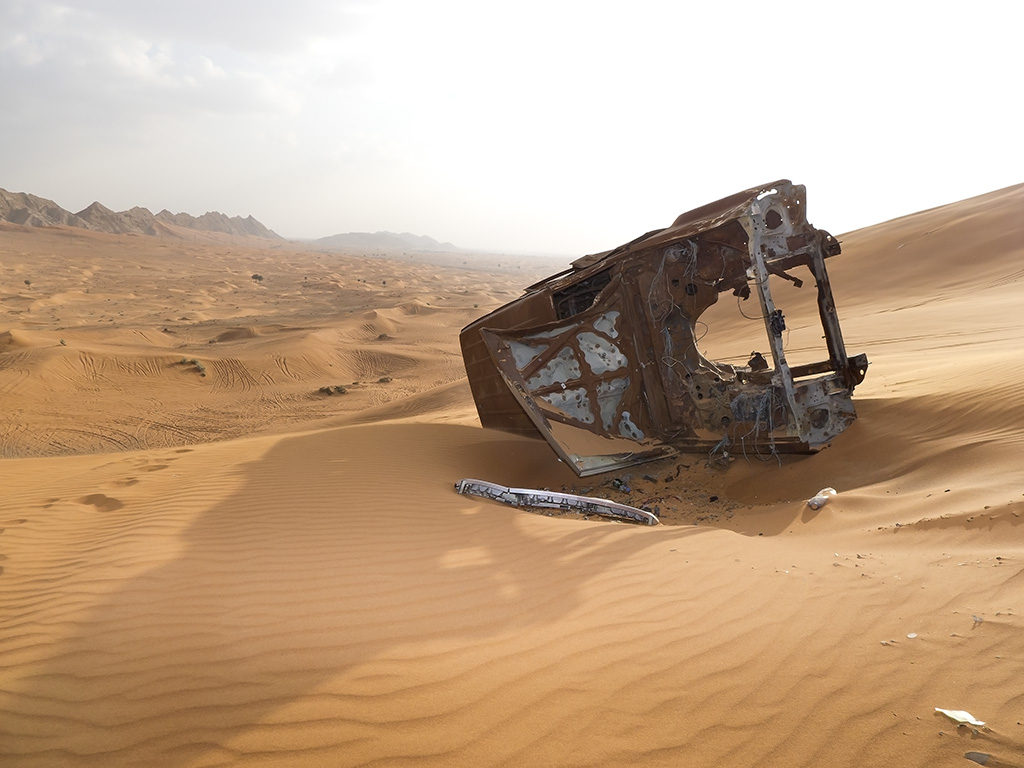
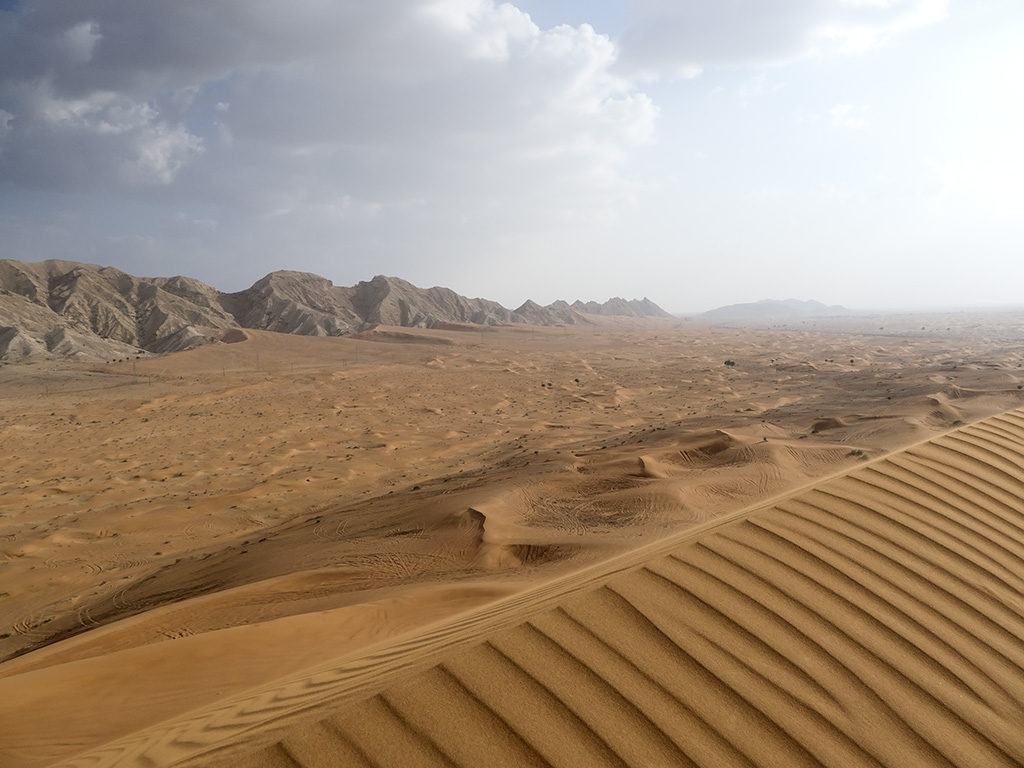
25°06’47.60” N – 55°49’29.02”E
Climb back up the dunes, and head up to the first rock formation at 25°07’01.70” N – 55°49’36.05”E.
25°06’47.60” N – 55°49’29.02”E
Keep driving through the dunes towards the second rock formation at 25°07’21.97” N – 55°49’38.59”E.
25°08’07.04” N – 55°49’49.10”E
Next rock formation is called Camel Rock.
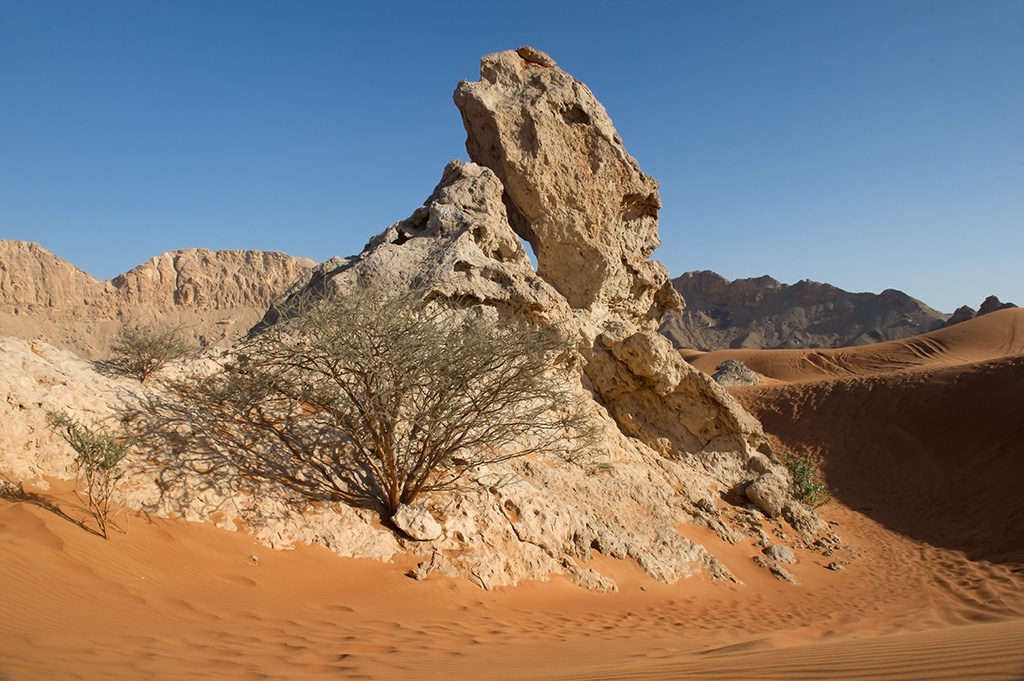
25°08’27.14” N – 55°50’02.62”E
Keep driving towards the large rock formation in front of you called Fossil Rock until you reach the noticeable track. Take left.
Caution.
When taking left you’re about to go down before climbing back up towards fossil rock pass. The climb back up isn’t easy for everyone. But the real challenge stands on the other side of the pass. That descent is really steep and shouldn’t be taken lightly. If you can’t climb up or don’t feel capable of going through the pass. Take right here and reach the bottom of the wadi safely.
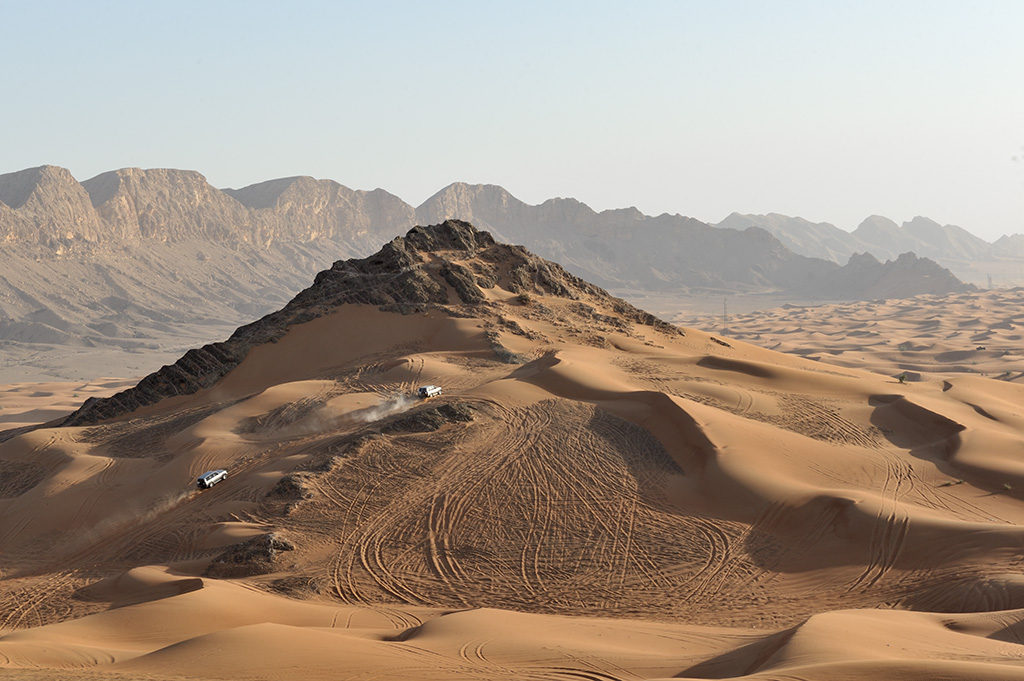
25°08’35.58” N – 55°49’55.36”E
Once down, take right and climb back up towards the Fossil rock pass.
25°08’36.90” N – 55°50’06.78”E
You’re now standing on top of the pass. The drive down is very steep and requires caution. Once down aim towards the houses on your right at 25°08’12.90” N – 55°50’53.67”E. There keep straight on the tarmac on the side of the wall.
Caution.
Again, if you’re having second thoughts about the descent, turn around and get back to 25°08’27.14” N – 55°50’02.62”E. Where you’ll go safely down towards the bottom of the wadi.
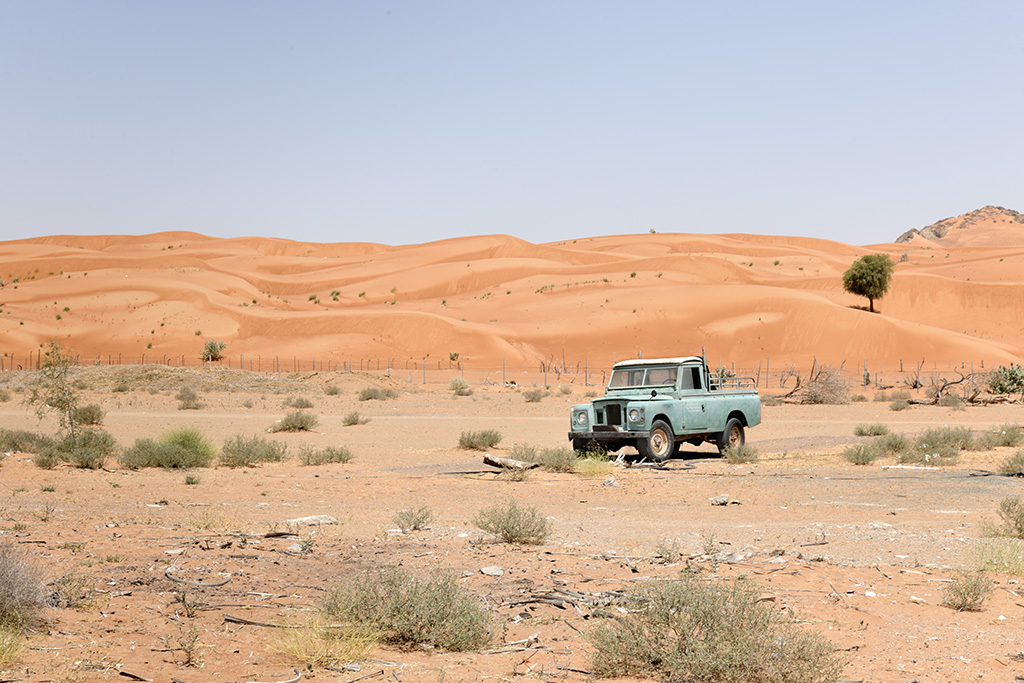
25°07’57.08” N – 55°50’54.91”E
Take left and immediately right on dirt track. You’re now driving following the signs towards the Mleiha Archeological Center at 25°07’35.69” N – 55°51’27.56”E. Take the time to visit the museum and the related sites around as it is very informative in regards to the historical meaning of this location. It should take two hours if done right. The Museum has bathrooms and a coffee shop.
As you leave the Museum and its surrounding attractions, drive towards the road E55 at 25°07’41.55” N – 55°52’45.53”E. Take left. In town you will find markets and gas stations.
25°08’05.69” N – 55°52’59.33”E
At the round-about keep straight. On your right is a local super-market for food and water. Refill if you need it.
25°08’11.77” N – 55°53’04.12”E
ADNOC gas station. Refill.
25°08’31.96” N – 55°53’16.15”E
At the round about keep straight. Pass above the road E102 and at the second round-about on the other side keep straight on Road E55.
25°09’39.22” N – 55°53’59.73”E
Take the exit to the round-about. And drive through the underpass. Once on the other side keep straight.
25°09’49.91” N – 55°53’47.17”E
At the round-about keep straight.
25°09’49.91” N – 55°53’47.17”E
At the round about keep straight on tarmac till next round-about. There take first exit on opposite side and enter the desert track. Head straight.
25°10’27.03” N – 55°52’40.33”E
Take right at the junction and follow the desert track towards the pylons.
25°10’58.01” N – 55°52’34.58”E
At the Pylons, take left on the Pylon track.
25°12’10.55” N – 55°50’25.98”E
As the pylons merge into another Pylon lane, head straight onto the dunes for another great desert drive through the sand. You’ll need to make you’re own trace through the dunes.
25°13’04.00” N – 55°48’42.38”E
Go around left the trees and farms towards 25°14’46.59” N – 55°48’01.16”E. And look for a place to camp for the night.
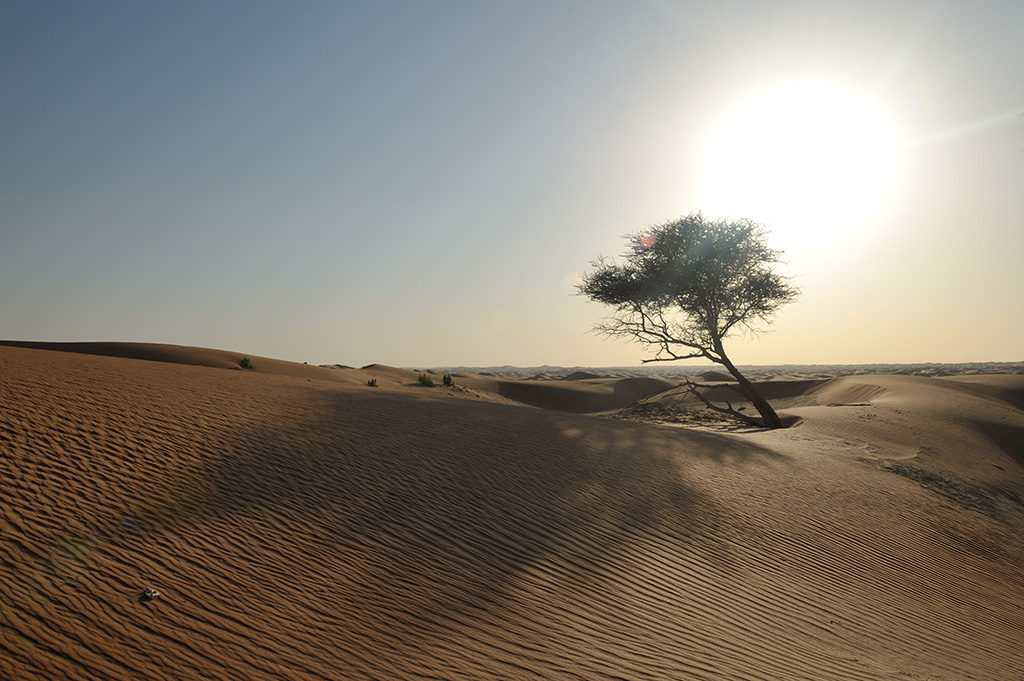
End of Day 1.
Day Two
Mleiha to Al Wadi Desert Resort
42 km.
Introduction.
Second day in the desert through some fantastic dunes in Sharjah and Umm al Quwain. The drive is short, especially if you stick to the desert track sections. However I advise you to leave the track and explore the fantastic dunes of Umm al Quwain which offers some of the best dune bashing spots in the Emirates outside of Liwa. When doing so you’ll realize that 42 kms through those technical dunes is more than enough for one day.
Your evening will be spent at the Al Wadi Resort. A fabulous Ritz-Carlton hotel nested in the middle of dunes and surrounded by wildlife. Make sure to reserve in advance. For those on a tighter budget, the surrounding dunes offer amazing campsite options.
Recommendations.
Keep your tires at 15 psi. You just filled up in Mleiha so you shouldn’t worry about running out today. However if you engage in intense off-roading, there is a gas station for you 25°20’50.48” N – 55°51’13.04”E half-way through in Falaj Al Moalla.
The drive.
Starting Point.
From wherever you decided to camp last night, you should aim for 25°15’00.83” N – 55°47’59.16”E where you’ll cross the tracks and keep driving through the dunes aiming towards 25°16’31.90” N – 55°49’08.23”E.
25°16’31.90” N – 55°49’08.23”E
Get on the round-about, go over the bridge towards the next round-about and exit straight on the other side for your next dune section.
25°16’44.09” N – 55°49’06.63”E
Another trackless dune section leading to Al Biyatha.
Here are the reference waypoints along the way:
25°17’04.89” N – 55°49’10.72”E
25°17’24.55” N – 55°49’12.95”E
25°19’15.77” N – 55°50’06.27”E
Cross the track under the pylons.
25°19’45.93” N – 55°49’46.44”E
25°19’55.30” N – 55°49’42.75”E
25°20’07.80” N – 55°49’41.49”E
25°20’27.55” N – 55°49’27.98”E
25°20’36.00” N – 55°49’24.72”E
25°20’43.96” N – 55°49’10.23”E
25°21’04.32” N – 55°48’48.52”E
25°22’12.05” N – 55°48’29.05”E
25°24’05.41” N – 55°48’09.59”E
From here you need to reach the road in front of you on the other side of the wadi and reach the underpass at 25°24’25.69” N – 55°48’10.40”E.
Once on the other side of the road, follow the dirt track and drive behind the hamlet Al Biyatha all the way to the other side of town at 25°25’01.59” N – 55°47’51.37”E. Where you’ll turn right and follow the track as it curves left toward the desert.

Here you have two options. Either follow the desert track and the listed waypoints below for a fairly easy drive, or head towards the dunes on either side and enjoy the rest of the day dune bashing through some very nice and seldom crossed sand dunes, before heading back to the Al Wadi Resort at 25°35’02.07” N – 55°50’07.38”E. Your choice.
25°25’12.35” N – 55°47’53.03”E
Keep straight on main track towards the pylon and follow it through those waypoints:
25°27’11.65” N – 55°48’23.92”E
25°28’29.27” N – 55°48’27.28”E
25°29’15.64” N – 55°48’45.66”E
25°30’28.09” N – 55°48’53.59”E
25°31’33.87” N – 55°49’24.63”E
Take left at the junction.
25°32’14.87” N – 55°49’36.16”E
Follow the track through the plantations.
25°32’46.29” N – 55°50’00.57”E
Get on the tarmac straight. You’re arriving at the Resort where you should spend the night. If you prefer a second night camping in the desert, get off the road and look for a camp spot near the hotel. (You can enjoy diner at the resort if you want)

25°35’02.07” N – 55°50’07.38”E
Ritz Carlton Al Wadi Desert Resort.
P.O. Box 35288
Al Mazraa
Ras Al Khaimah, United Arab Emirates
+971 7206 7777
End of day two.`
Day Three
Al Wadi Desert Resort to Fayyad
213 km.
Introduction.
Today we leave the desert behind and enter the Emirati side of the Al Hajar mountains. Along the way we’ll pass through Wadi Ham, an ancient vital trade route between the East and West coasts of the Emirates. Protecting Wadi Ham still stand several forts worth visiting. The trail passes in front of the Masafi fort. To see the Fujairah and Bitnah forts, you’ll need to take the alternate path designed for that detour.
Recommendations.
Keep your tires at 15 psi while you are still in the desert, then bring them back to 25 psi, once you enter the mountains. Refill at the next gas station near Khatt, and again when you pass Masafi. The drive is an easy one, just check the weather as you do not want to enter the mountain wadii if the weather is menacing. Flash flood are a real risk here.
Today’s drive is longer than most, leave early to make sure you complete all of it. The driving being fairly easy, you shouldn’t feel stress about the distance.
The drive.
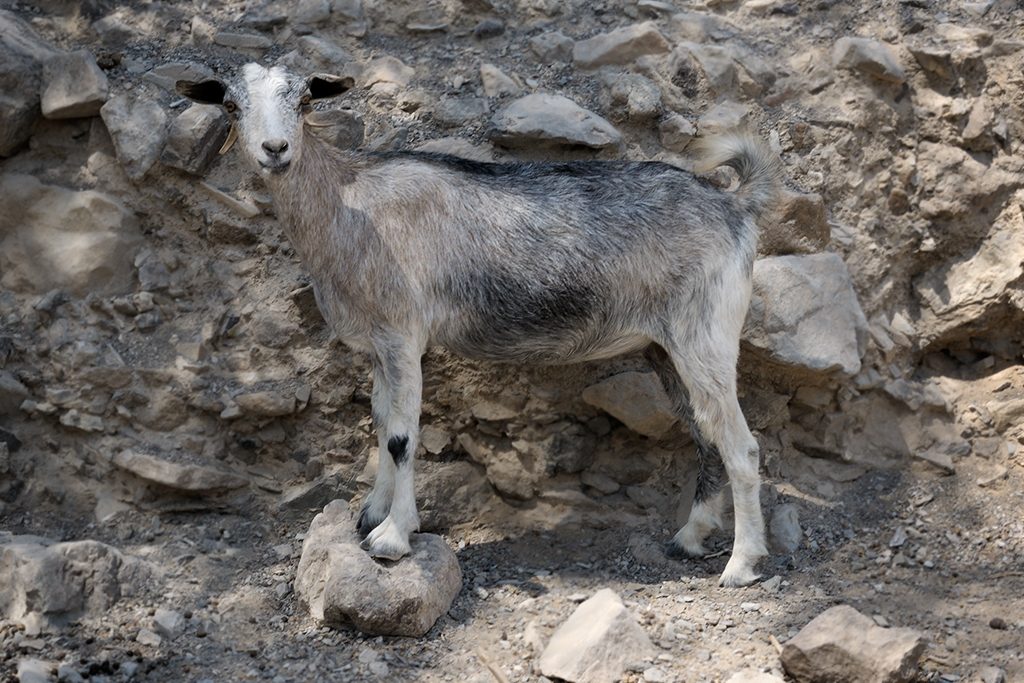
Starting Point.
25°35’02.07” N – 55°50’07.38”E
Leave the resort behind and follow the road East towards the main resort exit on the “truck road” (that’s the name of the road). Once at the main road proceed underneath the pass and at the round-about take the third exit left as if you were about to get on that road towards Ras Al Khaimah.
25°36’30.72” N – 55°51’18.51”E
Exit the tarmac and get on the desert track following the pylons. Follow the pylons all the way to the first group of houses.
25°38’09.81” N – 55°53’03.26”E
Turn right and go straight towards the road. At the road turn left and drive until you reach the camel track side road.
25°38’45.67” N – 55°54’05.28”E
Turn right and follow the road around the track. If you see camels training, stop and enjoy the sight.
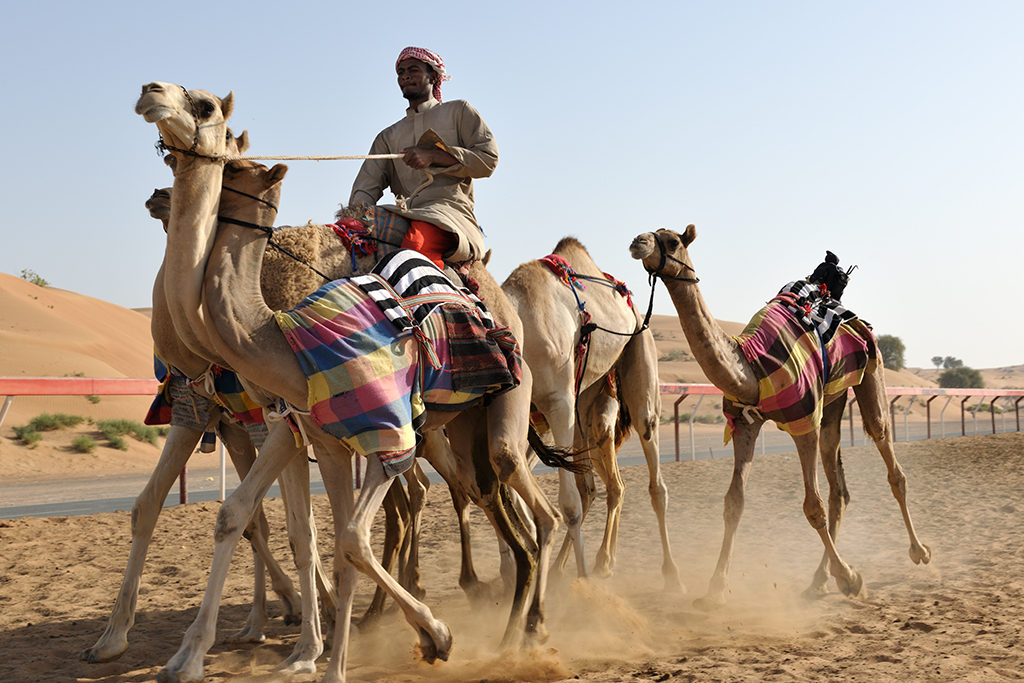
25°38’36.55” N – 55°55’07.88”E
Turn right at the junction.
25°38’15.73” N – 55°55’25.24”E
Turn left at the junction and keep on that street until you reach the main Road E18.
25°38’34.16” N – 55°57’15.26”E
Turn right on E18.
25°37’19.62” N – 55°56’39.50”E
At the round-about take left.
25°36’48.61” N – 55°58’13.80”E
On the other side of the road is a gas station. Go to the next round-about, make a u-turn and come back to fill up. Also bring your tires back to 25 psi as you are done with the desert. Once done go make another you turn to get back on the other side of the road.
25°36’45.46” N – 55°58’24.87”E
At the round-about take right. And keep driving on E18 till next round-about.
25°30’44.78” N – 55°59’25.01”E
At the round-about take the third exit left on E87.
25°30’44.89” N – 56°00’32.20”E
Engage in the U-turn pass and get on the dirt track left of the pylon. Then take the first right parallel to the road. You’re now entering the mountains. Keep going on that track through the first rocky hills.
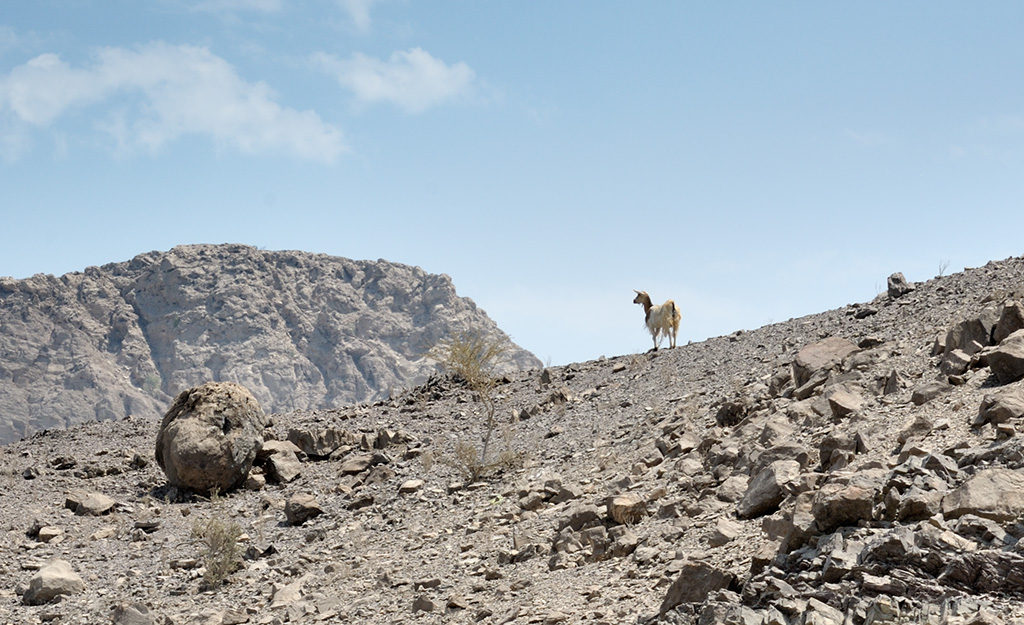
25°32’22.21” N – 56°02’31.24”E
Keep straight all the way to the road.
25°32’42.89” N – 56°02’35.67”E
Take left on the road, then right at the next junction and stay on that road.
25°33’49.46” N – 56°03’48.21”E
Leave the road for the dirt tack on the right.
25°33’44.08” N – 55°04’17.29”E
Keep straight at the track cross junction.
25°33’45.65” N – 56°04’35.63”E
Take right on the tarmac.
25°33’43.70” N – 56°04’42.86”E
At the junction keep straight. However, if you need anything, like gas, food, or water, take right and drive into town before coming back to this point.
25°33’36.66” N – 56°05’22.57”E
Turn left on the dirt track as you now enter wadi Khabb.
25°34’06.70” N – 56°06’48.46”E
Take left at the junction.
25°34’20.62” N – 56°07’22.85”E
Take left at the junction.
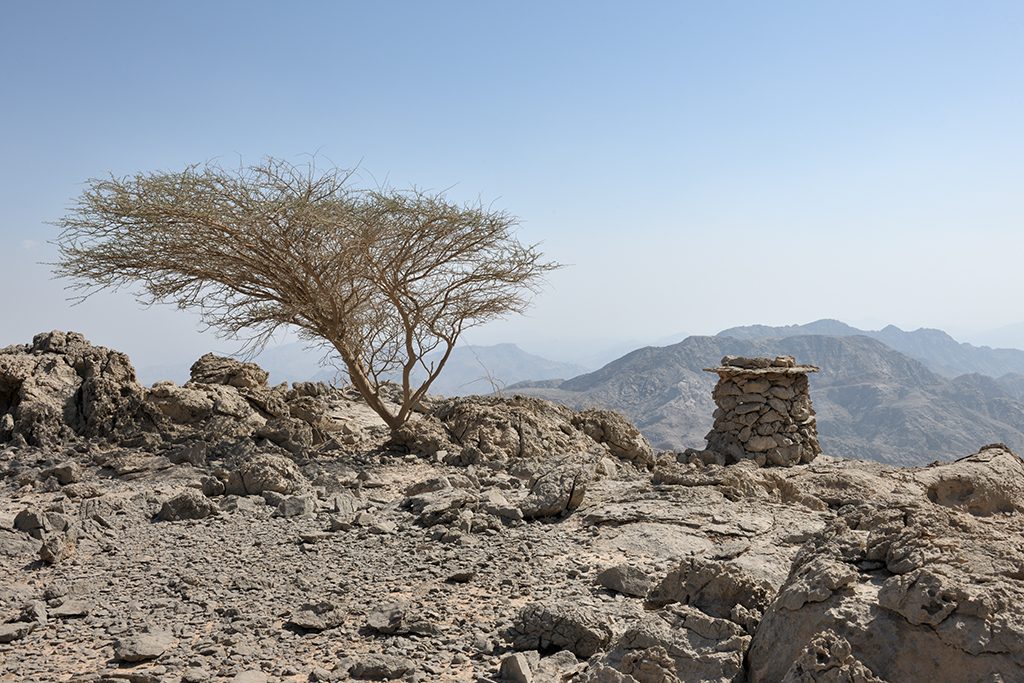
25°35’19.88” N – 56°08’26.59”E
Take right at the junction in front of the stone wall and enter wadi Shakhkh.
25°35’12.44” N – 56°08’32.76”E
Take right at the junction.
25°35’05.23” N – 56°08’19.83”E
Keep straight.
25°34’22.45” N – 56°07’54.27”E
Take right at the junction.
25°33’41.88” N – 56°08’22.08”E
Keep straight on the main track.
25°33’33.90” N – 56°08’15.25”E
Keep left on the main track.
25°32’01.12” N – 56°07’53.64”E
Get on the main road E87. No need to inflate your tires, the drive through the Aqabat al Qaliddi pass is short. Just drive with caution, put your hazards on and don’t go above 80km/h till you leave the highway at the next near exit.
25°31’44.75” N – 56°07’05.07”E
Get off the E87, and drive underneath to exit on the other side. Once out of the tunnel, take right at the first junction, and left at the second.
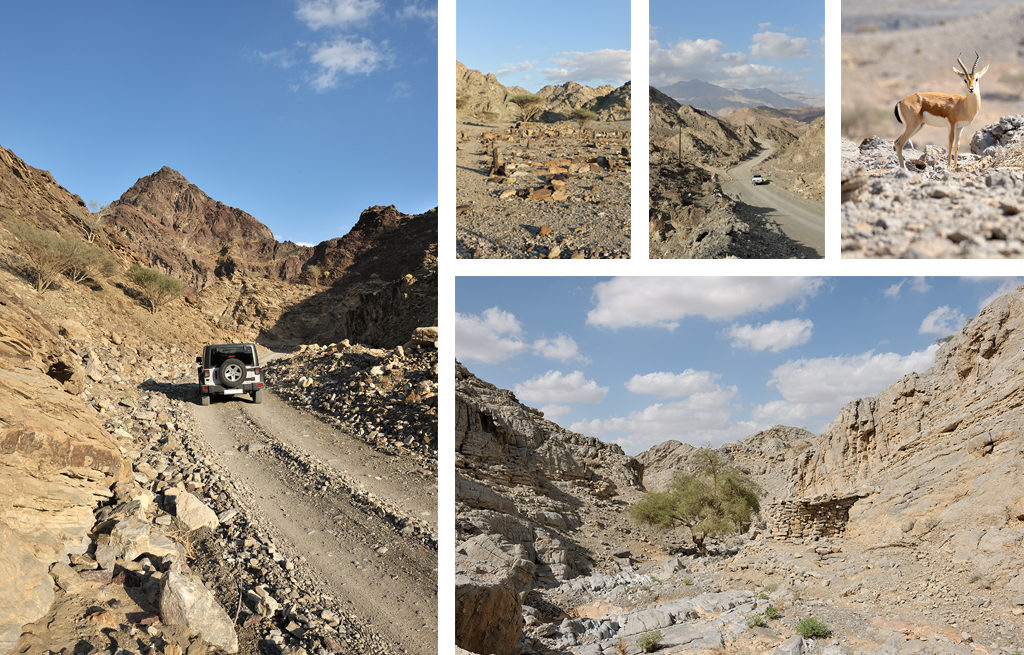
25°29’59.35” N – 56°07’50.23”E
At the junction take left towards the hamlet.
25°29’44.10” N – 56°07’56.71”E
At the junction, take left. Stay on the main track right as it climbs up, then back down towards Sinnah.
25°30’24.84” N – 56°10’05.16”E
Get on the tarmac road and follow it all the way to Emirates road 89.
25°29’27.64” N – 56°11’48.23”E
Turn right on E89. You’ll see a gas station on the other side of the road in a minute. Stop there if you need. For that you’ll have to use the U-turn section further along.
25°28’54.71” N – 56°11’27.10”E
Get off the E89 at the exit and drive on this road till the end at the entrance of wadi al Uyaynah.
25°27’15.75” N – 56°10’10.14”E
You’re about to enter a narrow wadi called wadi Al Uyaynah, and the follow up called wadi Abadilah. Do not proceed if the sky is menacing, those wadii are very narrow and subject to flash flood.
25°25’15.77” N – 56°09’59.69”E
Take left on the main track.
25°25’05.61” N – 56°10’00.13”E
Take left on the main track.
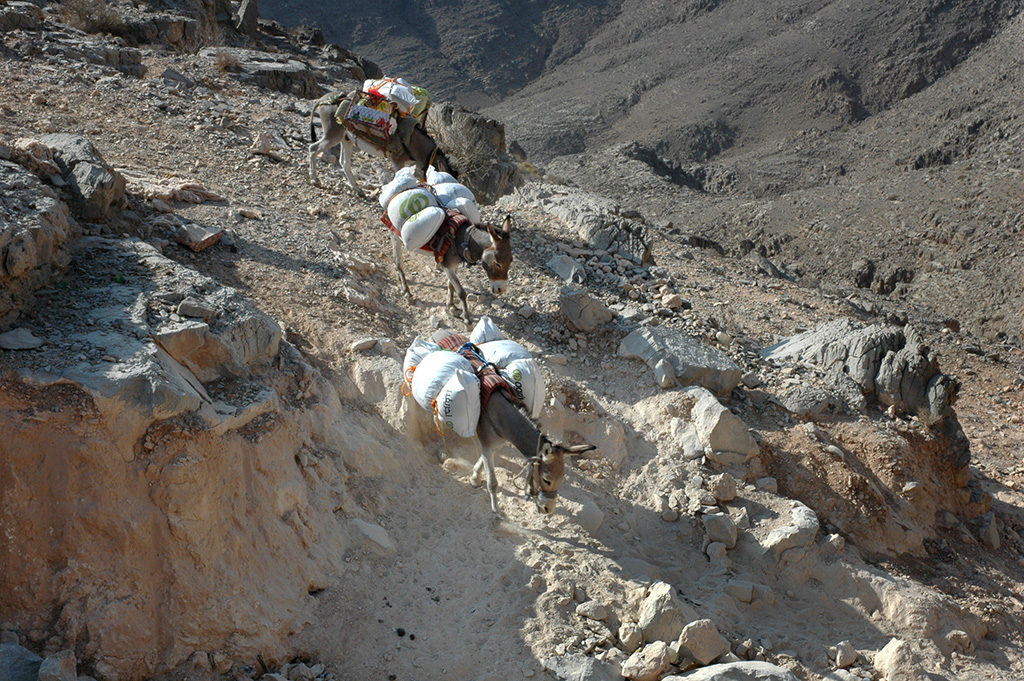
25°24’58.02” N – 56°10’02.00”E
Take left on the main track. As the wadi track turns into a village road, keep on it through the houses.
25°24’13.28” N – 56°10’03.80”E
Leave the road and enter the dirt track on your right.
25°24’15.68” N – 56°09’52.05”E
Take left at the junction, and keep right at the very next one.
25°24’18.11” N – 56°09’31.17”E
Cross the road and keep straight ahead on the dirt track.
25°24’17.28” N – 56°09’25.80”E
Take right at the Y junction.
25°24’18.66” N – 56°09’19.64”E
Keep straight at the junction and stay on that main track as it takes you to wadi Asimah.
25°23’56.58” N – 56°08’30.56”E
Take right at the junction and enter wadi Asimah. Same warning as before, do not enter if the sky is menacing, this wadi is subject to flash-floods.
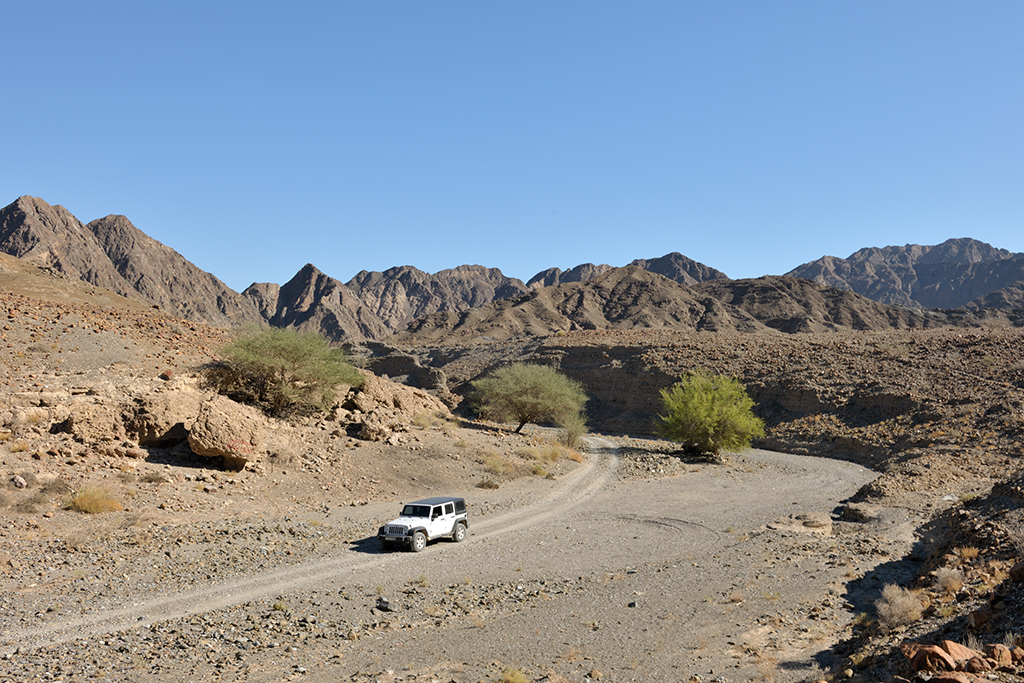
25°25’16.81” N – 56°05’48.55”E
Keep left at the junction.
25°24’26.54” N – 56°03’53.88”E
You’ve reach the end of the wadi. At this cross junction, take right.
25°24’20.00” N – 56°04’01.00”E
At the junction take left.
25°24’11.52” N – 56°04’12.01”E
At the junction, take right.
25°24’00.87” N – 56°04’03.75”E
At the junction, take right.
25°23’56.02” N – 56°04’00.26”E
At the junction, keep straight.
25°23’49.66” N – 56°03’57.61”E
At the junction, take right.
25°23’43.98” N – 56°03’33.16”E
Take left on the road.
25°23’31.62” N – 56°03’41.15”E
Keep straight as the road turns to dirt.
25°23’17.90” N – 56°03’43.72”E
At the junction, keep right. Same for the next one coming.

25°22’24.49” N – 56°02’08.13”E
At the junction, take left.
25°22’20.69” N – 56°02’11.72”E
At the junction, take right.
25°21’47.44” N – 56°02’33.52”E
At the junction, take left, then right at the following.
25°21’38.96” N – 56°02’38.96”E
At the junction, keep straight.
25°21’15.63” N – 56°02’34.64”E
Leave the road and take left on the dirt track as it follows the shooting range fence, before entering the wadi.
25°21’01.43” N – 56°05’16.30”E
At the junction, take left and keep going on the main track till you reach the road.
25°20’11.31” N – 56°06’24.63”E
At the road junction, take right and drive all the way to the next round-about.
25°19’36.42” N – 56°08’02.69”E
At the round-about keep straight.
25°19’41.76” N – 56°08’31.88”E
Leave the road and engage on the dirt track on your right.
25°19’50.09” N – 56°08’45.45”E
Take right at the junction.
25°19’46.40” N – 56°08’53.85”E
Turn right and drive down towards the wadi bed. Drive with caution as the descent is very rocky. Inside the wadi bed the track is faint but the direction is obvious. It then becomes more obvious and leads you all the way to Masafi.
25°18’17.75” N – 56°09’14.85”E
At the junction stay right. At the next junction following up take straight in the middle.
25°18’17.40” N – 56°09’22.33”E
Take right at the junction.
25°18’08.25” N – 56°09’34.58”E
Newly restored Masafi fort and mosque. Someone is usually on site to give you a “tour” if you care. A tip is always welcomed.

25°18’05.83” N – 56°09’40.07”E
Turn right at intersection, and drive towards the main road ahead.
25°17’57.95” N – 56°09’38.64”E
Your are now in Masafi center. Two options here. Either take right and drive down towards the Friday market, where you’ll find a gas station and further on a fresh produce market. Or take left and follow on the trail. We strongly advise you to go refill down the road, before coming back to this point, as this is your last gas station and market for the day.
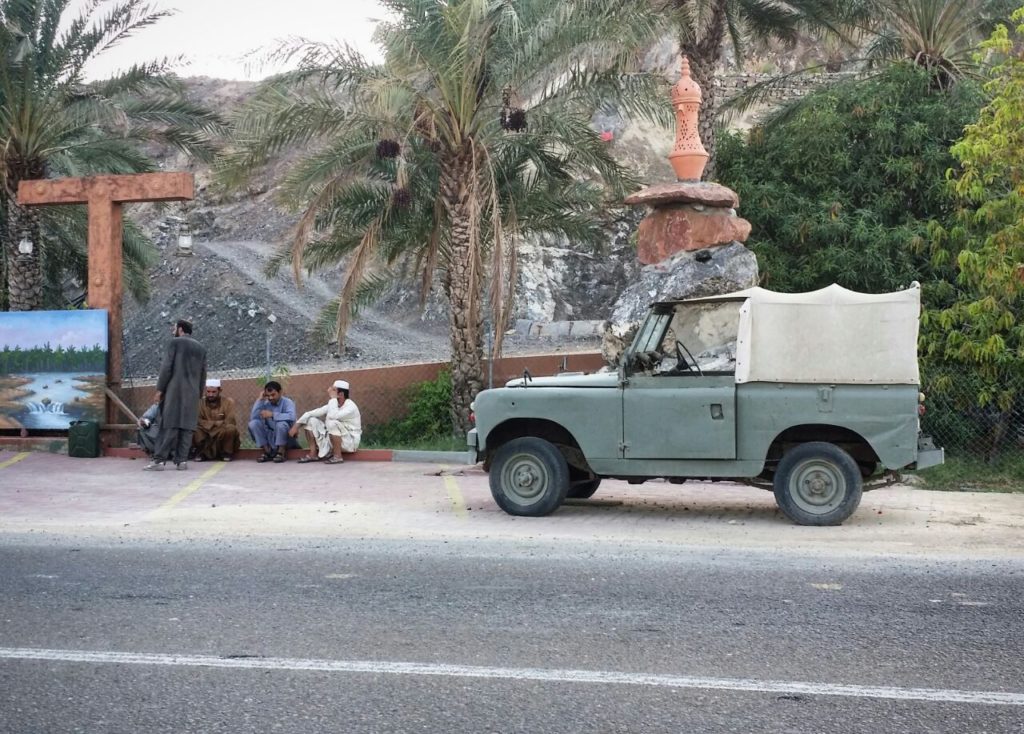
25°17’58.06” N – 56°09’57.45”E
At the round-about take the first exit on your right on E 89 towards Fujairah.
25°16’08.67” N – 56°10’18.17”E
Two options again.
Either get off the main road right before the bridge and drive down towards the wadi below to stay on the main trail, or stay on the main road and start the alternate path HT-D3-AP1 taking you to the Bitnah and Fujairah forts down the road before catching up with the trail further along.
HT-D3-AP1
Stay on E89 as you are now and drive to Bitnah.
25°11’27.17” N – 56°13’53.44”E
Leave E89 and take left as you enter Bitnah.
25°11’28.99” N – 56°13’55.91”E
Take right, then left at the next section. Follow that dirt track as it curves right towards the bottom of the wadi. Once in the wadi, follow the track as it leads you to the castle.
25°11’12.03” N – 56°14’16.17”E
The Bitnah fort.
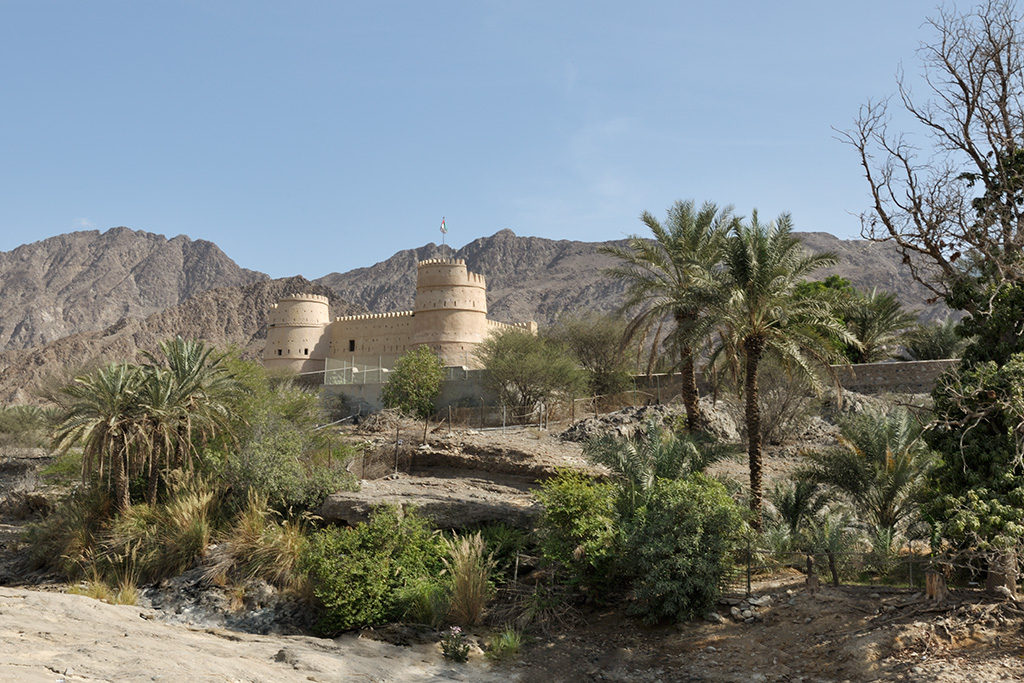
Once done with the visit, Keep going on the track in the same direction South, as it leads you back to the wadi ahead.
25°10’43.27” N – 56°14’02.97”E
Follow the track right as it exits the wadi and brings you back to the road.
25°10’42.52” N – 56°13’55.81”E
Take left then right on the E89. Drive all the way up to the next U-turn option. Turn around then head down to Fujairah.
25°08’35.81” N – 56°16’38.54”E
Take second exit – straight – at round-about.
25°07’33.57” N – 56°17’51.67”E
Take third exit – left – at round-about.
25°07’48.05” N – 56°18’07.17”E
Take first exit – right – at round-about.
25°07’47.83” N – 56°19’00.19”E
Take second exit – left – at round-about, and keep straight at the next one.
25°08’26.66” N – 56°19’45.00”E
Take right at the T-Junction.
25°08’10.23” N – 56°20’03.51”E
Take fourth exit at the round about. The Fujairah fort is then on your right.
Once done with the visit, get back to this round-about and take the second exit.
25°07’47.32” N – 56°19’36.92”E
At the round-about go straight.
25°07’21.38” N – 56°19’05.29”E
Take second exit at round-about and keep straight on E84.
25°09’49.11” N – 56°08’24.28”E
Exit E84. You’re now back on the main trail. Click here to catch up to the corresponding way-points.
Main trail
25°16’08.67” N – 56°10’18.17”E
Get off the main road right before the bridge and drive down towards the wadi below.
25°16’01.60” N – 56°10’19.49”E
Keep straight.
25°15’53.36” N – 56°10’17.61”E
Keep right at junction.
25°15’50.46” N – 56°10’11.25”E
Take left at junction.
25°15’33.89” N – 56°10’05.52”E
Keep straight at the junction. Stay on main track as few tracks will branch out to pylons along the way.
25°15’17.90” N – 56°09’13.89”E
Keep left at junction.
25°14’59.21” N – 56°08’51.66”E
Take left at junction.
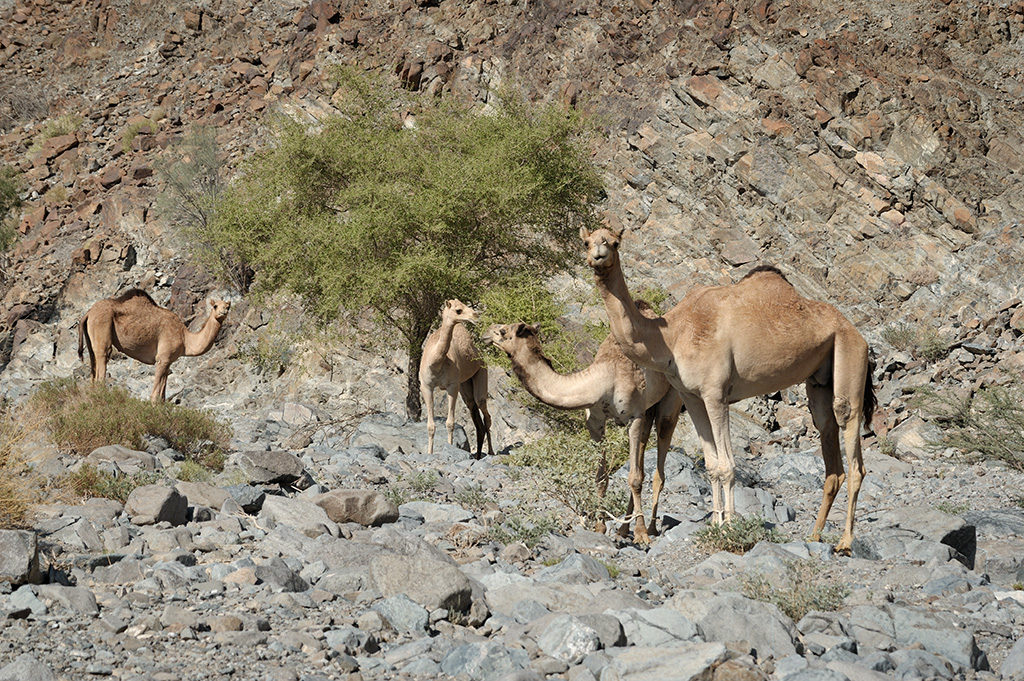
25°14’10.05” N – 56°08’11.91”E
Take left at the junction.
25°14’02.91” N – 56°08’08.86”E
Take right on the road and stay on it.
25°13’40.31” N – 56°06’55.14”E
Take left at the junction.
25°12’54.14” N – 56°06’50.29”E
You’re now facing the entrance of a Quarry. You need to branch out on the very faint and very rocky track on the right. It may look edgy, but was still very negotiable last time I passed. Drive with caution as it gets back to normal quickly.
If it is no longer an option, get back to the last intersection you just left and take left. Then take left again at the next T-Junction. Pass the next quarry entry on your left, and turn left at the next T-junction. Turn left again on the dirt track following the pipeline (before the pylon) and meet the trail back at 25°11’29.15” N – 56°07’38.22”E.
25°12’41.11” N – 56°06’54.76”E
Take left at the junction.
25°12’20.84” N – 56°07’08.46”E
Take right at the junction.
25°11’29.15” N – 56°07’38.22”E
Keep straight across the pipeline.
25°11’21.23” N – 56°07’41.17”E
Take left at the junction.
25°11’23.02” N – 56°07’47.21”E
Take right at the junction.
25°11’19.95” N – 56°07’48.88”E
Take left at the junction.
25°11’25.52” N – 56°08’13.79”E
Cross the pipeline again.
25°11’25.44” N – 56°08’32.61”E
Cross the pipeline again.
25°11’31.23” N – 56°09’17.45”E
Stay on the right side of the pipeline.
25°11’29.00” N – 56°09’39.58”E
Cross the pipeline again, and follow the track up the hill.
25°11’33.05” N – 56°10’21.00”E
Stay left at the pass junction and prepare for the downhill coming up. Stay on that main track all the way down.
25°11’45.80” N – 56°11’02.91”E
Cross the pipeline now, do not take the first tack on the left, instead cross and take the track reaching down the farm ahead.
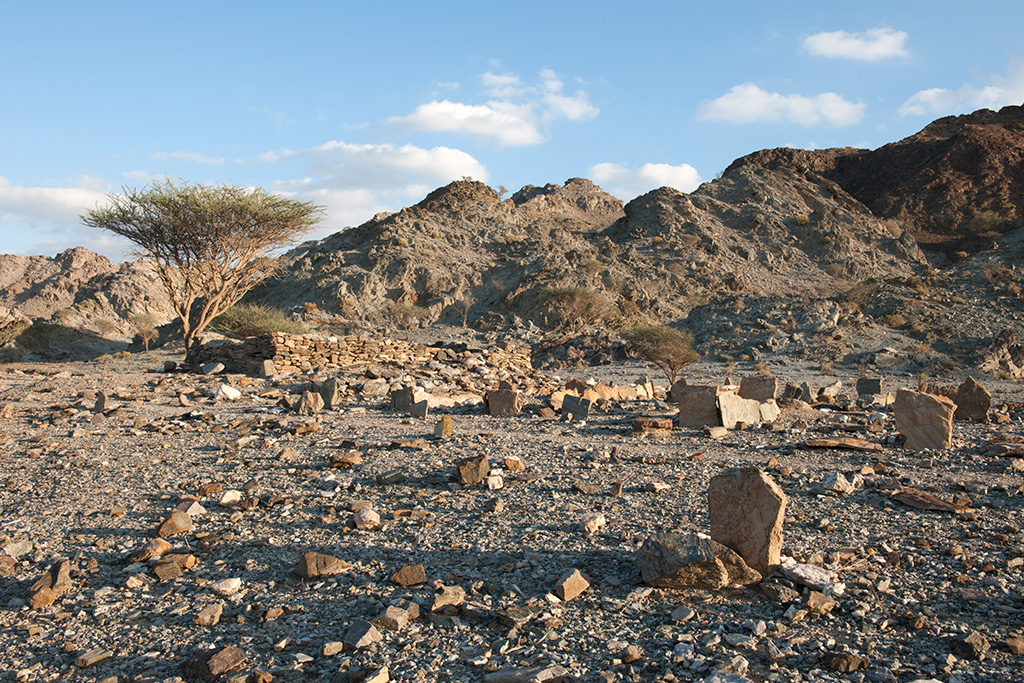
25°11’46.62” N – 56°11’26.91”E
At the junction take right, and follow the wadi track.
25°09’17.70” N – 56°12’47.80”E
Take left at the junction.
25°09’00.45” N – 56°13’22.61”E
At the junction, take right.
25°08’53.93” N – 56°13’24.38”E
Turn left on the road as it takes you to E84. Once at the round-about take the first exit right and get on the highway. Because your tires are on low pressure, keep our emergency signals on and do not speed above 80km/h for the short distance you have to travel.
25°09’49.11” N – 56°08’24.28”E
Exit E84. At the first round-about take the third exit and pass underneath the highway. At the next round-about take the second exit.
25°09’39.63” N – 56°08’19.86”E
Take left at the junction and keep parallel to the highway.
25°09’11.28” N – 56°06’20.54”E
As you get to the road, take left and keep driving on that road.
25°06’36.92” N – 56°08’15.21”E
Leave the road and take right on the dirt track. Keep right as two smaller tracks on your left lead to houses (One before and a-one just after the wadi bed) From there keep on the main and obvious track as it climbs up.
25°05’44.39” N – 56°07’37.55”E
Take left at the junction and cross the wadi bed. Keep on the main track as it follows the wadi bed and ultimately turns into a road.
25°01’05.33” N – 56°09’37.40”E
Get off the road as you take the dirt track on your left, and immediately branch out on your right.
25°00’30.04” N – 56°10’04.00”E
Turn right, cross the wadi bed and enter the terrace plantation fields. This is your campsite for the night. If you want more privacy away from the main track, drive up the valley on your left.
There are no hotel or restaurants or market near you unless you drive all the way down to Hatta.
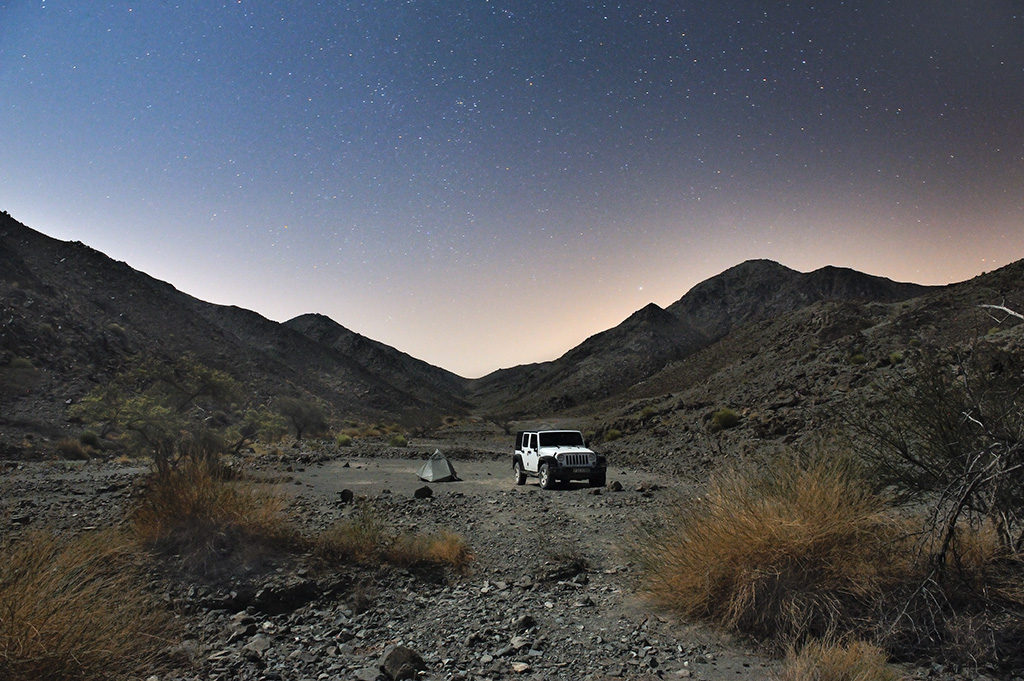
End of day 3.
Day Four
Fayyad to Qubur Zalim
201 km.
Introduction.
Today we enter the Sultanate of Oman. With a short detour on the edges of the Batinah plain, we’ll be able to see a couple of interesting forts before reaching a stunning campsite.
Recommendations.
The first part of the drive is on tarmac. You should re-inflate your tires to their normal pressure as you reach Road E102. Once off the road on the other side of the border, bring back your tires to 25 psi.
Today’s drive is fairly easy technically, but will need you to focus on navigation as the trails become very faint in some wadi sections.
Again, no hotel options today.
Make sure to refill for gas when you can and get all the food and water you need for the next couple of days when passing through Hatta. You need to have a minimum 500 km of gas autonomy as there will be no near by gas stations before the end of day Five near Bat.
The drive.
Starting Point.
25°00’30.04” N – 56°10’04.00”E
Leave the campsite and cross the wadi to get back on the main track where you left it last night. Turn right and follow the wadi all the way until it turns into a road. Once on tarmac keep straight on it until you reach E 102.
24°57’30.07” N – 56°08’53.94”E
Exit the E102, get on the bridge and pass over. Exit the round-about straight on the other side. That road will take you all the way to the E44 Hatta road.
24°53’07.46” N – 56°10’11.42”E
At the round-about take right. You can refill at the gas station on your right or wait until you reach Hatta a bit later. You can also wait until you cross into Oman. However, if you are driving a Diesel, pending further changes, it is now more expansive to fill up in Oman.
24°49’07.92” N – 56°08’32.87”E
You have reached the E44 that will take you to the Oman Border.
Now, I advise you to take right and drive to the town center where you’ll find a nice supermarket to get new food and refill your tank if you need.
You may also want to have a look at the Hatta dam.
Once done, come back to this point and drive to the border.
24°48’24.09” N – 56°12’04.97”E
UAE Border.
24°48’03.57” N – 56°12’50.71”E
Your first Oman gas stations.
24°47’04.81” N – 56°17’46.53”E
Oman Border.
24°47’11.21” N – 56°21’35.12”E
Leave Oman Road 5 and take right on new freeway.
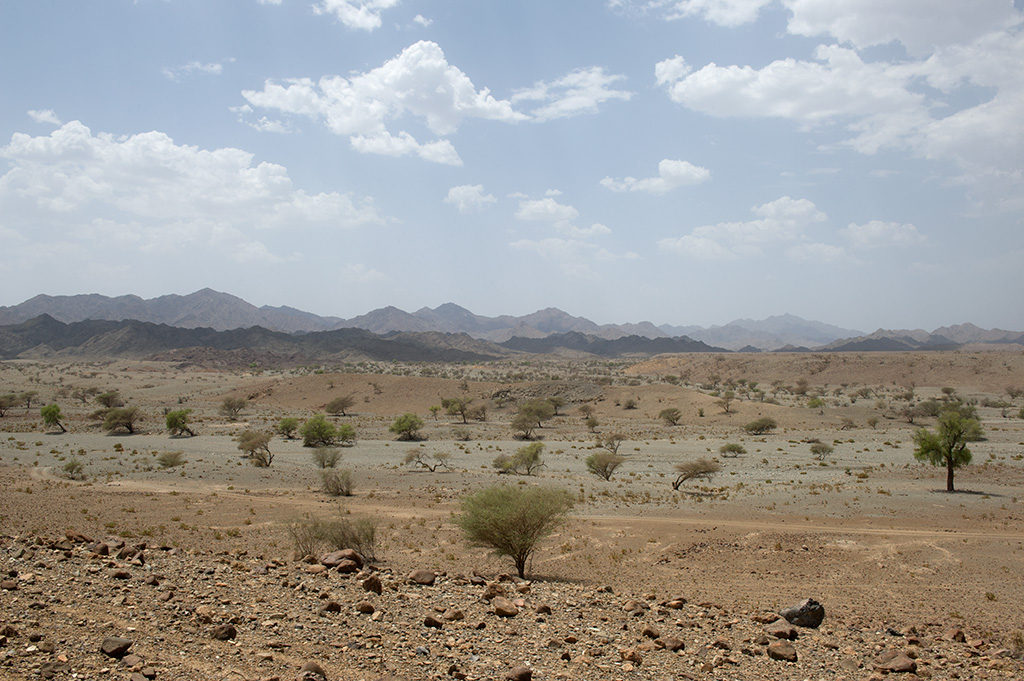
24°38’12.51” N – 56°25’16.27”E
Exit the freeway and take right at the round-about. Stay on that road till you reach Al Misdar.
24°37’07.93” N – 56°22’02.45”E
Take left. As you reach the houses turn left again and go to the edge of the hamlet. There take right on the dirt track as it goes around the hamlet and follow it towards the wadi bed. Time to lower your tire pressure again. Cross the wadi.
24°36’41.86” N – 56°21’51.91”E
Leave the wadi bed here and climb back up on this small track.
24°36’30.74” N – 56°21’52.70”E
Keep straight on the fainted track in the middle.
24°36’24.09” N – 56°21’54.68”E
Take left on the even smaller track as it goes down towards the wadi bed. As you reach the wadi bed, take right and follow it. The track may be hard to see at times and from now on it will feel like you’re really off-roading. Drive with caution and trust your vehicle.
24°36’07.84” N – 56°21’55.07”E
At this point the track becomes a bit more obvious. Just follow through.
24°35’54.95” N – 56°21’50.17”E
Re-entering the wadi bed as the track crosses it. Our exit point is at 24°35’47.05” N – 56°21’48.55”E. From here the track is obvious again. Follow through.
24°35’24.25” N – 56°22’02.23”E
As you reach the dirt road, turn right.
24°34’58.75” N – 56°21’11.26”E
Leave the main dirt road for the small track on your left.
24°34’42.66” N – 56°21’10.29”E
At the junction stay right all the way to the wadi bed. Enter the wadi and turn left. There is no real track inside the wadi, as water runs erase tire marks. Just drive with caution through rocks and peddles. If lucky you’ll see a faint track in there. Just follow it. If not this is what we call off-roading. If there is water in, just check how deep it is before you enter.
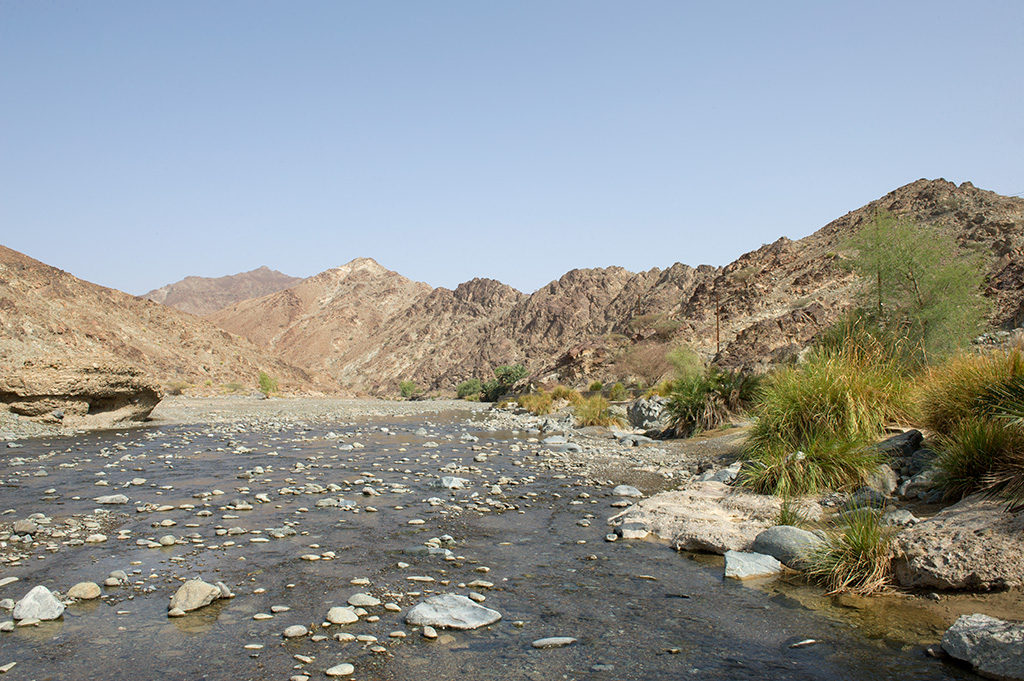
24°34’11.96” N – 56°21’32.93”E
Exit the wadi here. There is a very small “track” (tire marks) going up here before crossing a smaller wadi and going up again. The track becomes obvious shortly after.
24°33’49.75” N – 56°21’44.18”E
As you reach this new track merging with the one you are on, keep right as you will soon pass an old copper mine on your left.
24°33’08.01” N – 56°22’15.20”E
Cross the small wadi here.
24°33’01.70” N – 56°22’22.58”E
Turn right as the track follows the wadi bed for a little while before reaching down.
24°32’56.25” N – 56°21’29.98”E
Take the wadi bed on the left and pass in front of the houses.
24°32’31.46” N – 56°20’29.87”E
Take left at the junction.
24°30’47.74” N – 56°21’20.40”E
You’ve reach a hamlet and a road. Take left on that road.
24°30’42.89” N – 56°22’10.85”E
At the T-junction take right and stay on that road.
24°30’20.60” N – 56°25’17.54”E
At the T-junction take left to go see the Fazah fort further down the road. 24°30’31.67” N – 56°26’48.04”E
Once done with the visit come back to this point and keep going straight. (equivalent of turning right now if you don’t feel like going for the visit)
24°27’54.20” N – 56°23’44.89”E
Take left at the Y-Junction and keep on that main track.
24°26’52.03” N – 56°24’08.64”E
Take right at the Y-Junction.
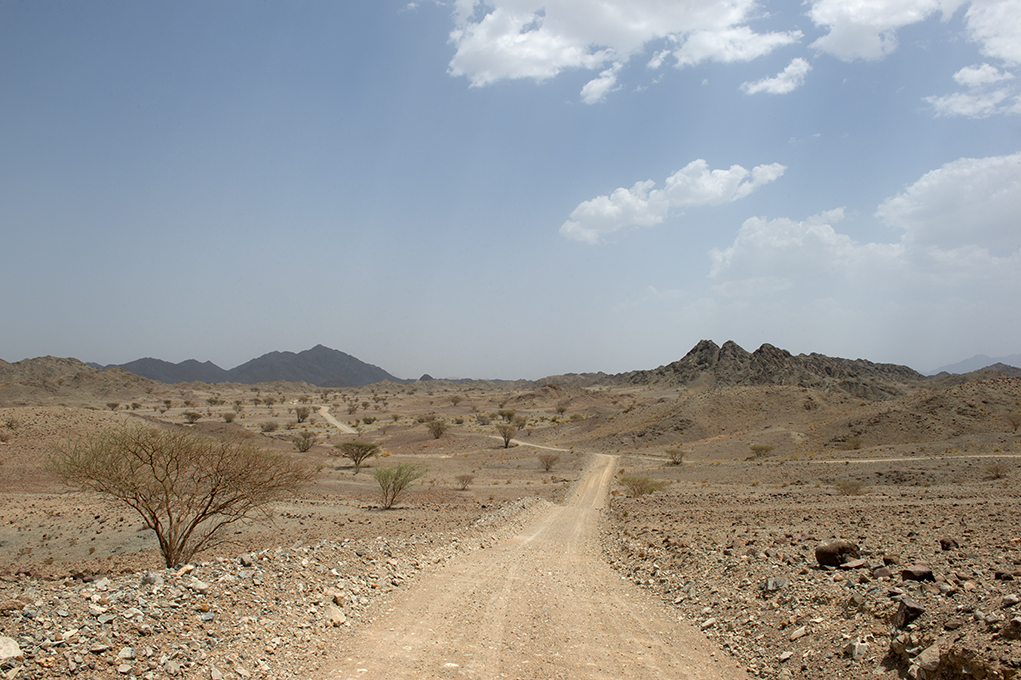
24°26’44.57” N – 56°24’07.52”E
Take left at the Y-Junction and left again at the following one. Keep then on that main track.
24°25’54.48” N – 56°24’03.43”E
Pass the houses on their left.
24°25’39.67” N – 56°23’45.18”E
Take left at the Y-Junction.
24°24’40.29” N – 56°23’29.51”E
Take left at the junction as you enter the wadi bed. Follow the track inside the wadi.
24°24’28.74” N – 56°24’19.27”E
Follow the main track as it exit the wadi bed.
24°24’10.92” N – 56°24’46.65”E
Take right at the junction, then left at the next, then right at the one after. Keep on the main track as you pass the houses.
24°23’09.52” N – 56°24’05.40”E
Keep straight.
24°21’24.27” N – 56°22’28.78”E
Take left, then right at the junctions and drive up towards the main road ahead.
24°20’57.31” N – 56°22’49.65”E
You’ve reached the road, take left.

24°20’02.25” N – 56°24’26.52”E
Take right at the cross road.
24°19’46.57” N – 56°24’25.92”E
Keep straight.
24°18’43.60” N – 56°24’51.95”E
Leave the tarmac and take the dirt track on your right.
24°18’29.71” N – 56°24’32.88”E
Take left at the junction and follow the track as it follows the pylons on your left.
24°17’30.39” N – 56°23’02.85”E
Take left at junction.
24°17’03.78” N – 56°23’27.58”E
Take right at junction.
24°17’00.97” N – 56°22’22.04”E
Take left at the junction.
24°16’42.94” N – 56°22’26.18”E
Take left at the junction.
24°16’42.29” N – 56°22’36.23”E
Take left and cross the wadi. Climb up towards the road.
24°16’40.56” N – 56°22’46.13”E
Take right on the road.
24°16’17.98” N – 56°22 ‘31.20”E
Take right here onto the dirt track. Then take immediately left, climb up and follow the pylons towards the Suhaylah Fort. Once at the fort 24°15’50.82” N – 56°21’40.22”E park and have a look around.
Once done go back the way you came towards the road. As you reach the road, turn left and follow that road until your reach Highway 7.
24°17’17.49” N – 56°25’01.84”E
Take right and take the under pass.
24°17’19.85” N – 56°25’11.21”E
Take right.
24°16’58.85” N – 56°25’34.26”E
Take right.
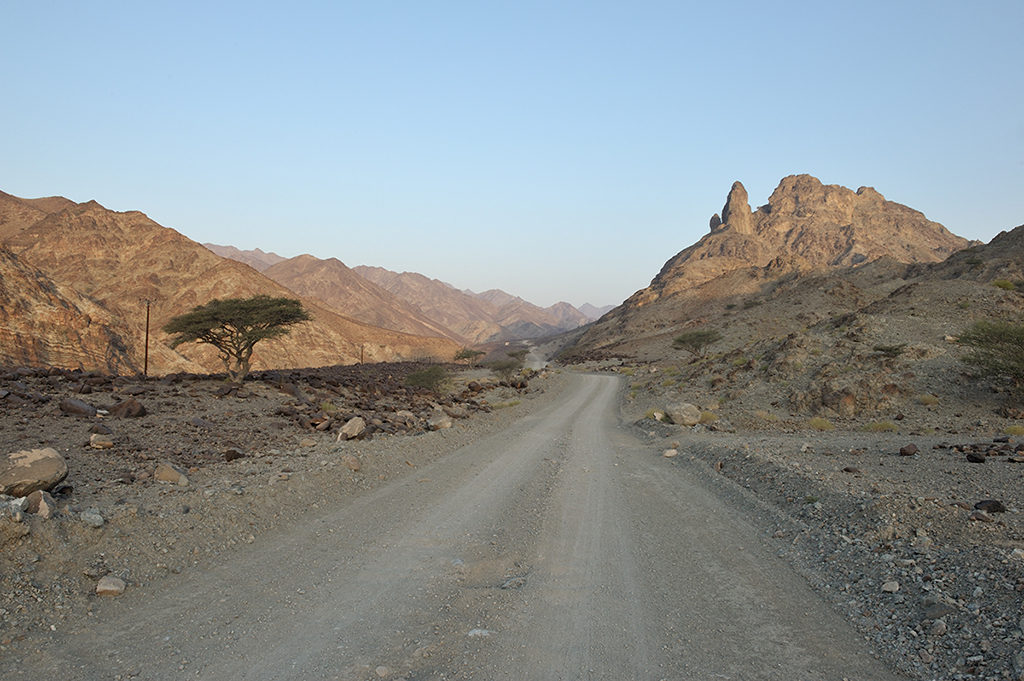
24°16’55.31” N – 56°25’25.04”E
Keep straight.
24°16’46.98” N – 56°24’57.28”E
Keep straight.
24°16’41.42” N – 56°24’32.41”E
Keep straight.
24°15’55.36” N – 56°23’05’.86”E
Make the U turn to get on the other side of the pipeline and drive back.
24°15’57.72” N – 56°23’59.84”E
Take right on the dirt track.
This track follows the wadi. At time it will be very faint, just keep going through the wadi bed.
24°15’33.02” N – 56°24’11.54”E
Get inside the larger wadi on the left. Make your way through as the track tends to faint for a while.
24°13’39.37” N – 56°24’48.56”E
Keep left at the junction.
24°12’33.39” N – 56°25’58.73”E
Take left at the junction.
24°13’18.18” N – 56°28’07.02”E
Take right and keep straight on until you cross and then follow the wadi bed heading south.
24°11’18.76” N – 56°28’30.06”E
Take right at the junction, and follow that main track as it crosses the hamlet before climbing up.
24°09’32.19” N – 56°26’55.09”E
Take left down towards the wadi. You have a first campsite right off the trail, and another one further along you can see from here. You also have the option to continue on this beautiful wadi trail all the way to the end and decide on other camp options along the way. This trail being a dead end you will have to backtrack tomorrow morning.
24°09’23.21” N – 56°26’51.07”E
Campsite
Stay on the field terrace. DO NOT park or camp on the gravels of the Wadi bed, as flash flood can be deadly.
Do Not leave anything behind.
End of day 4.
Day Five
Qubur Zalim to Bat
264 km.
Introduction.
Today we gain some elevation and travel through some very beautiful wadii and mountain trails. Along the way, we will discover ruins of old settlements, renovated forts and stunning palm groves.
Today the trail is catching up with the Oman trail. You can decide to switch to that other guide to embark onto another incredible off-road journey. The joining point will be mentioned and linked.
Recommendations.
Keep your tires at 25 psi. Today’s drive is a bit of a distance but fairly easy on well maintained tracks.
The drive.
Starting Point.
From where you camped, return to the start of that dead end track at 24°11’18.05” N – 56°28’29.26”E. Once at the junction, take right.
24°09’39.73” N – 56°29’38.40”E
At the junction take right and leave the wadi bed behind.
24°07’41.46” N – 56°30’37.34”E
At the junction keep straight as you pass the houses on your right.
24°07’32.56” N – 56°30’58.99”E
At the junction take right.
24°06’36.39” N – 56°31’07.77”E
At the junction take right.
24°06’38.49” N – 56°30’53.97”E
At the junction take right as the track follows the wadi bed.
24°06’22.44” N – 56°30’06.36”E
At the junction take left as you keep on the main track. That track will turn into a road. Stay on that road.
24°05’28.73” N – 56°29’24.69”E
Take left as you leave the road for the dirt track.
24°04’22.33” N – 56°30’33.56”E
Keep straight.
24°04’07.80” N – 56°30’41.98”E
This is your first real wadi crossing (I say this because that where there is most often water). It may be completely dry as it can be a bit deep. Take the time to check the water level before crossing. It’s a good photo opportunity as well.

24°03’56.58” N – 56°31’02.02”E
Take right as you leave the wadi bed.
24°03’43.37” N – 56°30’56.11”E
Take left at the junction.
24°03’32.62” N – 56°31’11.08”E
Take left at the junction.
24°03’34.33” N – 56°31’54.10”E
Take right immediately after the hamlet as the track transform into a road.
24°02’14.56” N – 56°30’31.33”E
Take left at the Y-Junction.
24°01’08.91” N – 56°31’29.75”E
Take right at the junction.
24°00’52.03” N – 56°31’13.77”E
Keep right on the main track.
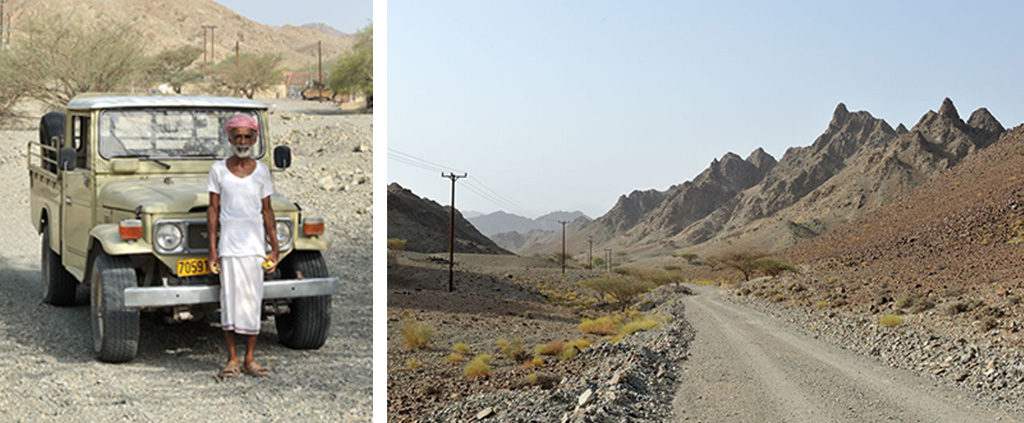
24°00’44.95” N – 56°31’01.90”E
Keep left on the main track. Then stay right at the next junction right after.
24°00’39.42” N – 56°30’47.57”E
Keep left as you keep going forward.
24°00’20.62” N – 56°30’40.16”E
Keep right on the main track as it goes down and cross the wadi bed. Then climb back up inside the village.
You’ll need to proceed as follow:
Left
Left
Right
After that last right, keep going as the road turns back to a dirt track.
24°00’20.63” N – 56°30’10.30”E
Keep right and follow the track as it steeply descent inside the wadi. Once in the wadi, cross it straight to reach the other side and ignore the track going right inside the wadi bed. (unless you want to go see what this beautiful wadi looks like further up stream!)
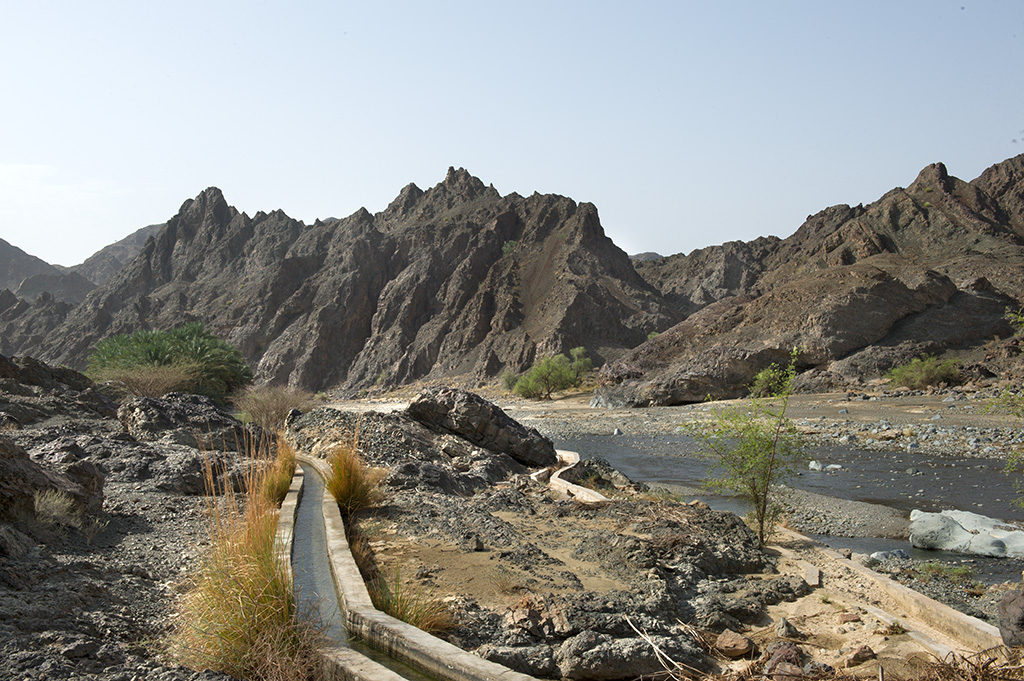
24°00’17.48” N – 56°30’04.12”E
This is the start of the track on the other side of the wadi bed. Be careful as it isn’t very obvious. The tracks climbs back up, but isn’t in the greatest condition. You’ll need access the track condition first, and then drive with caution.
If for some reason you can’t pass through. Get back to the village and follow the road towards Ghadifa al Jadeed and meet the trail here.
23°59’11.10” N – 56°29’34.04”E
As you reach the road, take left and follow it all the way to Road 8.
23°58’37.16” N – 56°30’15.61”E
You’ve reach the village of Ghadifa al Jadeed. You have a small market in town if you need food. If not cross the road and enter the dirt track in front of you.
23°58’37.60” N – 56°30’21.90”E
Take right at the junction.
23°58’31.58” N – 56°30’53.35”E
Take right at the road junction. And stay on that main road till Haybi.

23°55’24.99” N – 56°33’18.05”E
Leave the main road and take left here to go visit the Haybi fort.
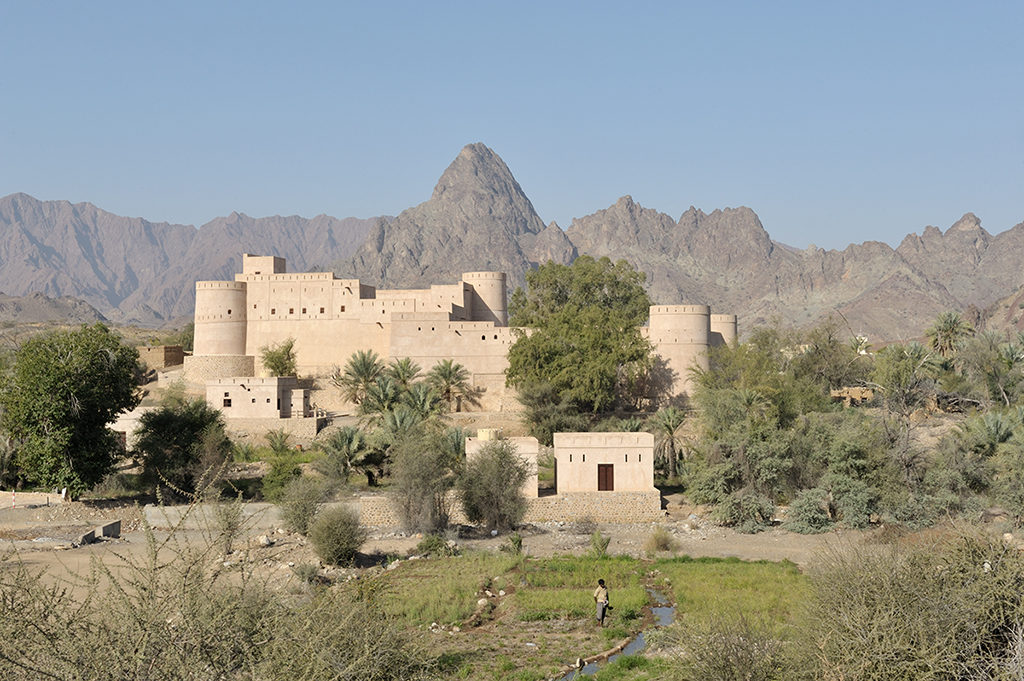
Once done get back to this intersection and turn left to resume your journey on that main road.
23°54’34.12” N – 56°30’10.28”E
Take right at the junction.
23°54’09.59” N – 56°32’57.66”E
Take right at the junction and stay on that main road.
23°52’04.90” N – 56°38’28.81”E
Take left at the junction. This is the junction with the Oman trail. If you want to switch to the Oman trail now click here.
The road will quickly turn to a dirt track and follow the wadi. Depending on the level of water it can make for a very fun drive.
23°55’09.72″N – 56°42’12.84″E
At the T-Junction keep straight.
23°55’39.05″N – 56°42’53.58″E
At the Y-Junction take right, and right again at the top.
23°55’08.48″N – 56°44’09.05″E
As much as crossing that wadi and its water sounds like fun, you need to turn right and head up.
23°53’28.76″N – 56°45’25.72″E
At the junction take left and keep straight on that track through the next coming cross section.
23°50’57.98″N – 56°47’46.07″E
As you reach the road, take right. Drive on till you reach the Al Aqli ruins.
23°48’48.98″N – 56°46’21.73″E
You have reach the Al Aqli ruins. Take right and park to have a walk around the ruins. You can also follow the falaj which is still very active today.
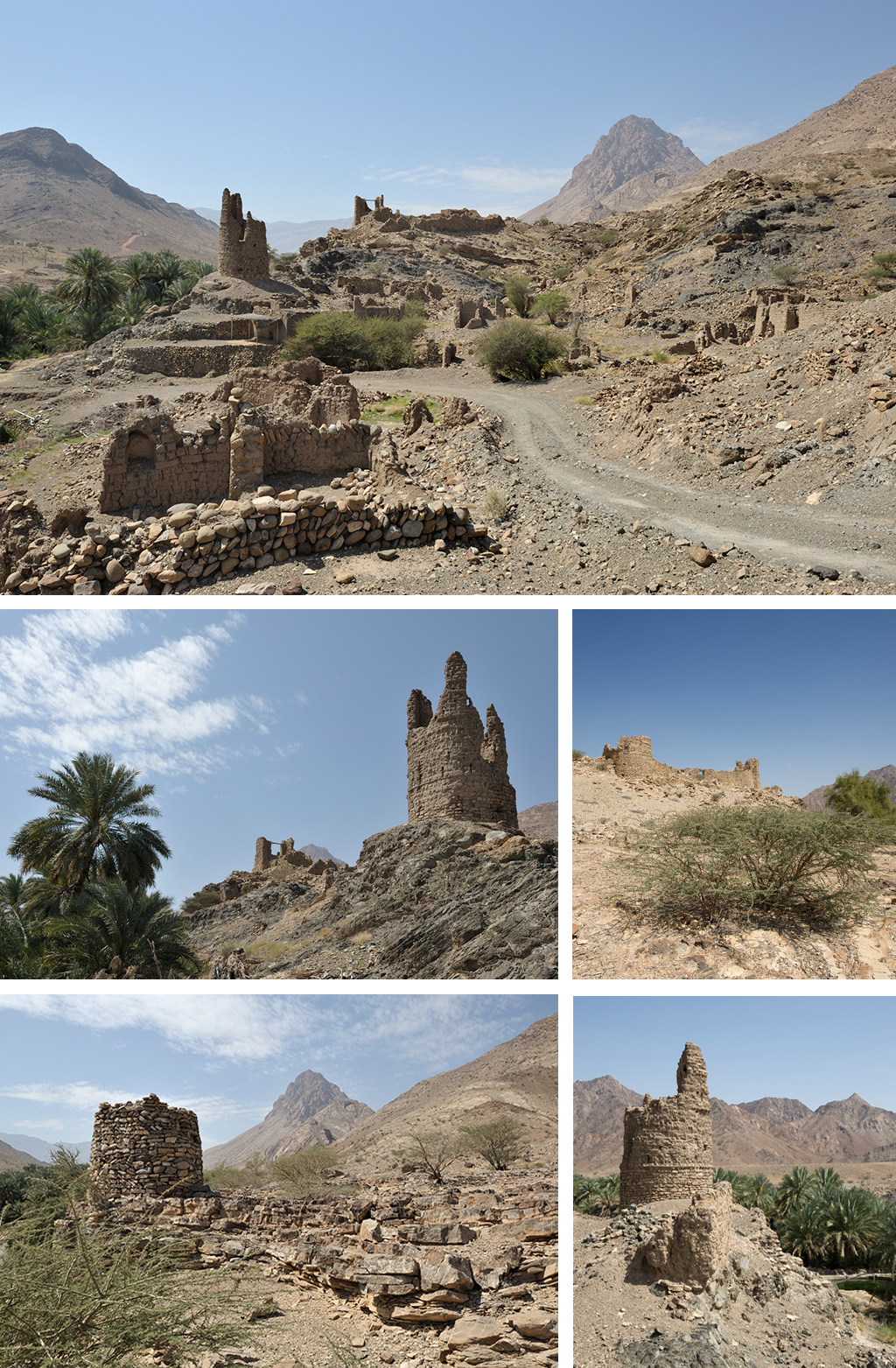
Once done get back on the road and follow through.
23°47’04.19″N – 56°44’07.41″E
Leave the road for the track on your left. Get down and cross the wadi and follow through.
23°45’45.36″N – 56°47’14.07″E
At the T-Junction turn right, then left again as you pass by the village. The tracks climbs up. As it climbs it gets worse (at least at the time I passed it) Nothing that should stops you, but it does make driving more interesting. Same thing as you get on the other side. The rain and the fact that not many people use this trail make it necessary to drive with caution.
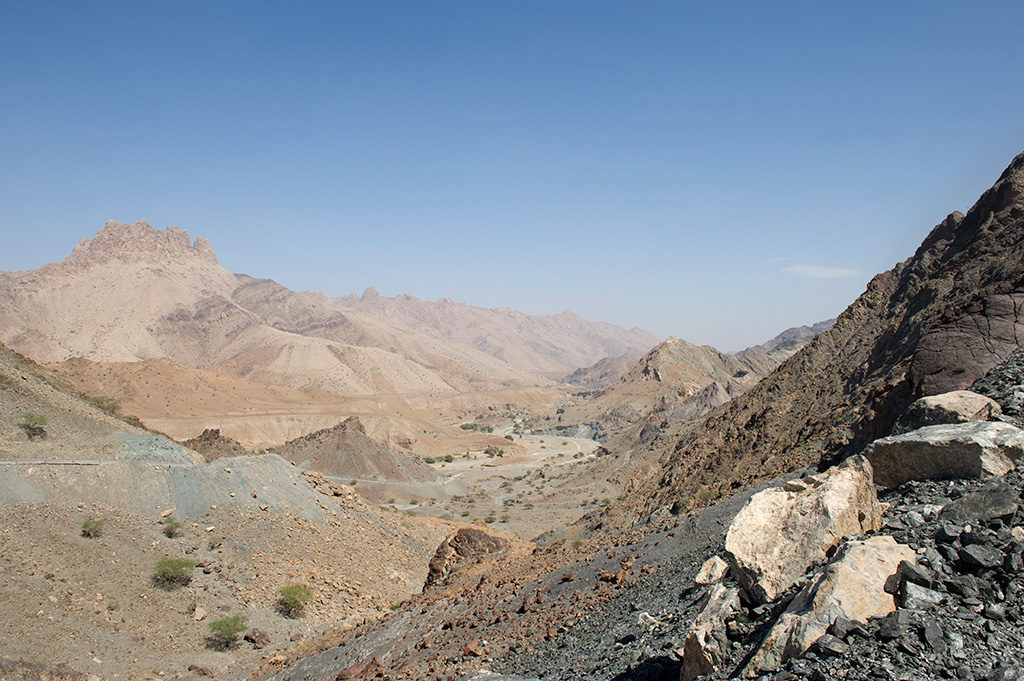
(Feedback and updates on that portion’s condition is welcome)
23°42’50.23″N – 56°45’41.35″E
At the T-Junction turn left and get back on the road.
23°43’20.26″N – 56°49’11.44″E
Get on the dirt track climbing up towards the phone antenna. You’re on a beautiful trail taking you through the mountains for a while.
23°39’18.24″N – 56°51’34.69″E
At the T-Junction turn right, and stay left at the following Y-Junction.
23°37’06.54″N – 56°51’41.24″E
Keep left.
23°33’56.18″N – 56°53’51.84″E
You’re back on the road, take left.
23°35’07.35″N – 56°57’52.05″E
Leave the road and head down the wadi as you follow the track on your right.
23°29’56.60″N – 57°01’09.17″E
Keep straight on the main road.
23°29’32.60″N – 57°00’38.19″E
At the Junction take left, and straight on.
23°29’16.01″N – 57°00’34.41″E
At the T-Junction, turn left.
23°28’48.71″N – 57°01’44.81″E
At the T-Junction, turn right. What used to be a trail as of just last year is now a road. Follow that road. (Some part are still made of dirt, but not for long!)
23°22’50.80″N – 57°00’50.49″E
At the T-Junction, turn right. Here is a bit confusing because of the road construction going on at the time. The idea is to get on Highway 10 towards Bid’ah and the Maqniyat fort.
Once on that road just follow through as it follows the wadi.
23°22’30.27″N – 56°53’11.48″E
On the right you can see the Maqniyat fort. It is a ruin, and as such it is interesting to see and compare with the one that have been restored. The amount of work put in to bring them back to their original splendor. There is no direct access by car. You need to park and walk up to it.
23°23’59.70″N – 56°46’28.74″E
Gas station.
23°23’55.56″N – 56°44’51.97″E
Get off the road as you turn left on the dirt track.
23°22’50.80″N – 57°00’50.49″E
Get off the main track and start looking for a place to spend the night. Do not stay too close from the main track you were on. It is subject to traffic as trucks come back and forth from a quarry a bit further along.
23°20’04.74″N – 56°44’57.62″E
This is our selected campsite for the night.
End of day five.
Day Six
Bat to Jabal Shams
95 km.
Introduction.
Short drive today taking you up to Jabal Shams. On the way you will stop to see the Bat and Al Ayn tombs. Once in Jabal Shams, you’ll park your car and spend the afternoon climbing up and down the mountain summit or choose to brave the cliffs following the old track on the edge of Wadi Ghul…
Recommendations.
Easy transition drive towards Jabal Shams. The climb up and around the mountain is fun.
Once in Jabal Shams you can either camp out or stay in one of the local resorts. I have always camped, but enjoyed the buffet diner at the Jabal Shams Sama resort a few times and recommend it. They even have Vegan options available. See listing below.
The drive.
Starting Point.
23°22’50.80″N – 57°00’50.49″E
Back on the main track from where you decided to camp. Keep heading south on that main track.
23°16’56.28″N – 56°45’06.19”E
At the junction with the road, take right and follow the road.
23°16’21.32″N – 56°43’41.44”E
At the junction, take right and follow the road.
23°15’58.74″N – 56°44’08.17”E
At the T-Junction, take left.
23°15’55.38″N – 56°44’46.87”E
You have reached the archeological site of the Bat village tombs. Have a look around.
Then keep on that road till the village of Al Ayn for more.
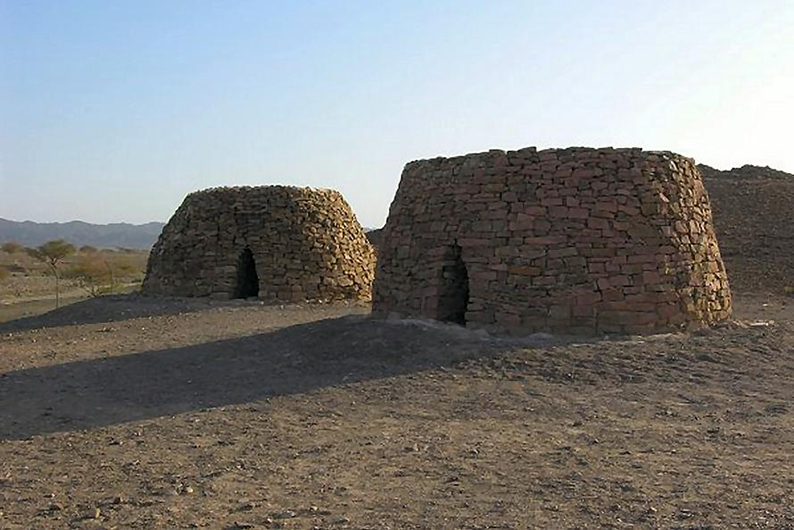
23°10’25.88″N – 56°55’05.48”E
At the T-Junction take left and follow the road.
23°12’21.81″N – 56°57’19.34”E
Keep left on the main road. Then straight on shortly after at the next T-Junction.
23°12’45.12″N – 56°57’43.07”E
Get off the road and onto the track on your left. From you need to cross the small wadi and once on the other side find a place to park in order to clim up to the Beehive tombs you can now see at the top of the small hill in front of you.
23°12’58.04″N – 56°57’43.51”E
Al Ayn Beehive tombs.
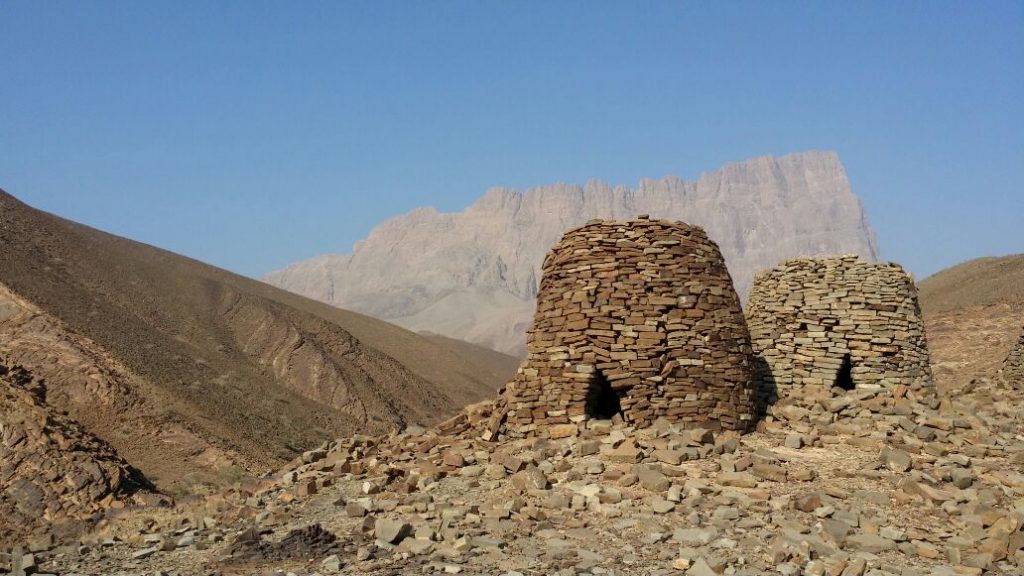
23°12’45.12″N – 56°57’43.07”E
Once back on the road, keep in the same original direction until the next round-about and then take the first exit right and climb up.
23°09’46.54″N – 57°04’17.24”E
Take left on the dirt track right before the buildings.
23°09’41.85″N – 57°05’15.71”E
Keep straight and start to climb.
23°09’39.48″N – 57°05’42.80”E
Stay right on the main track. Both here, and at the following junction that leads to the hamlet.
23°10’24.33″N – 57°08’56.81”E
Take left on the road leading now to Jabal Shams. Stay on that road all the way up.

23°15’08.50″N – 57°10’00.44”E
At the Y-Junction take left, and stay right at the following right after.
23°16’52.82″N – 57°09’45.00”E
Take right.
23°14’46.84″N – 57°13’04.74”E
Keep straight.
23°14’22.28″N – 57°11’51.78”E
Take left.
23°13’35.28″N – 57°12’04.30”E
This is the hotel where you can have diner tonight. It’s quite good. You can even decide to sleep there if you want. There is a second option down the road but I have not tried it. It is also the start of the W4 trail that can take you to the Jabal Shams summit.
If you want to tackle trail W6 trail down wadi Ghul, keep driving down this road all the way till its dead-end and park there.
23°13’15.84″N – 57°12’05.74”E
Leave the road and take right on the trail passing in front of the small house. Keep going pass the flat ground and drive around the hill. Once on the other side leave the track and get down through the flat rocks to find your campsite. It’s just one among the many many options around. But this one is quiet, which might not be the case on the other side, particularly on week-ends.
23°13’14.46″N – 57°11’23.76”E
Recommended campsite.
Recommended Hotel.
Sama Heights Resort
Jabal Shams Road,
111 Dar Sawda,
Oman
+968 927 21 999
samaheights@samaresorts.com
End of day six.
Day Seven
Jabal Shams to Jabal Akhdar
191 km.
Introduction.
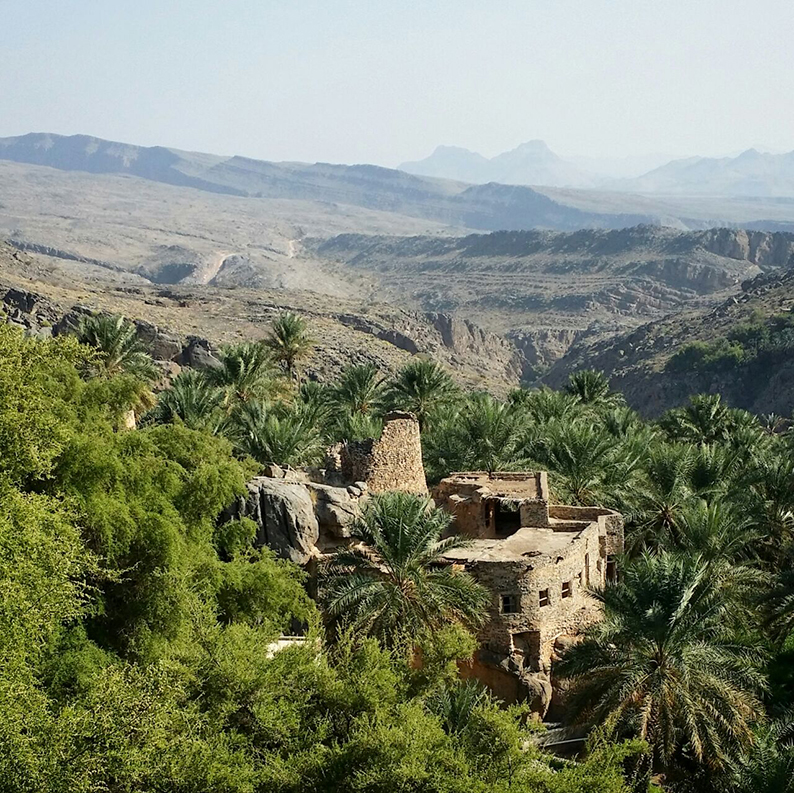
Today is a culture day. The Ghul ruins, Al Hamra, Misfat al Abriyyin, the Hoota cave, the Balah Fort, The Jabrin Castle, Nizwa fort and souk… So much to see, so little time !
You have several hotel options today on top of camping by the edge of the cliff of Jabal Akhdar.
You can either follow the trail and stay at the Shorfet Al Alamin Hotel. Or you can find one around the area off the trail. If budget is no worries, we strongly recommend Alila Jabal Akhdar on the Sayq plateau. Your choice.
Recommendations.
Apart from the early part of the drive coming down from Jabal Shams and the climb back up to Jabal Akhdar, today is spent driving around on roads from one culture site to the next. Keep your tires at their normal pressure.
The drive.
Starting Point.
23°13’15.84″N – 57°12’05.74”E
Once you are back on the road, at 23°14’22.28″N – 57°11’51.78”E Take left and drive back down from Jabal Shams, and keep on that road all the way to the town of Al Hamra.
23°08’56.46″N – 57°12’14.01”E
Leave the road, get down across the wadi and park your car and the entrance of Wadi Ghul. Sitting above you is the old village of Ghul. Have a walk and appreciate the beauty of the site.

Back on the road, resume your journey towards Al Hamra.
23°06’59.72″N – 57°16’49.76”E
Leave the road, take left going down toward the wadi bed.-, cross it and turn left as you reach the tarmac again. At the round-about take the first exit right.
23°06’05.08″N – 57°16’46.91”E
Turn left and enter the palm garden.
23°07’12.94″N – 57°16’51.29”E
You’ve entered the old Al Hamra. Turn right. Park your car and have a look around.
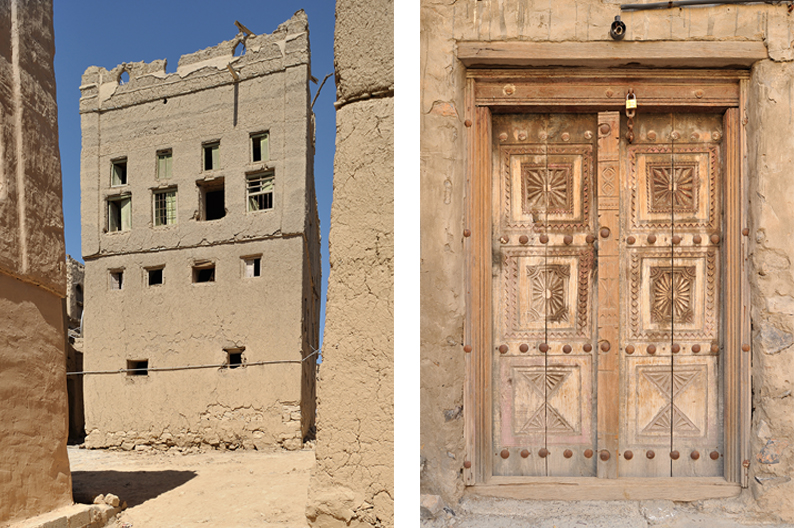
Once done, head straight that street until you exit the old town.
23°07’12.92″N – 57°17’07.90”E
As you exit the old town keep straight heading west.
23°07’12.58″N – 57°17’16.10”E
At the fork follow right as the road bends south-southeast.
23°07’07.84″N – 57°17’20.30”E
At the Fork stay on the left.
23°07’12.92″N – 57°17’07.90”E
Turn left and drive all the way up to Misfat Al Abriyyin.
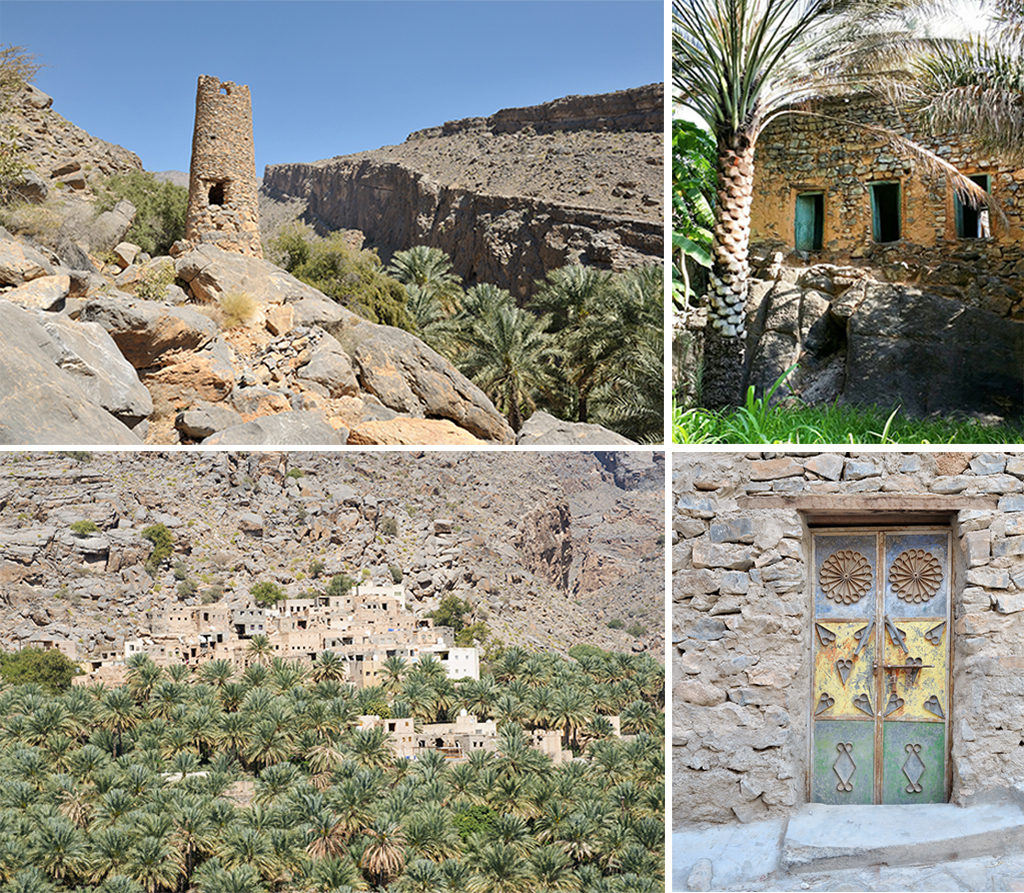
Have a tour, then drive back to this point. You will then turn left ad follow this road on till the round-about where you will turn right.
23°06’40.37″N – 57°17’31.02”E
Turn left and drive on all the way to the Al Hoota cave. Have a visit, then drive back to this point where you’ll turn left and drive on, pass the first round-about straight.
23°06’02.70″N – 57°16’39.00”E
At the round-about keep straight on. Be noted you have on the right a gas station, supermarket and a restaurant if you need.
From here you are heading for the town of Bahla and its beautiful fort. Just follow the signs.
22°57’52.00″N – 57°18’02.05”E
The Bahla Fort.
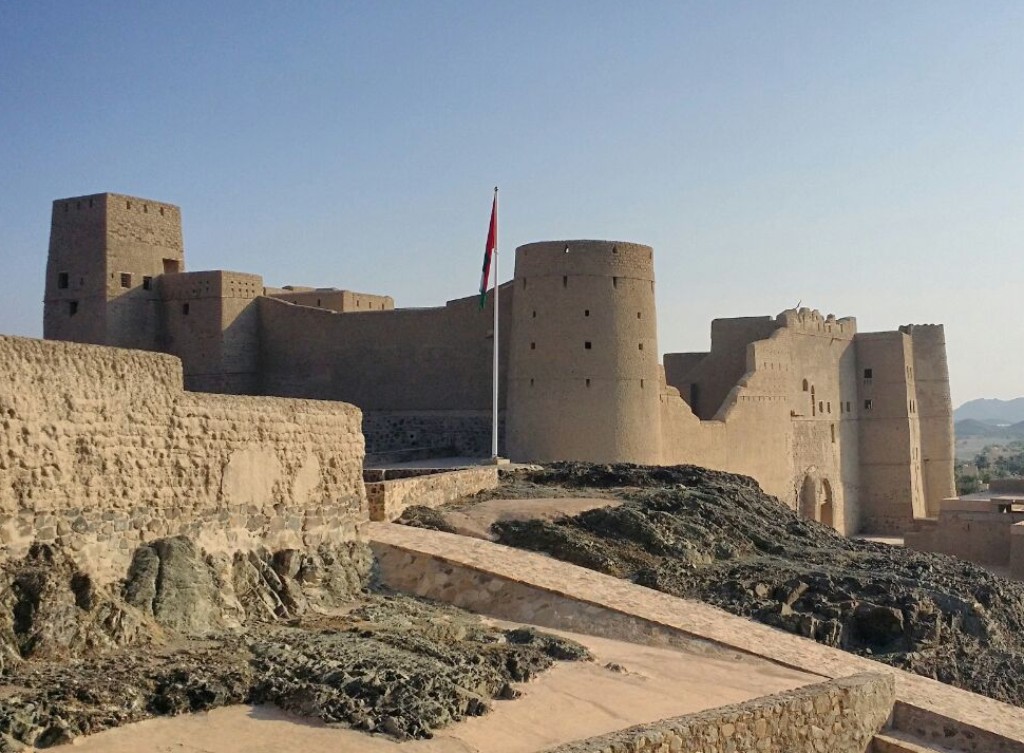
From here get back on the main road and follow the signs guiding you to your next cultural visit, the Jabrin Castle on the other side of Highway 15.
22°54’55.06″N – 57°14’56.72”E
The Jabrin Castle.

From here go back to Highway 15, and follow the Nizwa sign. Get off at the Nizwa exit after the large Mosque on your right. Pass over the freeway and head towards the center of town and its fort. Shortly after the exit is a large mall. A good place to get food, The pizza place in the food court is a good choice.
If not keep driving all the way to the fort and its souk.
22°55’59.36″N – 57°31’48.87”E
The Nizwa Fort.
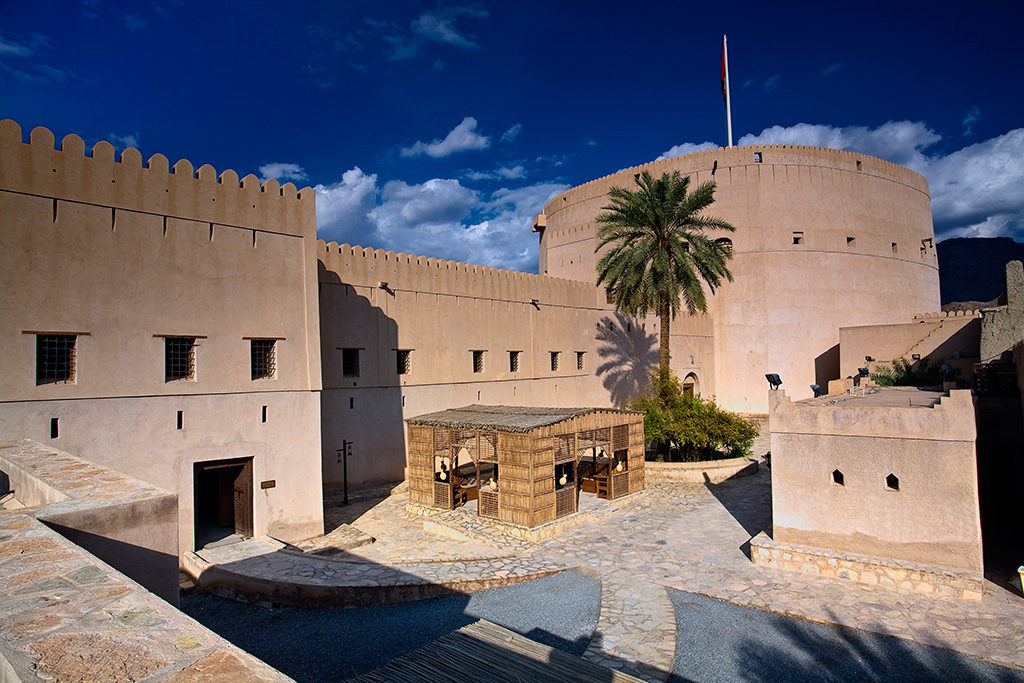
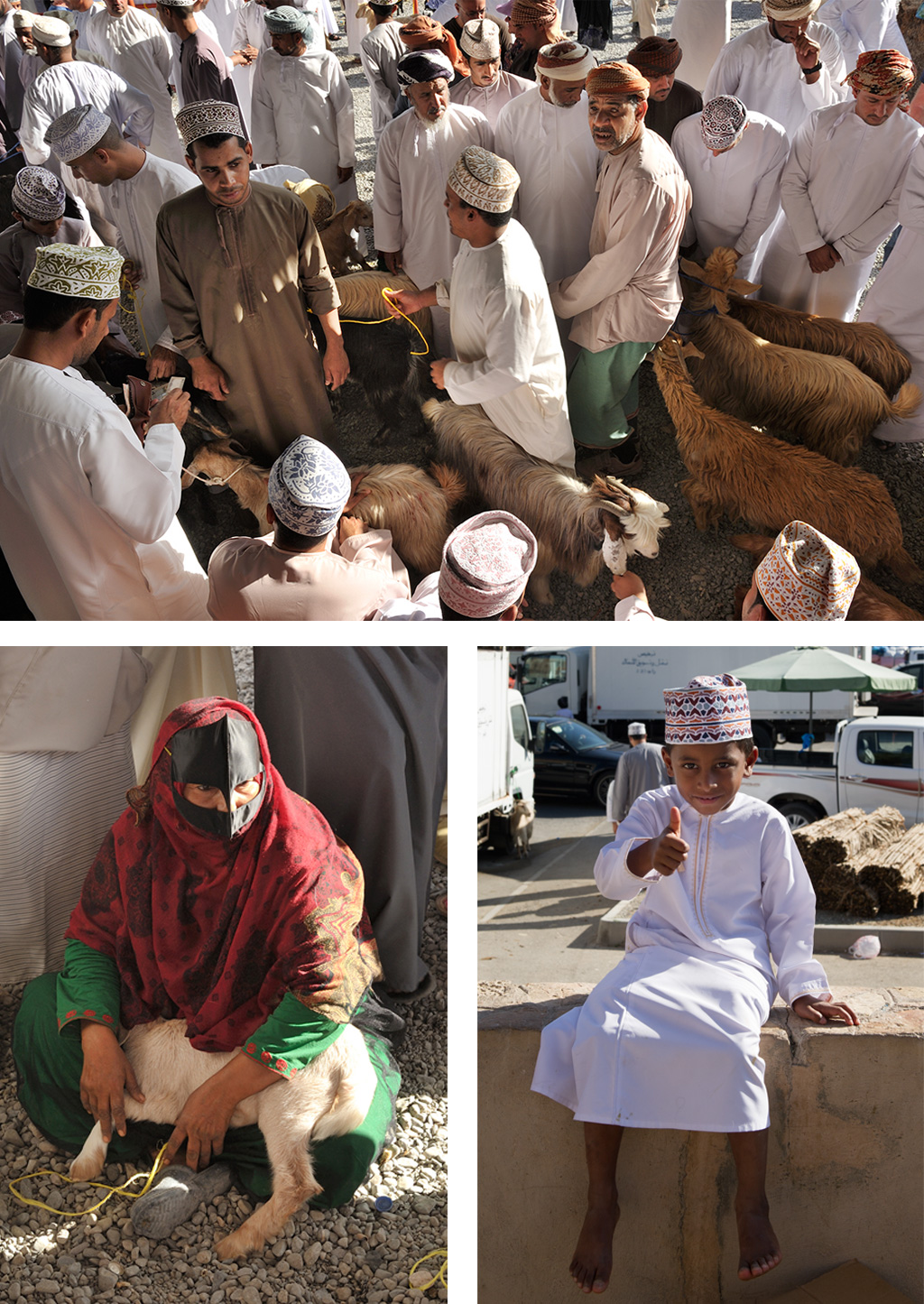
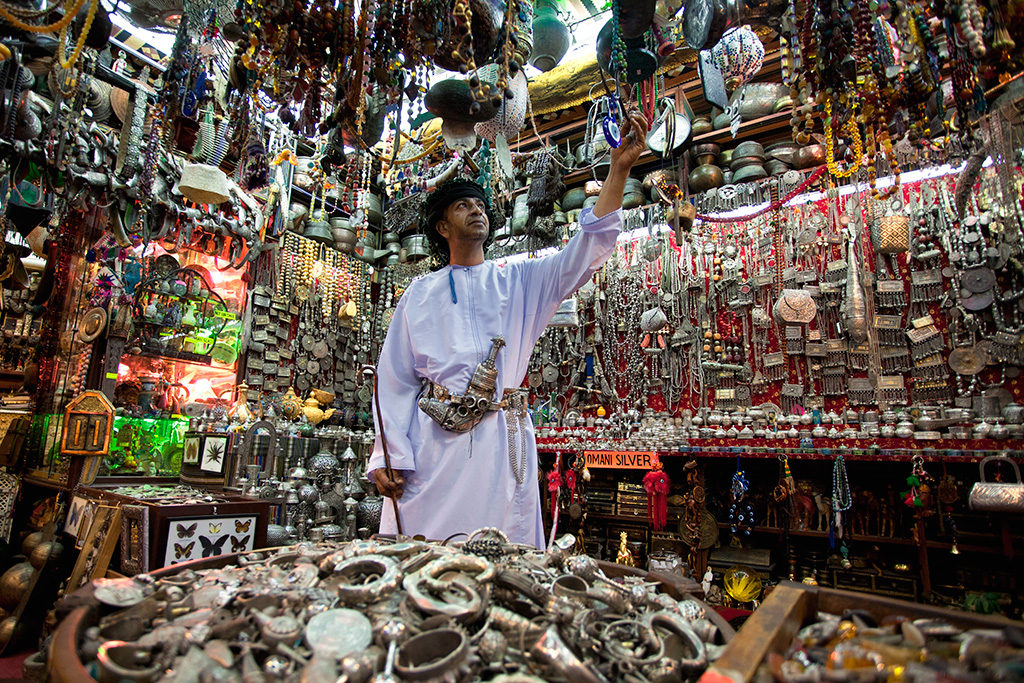
From here get back on Highway 21 heading back towards Al Hamra.
22°57’37.79″N – 57°31’46.55”E
Refill here if you haven’t already, this is one of your last chances before a long while.
23°01’53.38″N – 57°25’18.06”E
Turn left here. You have a gas station if needed. This is the last one before climbing back to the mountains.
Head straight towards the foot of the mountain. You can see a trail climbing up, this is where you want to go.
23°03’36.32″N – 57°26’06.07”E
Turn left here, and follow the road as it turns into a dirt track climbing up.
23°05’35.31″N – 57°25’59.53”E
Take left towards the village.
23°05’36.94″N – 57°25’48.34”E
Take right between the buildings and climb straight up that little steep stretch. From here follow the main track until the road.
23°06’29.88″N – 57°24’35.56”E
Take right on the road and climb up all the way.
23°10’01.71″N – 57°24’54.82”E
This is the end of the day. Enjoy the view of what is to come tomorrow. On your left is hotel Shorfet Al Alamin. It’s good place to have diner. You can stay the night as well. Or you can camp on the edge of the cliff. Don’t stay to close to the hotel if you do just to be in a quieter spot. It be noted that on week-ends the place is “popular”.
Shorfet Al Alamin
Jabal Hat
Al Hamra
111, Al Hamra
Oman
End of day seven.
Day Eight
Jabal Akhdar to Muscat
213 km.
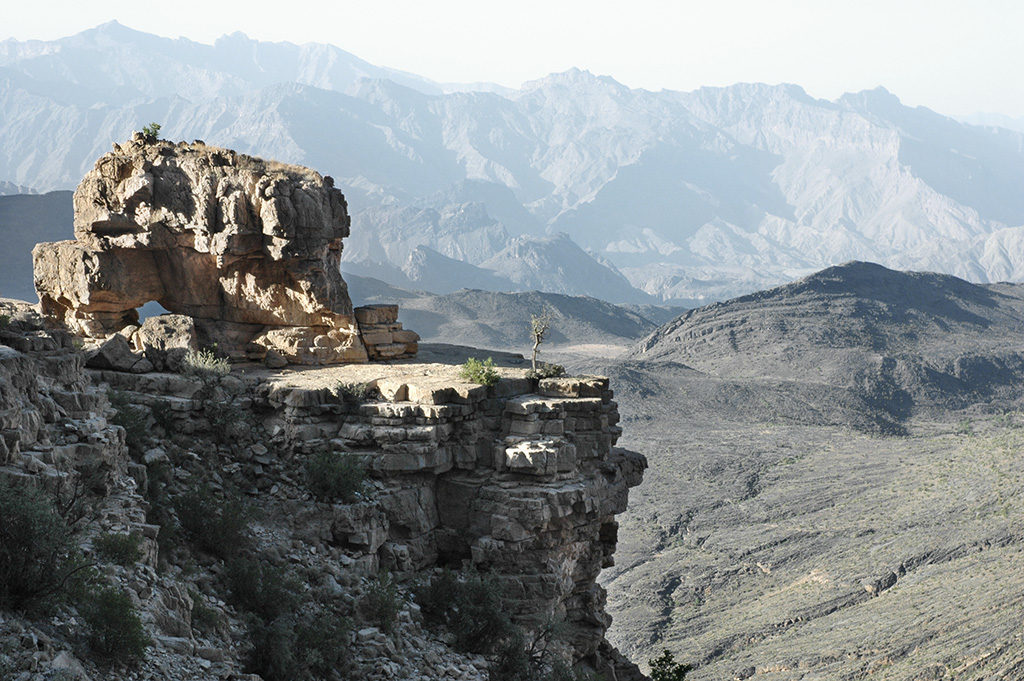
Introduction.
Last day in the Al Hajar Al Gharbi, and as it should the drive is taking you off-road through beautiful landscapes and villages across the mountains, before stopping at the Nakhl and Najal forts. You can also take the time to go canyoning in Wadi Awf. Enjoy !
Recommendations.
We are back on trails today, starting with a very steep descent towards the village of Bilat Sayt and Wadi Awf, then serpent through the wadii and mountain passes. Have you tire at 20/25 PSI
The drive.
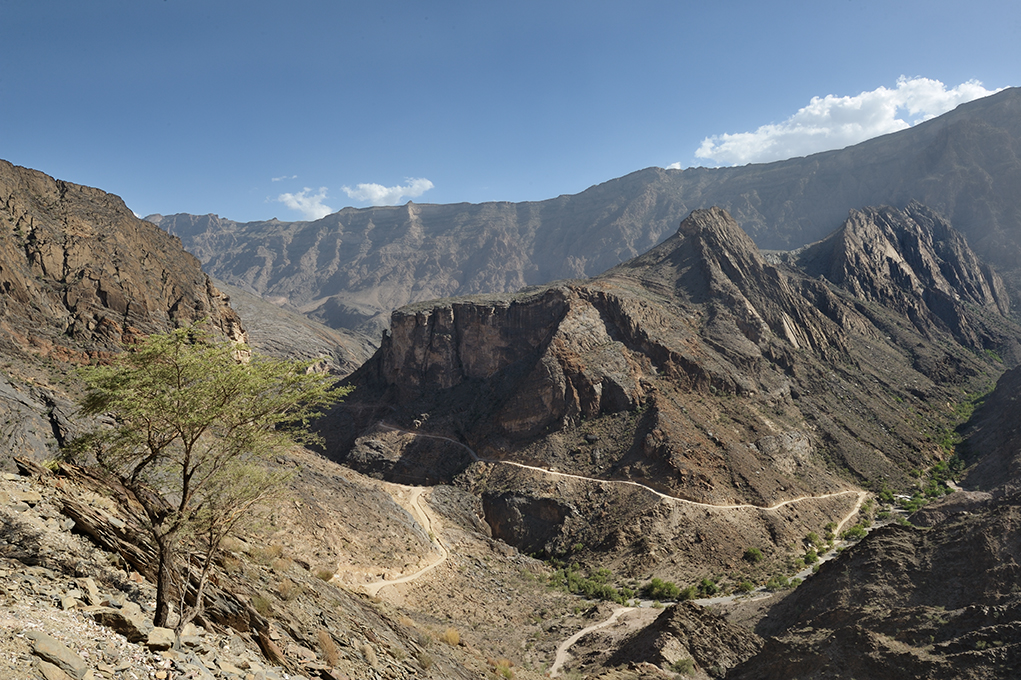
Starting Point.
23°10’01.71″N – 57°24’54.82”E
From where you camped, get back to the parking at the end of the tarmac and head down the dirt track. It’s very steep and can be impressive, just drive with caution. Keep on that main track all the way down.
23°11’51.94″N – 57°23’25.82”E
On your right is wadi Awf, one of the best canyoning spot in Oman. If you want to spend an extra day in the area and explore the canyon, and have the necessary gears for it, you should, it’s definitely worth the exploration.
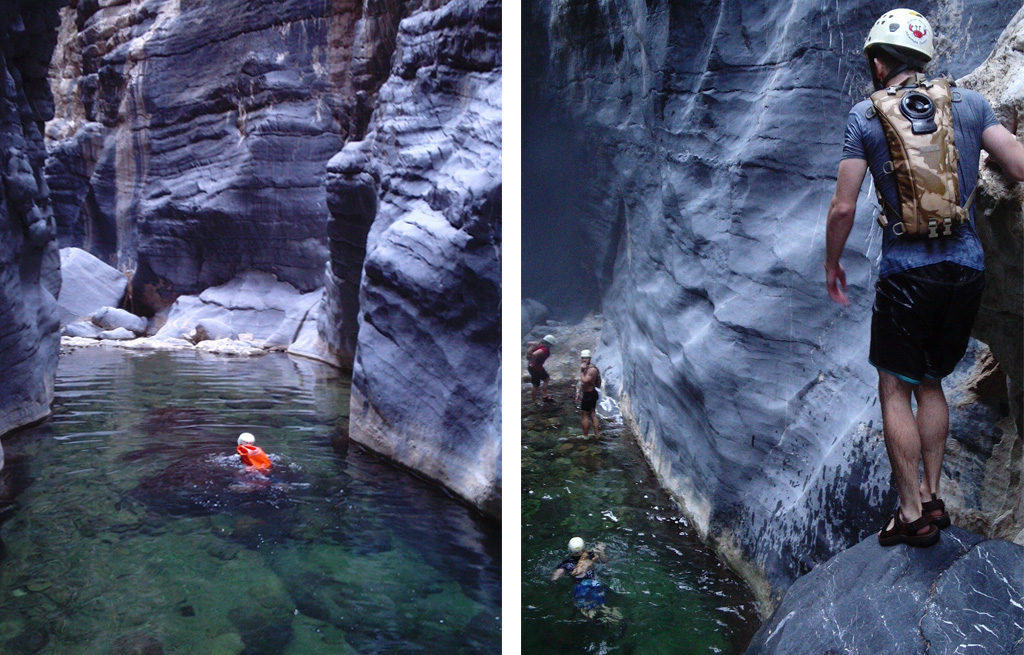
23°12’05.65″N – 57°23’30.06”E
The Audi stadium. Build by Audi for one of its commercials.
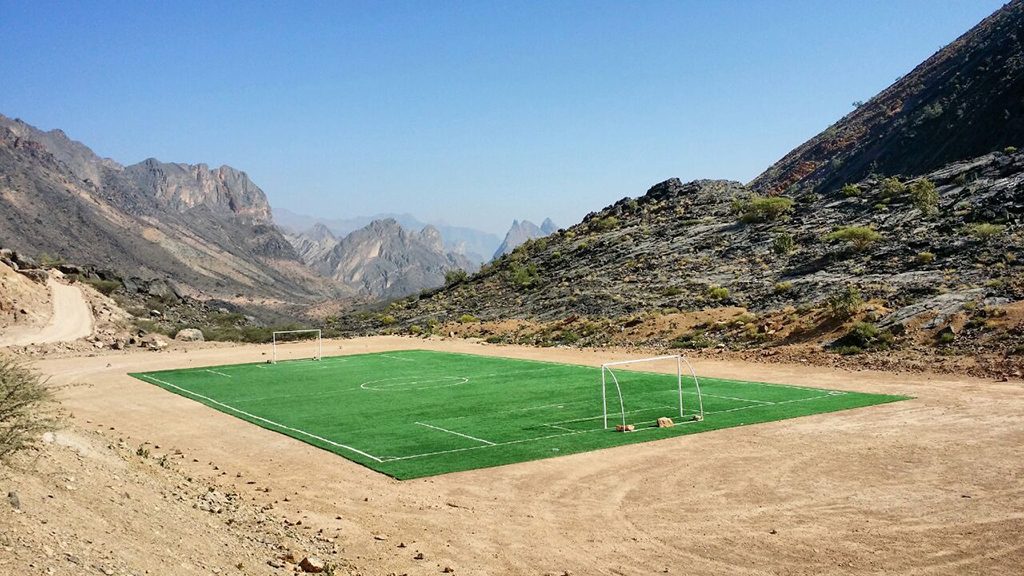
23°12’15.05″N – 57°23’29.77”E
At the junction take left and drive to the village of Bilat Sayt for a visit. Then come back to this point and keep on this track.
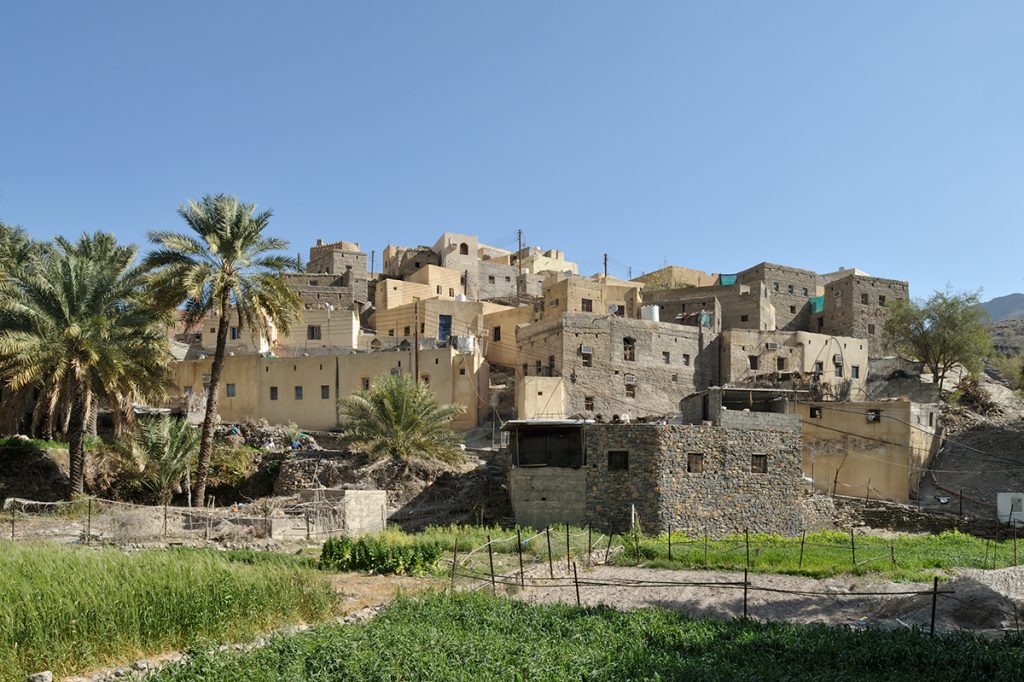

23°12’44.18″N – 57°23’11.84”E
At the junction take left and drive up.
23°12’58.61″N – 57°23’20.36”E
Keep straight on up.
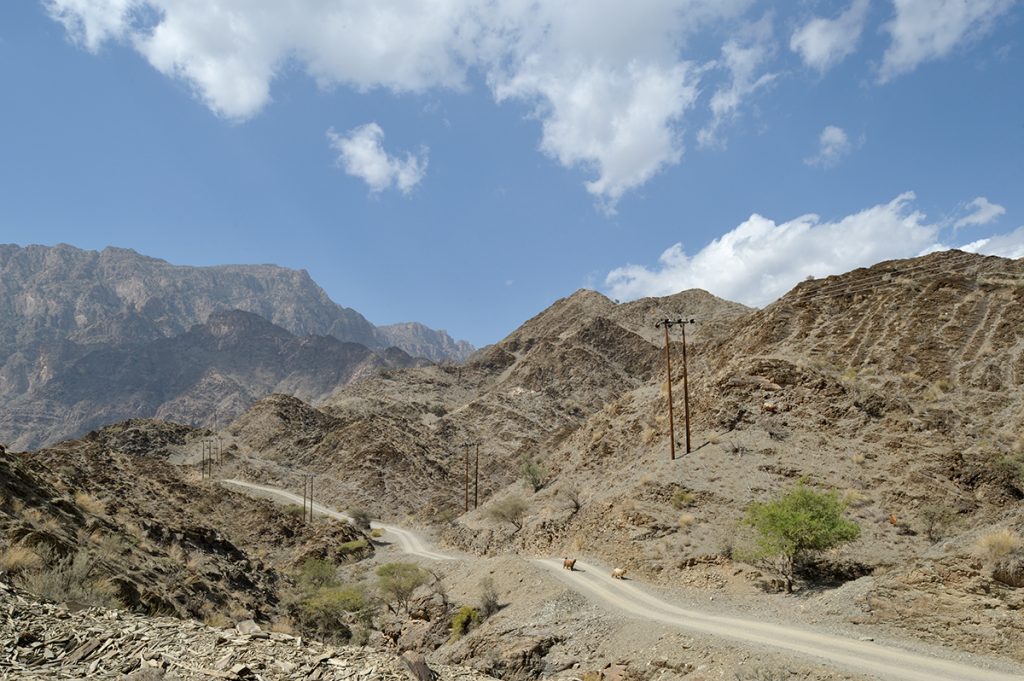
23°13’07.94″N – 57°22’46.35”E
Keep on the main track as it bends right.
23°13’20.84″N – 57°22’54.49”E
Take left at the junction, and left again at the next one.
23°14’37.26″N – 57°22’08.67”E
At the Junction take right.
23°15’19.63″N – 57°23’28.57”E
Keep straight until the fork where you’ll turn right.
23°15’22.94″N – 57°25’46.59”E
On your right is Little snake canyon. Take right and park your car further along. From there have a walk through the rocks and pools. (if you have already done wadi Awf, this is a smaller version)
Once done, get back on the main track and carry on.
23°15’30.13″N – 57°26’23.83”E
At the fork, take right.
23°14’26.37″N – 57°26’15.21”E
Keep straight. (On your right is the other end of the Little snake canyon)
23°13’51.82″N – 57°25’30.80”E
At the T-Junction turn left.
23°12’49.33″N – 57°27’23.68”E
Take left and climb up. It’s steep.
23°12’44.45″N – 57°29’12.52”E
Keep straight on down.
23°12’53.78″N – 57°30’33.75”E
Take left on the road.
23°18’03.84″N – 57°31’47.51”E
Turn left.
23°18’41.94″N – 57°31’17.11”E
Turn right. You’re now on Highway 13. Follow that road all the way down to the town of Nakhl.
23°24’28.18″N – 57°49’14.73”E
At the round about, take the first exit right towards the Nakhl fort and follow the signs.
23°23’40.50″N – 57°49’42.50”E
Nakhl Fort.
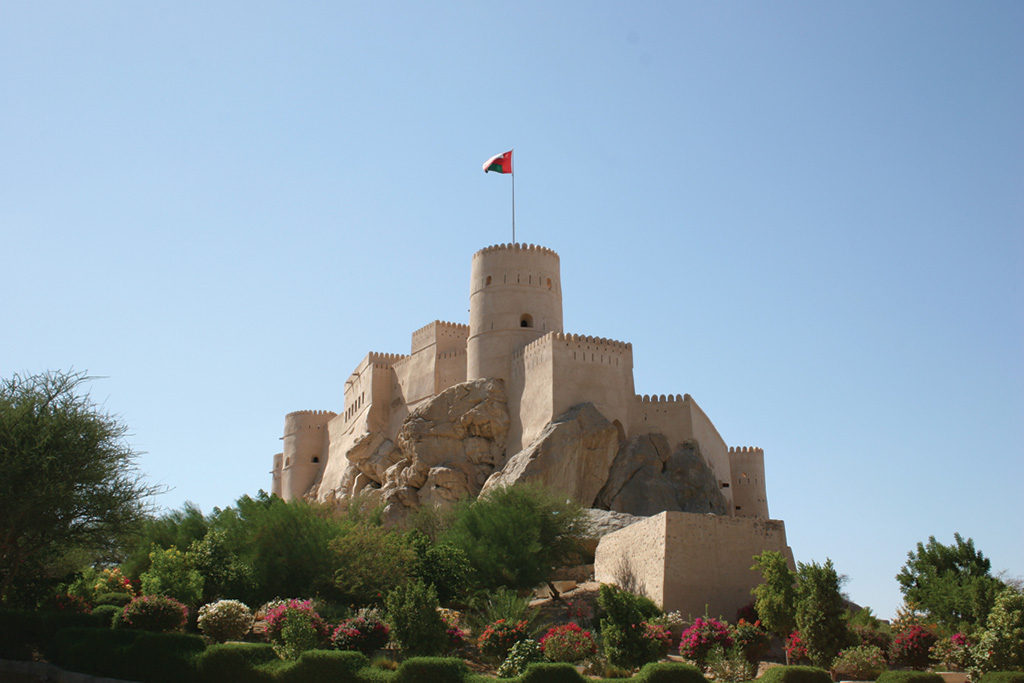
Once done with your visit back track to the round about and take right on Highway 13 towards Muscat.
23°30’34.38″N – 57°51’06.76”E
Turn right and follow that road.
23°31’19.76″N – 57°54’43.85”E
At the round about take the first exit right and drive up towards the Al Najal fort you can see on the hill. Unlike the Nakhl fort you just visited, this one is still in ruins. It shows you the extend of renovation work between the two.
Once done looking at it, get back to the round about and take the first exit on your right and follow the road.
23°33’27.57″N – 57°59’08.89”E
At the round-about take right and follow the road. The road is new, one more trail covered in Tarmac.
23°29’40.89″N – 58°02’17.79”E
Turn left.
23°28’30.35″N – 58°05’40.62”E
At the T-Junction turn right. Pass the village until you reach the Fanja fort.
23°27’28.27″N – 58°06’06.91”E
The Fanja fort, best known for its canons.
After the visit, get back on the road in the same direction.
23°27’18.90″N – 58°06’28.65”E
Take right and follow that road.
23°25’57.33″N – 58°07’11.80”E
Cross over the Highway. On the other side take the first exit at the round-about, then the first road on your left. Follow it as it bends right and crosses the village.
23°25’14.11″N – 58°08’05.26”E
Turn right.
23°24’56.89″N – 58°08’04.12”E
At the fork take right and follow that main street.
23°24’34.68″N – 58°07’58.32”E
Turn Left.
23°24’21.80″N – 58°08’20.36”E
Keep straight and cross the wadi.
23°24’22.72″N – 58°08’32.71”E
As you leave the palm garden take left on the paved road and follow through as it crosses the hamlet.
23°24’39.37″N – 58°08’48.77”E
Turn right onto the dirt track. This is your last trail of the trip. Enjoy !
23°24’01.84″N – 58°10’10.15”E
Keep straight.
23°26’10.69″N – 58°12’06.00”E
Take left.
23°27’15.93″N – 58°12’22.39”E
Take right.
23°27’02.15″N – 58°13’02.35”E
Take left on the road.
23°27’27.27″N – 58°13’38.08”E
Take right.
23°27’37.74″N – 58°13’55.10”E
Take Left and keep straight all the way till the highway.
23°28’40.56″N – 58°13’41.53”E
Take right and follow that road all the way to Muscat for the end of today drive.
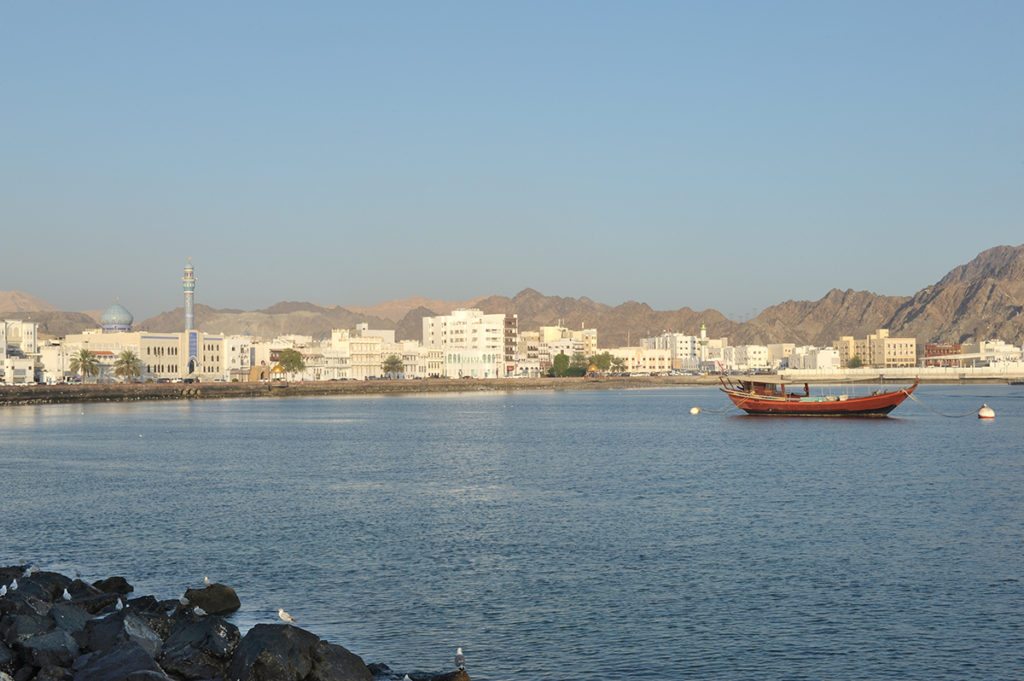
Camping and lodging in Muscat.
Either spend the night in a Hotel, or camp on the beach.
Local Hotels
There are plenty of hotels in Muscat for you to choose.
I suggest you check Booking.com for a better idea as I can’t list them all.
I recommend the Ibis Hotel. It’s clean, comfortable and reasonably priced.
For those of you on a bigger budget, you also have the Crowne Plaza Hotel on the beach, or the Barr al Jissa Resort down the coast, and if the sky is your limit, the famous Al Bustan Palace hotel further along.
The second option is to camp in town on one of the local beaches. Again consider the day of the week. Week-ends can be busy (and noisy!).
Ras Al Hamra beach 23°38’32.19” N – 58°29’54.68”E is a good option, tuck in a little cove. Or The Qurum beach 23°36’28.52” N – 58°26’11.78”E with it’s extended stretch of sand offers a broader and quieter choice if on a week-end.
End of day eight.
Day Nine
Muscat
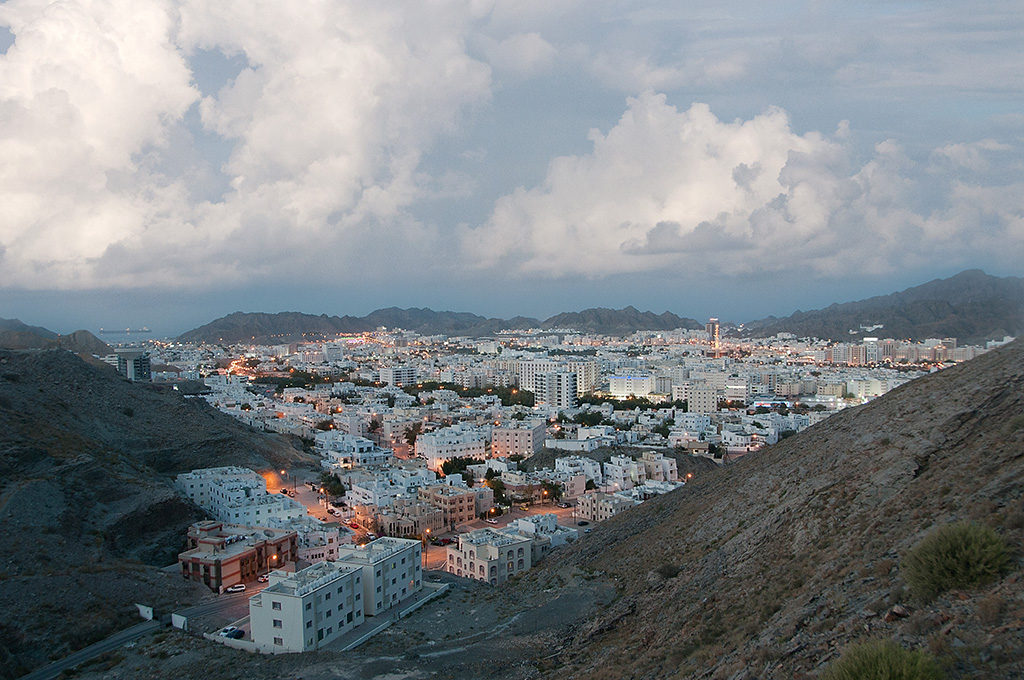
Unless you already know muscat well, I recommend you spend the day in town to visit its main sites. If not interested, jump to day 10 for the rest of the trail.
The Muscat you see today, began its expansion in 1970. Before that, the small port (Muscat in arabic means anchorage) would find comfort behind its walls and surrounding mountains and close its access at night. Inside the gates of Al Bab Al Mathaib, Al bab Al Kabir and Al Bab Al Saghir, you had to use your own lantern to walk around at night. The old town dates back to the first century BC. It will remain a quiet fishing harbor until the XV century when its deeper waters attracted the bigger merchant ships looking for a safe place to land on the coast. That is exactly what will bring the Portuguese to the area a century later, turning Muscat into a well protected naval outpost for their boats. The forts they build on each side of the bay, the Mirani fort, completed in 1587 and the Jalali fort finished in 1588 are still here to remind us of their presence. (you can’t visit them however)
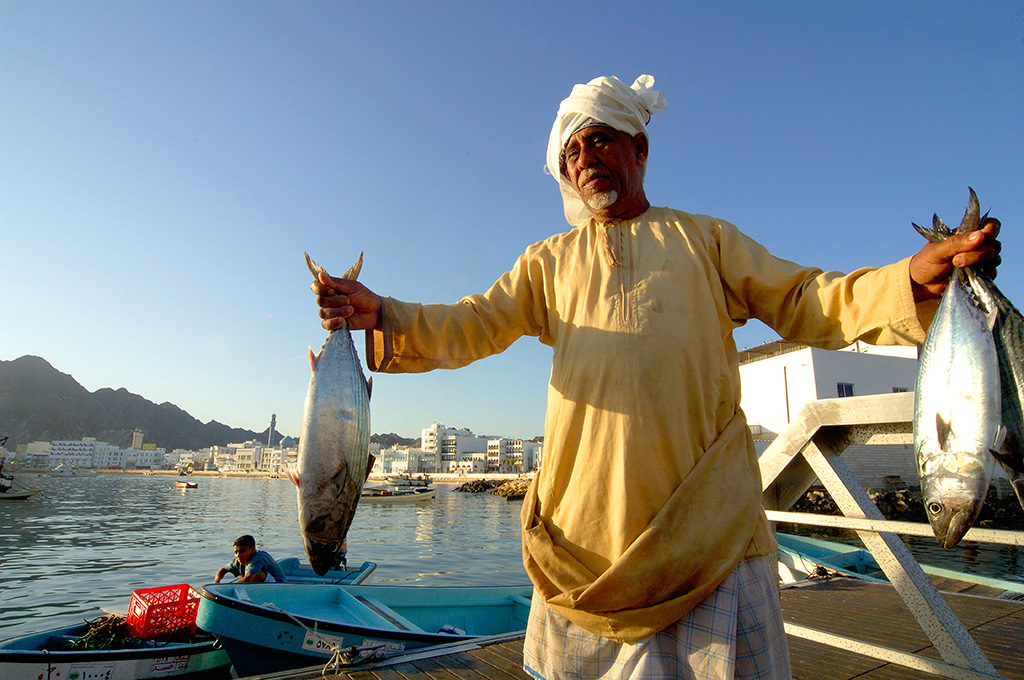
Al Muttrah is the most visited area of Muscat, and shows how the authorities managed to mix in a pleasant manner old and modern buildings, keeping the authenticity of the place intact.
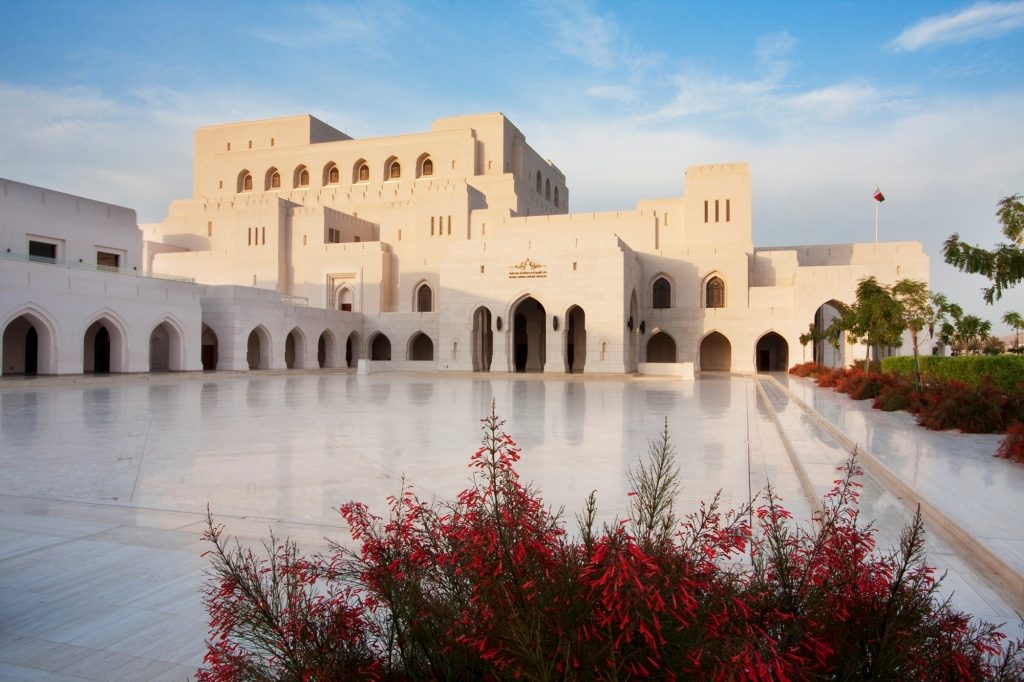
I recommend you spend time here and visit the Omani French Museum, (Open in the morning only, Sat to Wed.) Built for Ghaliah bint Salim, niece of Sultan Said bin Sultan, this remarkable building was offered to Paul Attavi, first french Consul in Oman in 1894, by Faisal bin Turki al Said. The other interesting site to visit is the Bait al Zubair house on Al Shaidiya street. (open from Sat. to Thur. 9H30 am to 1pm and 4pm to 7pm) Here you see collections of local costumes, jewels, arms, as well as a replica of a traditional Omani village in its park.
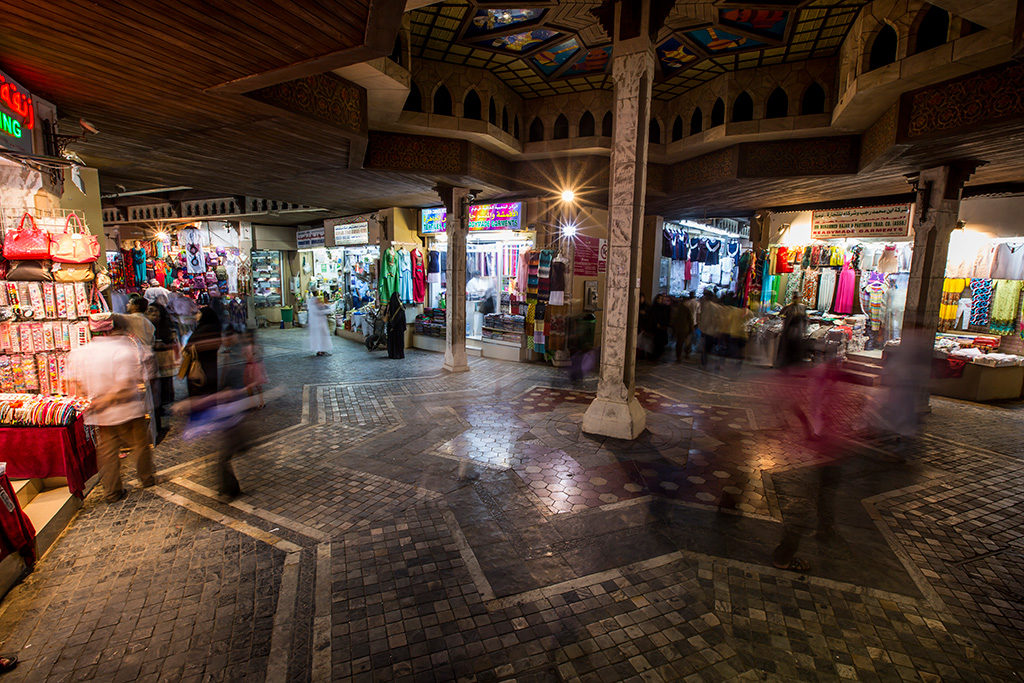
You should also visit the old souk. It has been modernized yet still feels authentic, (not as much as the one you will see in a few days in Nizwa, but nevertheless a great place to find true local produce and goods.) The other point of interest in Muttrah is Bait al Baranda, (open from Sat. to Thru. From 9am to 1pm and 4pm to 6pm) where you can study the geological and anthropological history of Muscat.
Saved for last, the main attraction in Muscat is the new Sultan Qaboos grand mosque. (open to non Muslims Mon. to Thur. 9am to 12am)

Day Ten
Muscat to Jabal bani Jabir
194 km.
Introduction.
Time to leave Muscat behind. Today you will have a first taste of the Al Hajar ash Sharqi, its peaks and wadii. On the menu is Wadi Huyfahd, the geological treasures of Wadi Salil, the ancient fort of Quriyat, Wadi al Dayqa and its dam, and at the end of the day a climb up the Salmah plateau for a night near the Beehive tombs of Jabal Bani Jabir.
Recommendations.
There are plenty of gas stations along the first part of the way today, but not for the second half, so fill up when you can. The drive off-road is fairly easy at the beginning, but gets quite tricky when you start climbing up towards the high plateau, I recommend to deflated to 20/25 psi for cars once you leave the tarmac for the first time and keep it that way all day. (Not point re-inflating each time you get back on the road, the stretches of tarmac are short. Just drive with caution at all times). Today is quiet a distance but shouldn’t stop you from stoping to admire the beauty around. If you can’t reach tonight’s destination, you’ll be able to find campsites along the way.
The drive.
Starting Point.
23°36’44.50” N – 58°35’37.83”E
Those are the coordinates of the round-about facing the old town mall. From here take on Al Saidiya Road going up towards Al Bustan.
23°35’24.84″N – 58°35’58.77″E
You have a gas station on your left.
23°34’03.00″N – 58°36’29.17″E
At the round-about take right on An Nuzhah st.
On your left at the round-about is the famous Al Bustan Palace hotel. (My wife would call it your last chance at a decent place to go to the bathroom for a long long while!)
23°33’38.32″N – 58°35’49.11″E
Exit An Nuzhah St., pass underneath An Nuzhah St. unto Qantab Rd.
23°33’25.06″N – 58°35’56.89″E
Turn right on the small road climbing up.
23°33’10.62″N – 58°35’58.82″E
You’re about to leave the tarmac for a dirt trail for a short while. No need to deflate yet or engage in 4-wheel-drive.
23°33’21.59″N – 58°34’05.00″E
You’re back on tarmac. Take a left on Tiwi Rd. all the way until the first round-about.
23°31’25.94″N – 58°38’01.00″E
At the round-about take right on the first exit.
23°30’29.78″N – 58°39’33.69″E
Take right at the Y section, then right again at the following Y section, then Right on the main road.
Keep straight on that main road.
23°30’00.85″N – 58°39’52.29″E
This is where the fun begins. You’re now entering your first wadi. Time to lower your tire pressure to 20/25 psi for better traction and comfort.
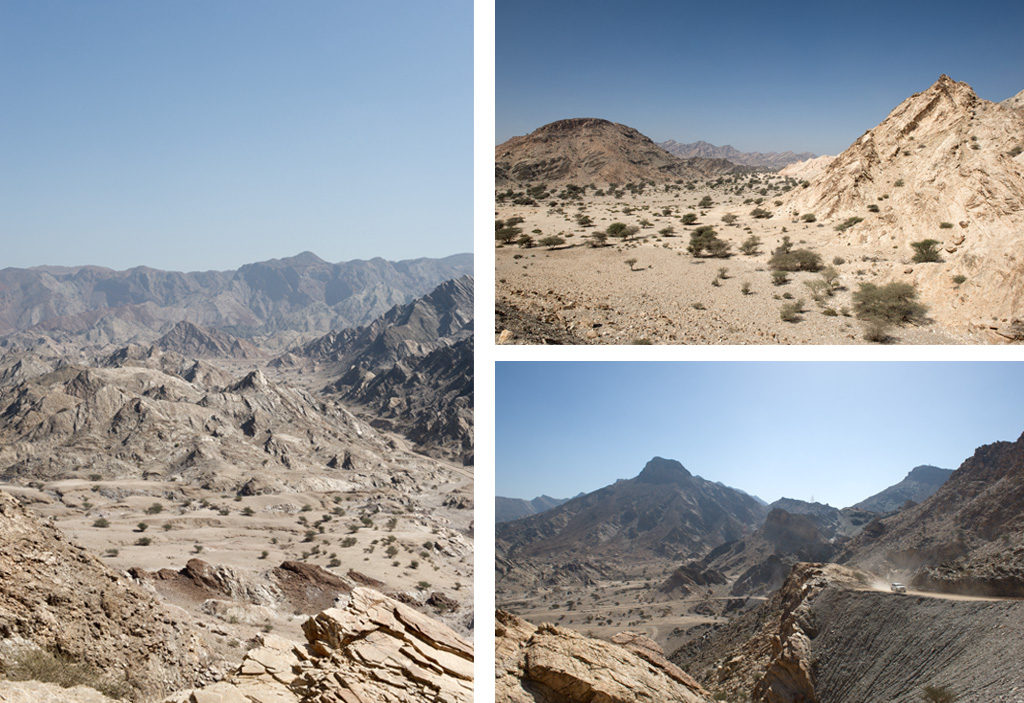
23°29’14.03″N – 58°39’54.17″E
At the Y junction, take right.
23°25’57.52″N – 58°39’22.33″E
You’ve reach the small hamlet of Ash Shiqayri, stay left on the main track at the T junction.
23°26’00.36″N – 58°41’06.14″E
You’ve reach the small hamlet of Al Khityah, stay right on the main track at the T junction, re-entering wadi Hyufahd.
23°24’29.66″N – 58°41’43.00″E
At the y junction, stay right. Follow the main track along the wadi.
23°22’40.17″N – 58°40’48.80″E
As you reach the top of the pass, park along the side for a great photo.
As you go back down, look right for another great photo.
23°22’20.77″N – 58°40’33.45″E
At the Y Junction take left towards Al Silil. Once you reach the road, take right towards the main road Highway 17.
You’re about to be on tarmac for a short while. It is too short to bother re-inflating your tires. However, just drive with caution at a top speed of 80 km/h on Highway 17. Put your warnings on to inform others.
23°21’31.86″N – 58°40’41.42″E
Pass over the Highway on the bridge in front of you, and enter on the other side towards Sur.
23°14’51.62″N – 58°47’15.65″E
Exit the Highway, get to the round-about and pass over the Highway till the next round-about on the other side. Take the first exit on your right. Drive all the way till the T-Junction. At the T-Junction take right and stay left on the dirt track leading towards the wadi.
You’re about to enter Wadi Salil. If you re-inflated your tires before getting on the Highway 17, time to deflate again to 20/25 psi.
This Wadi is of high geological interest. Boards along the way explain the various stone formations seen through out.
23°15’12.85″N – 58°47’31.96″E
You are now entering Wadi Salil. Follow the main track all the way through.
Caution: Wadi are subject to flash floods. You should not enter in case of rain, as you could be flushed away.
I will not repeat this at the entrance of every wadi, I assume that by now it is understood.
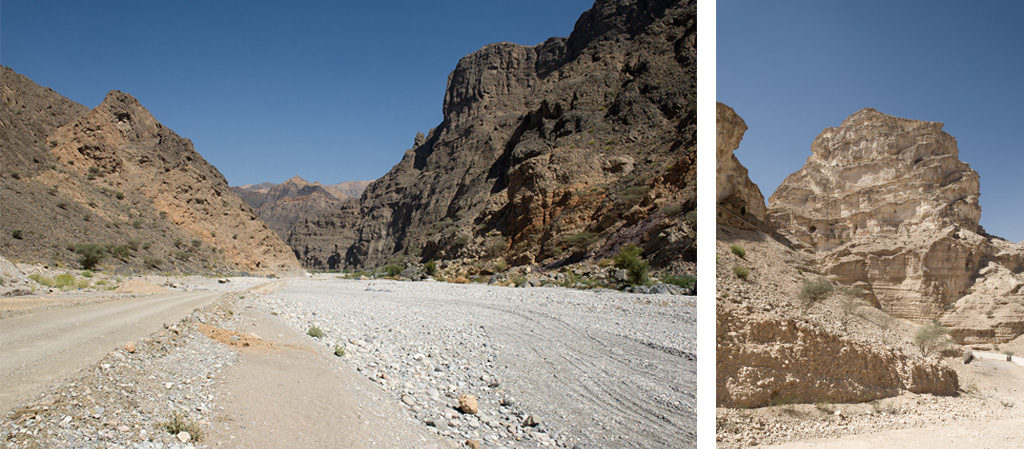
23°15’45.45″N – 58°53’20.42″E
This is the end of the wadi, you’re now entering the small town of Quriyat or Qurayyat. Keep straight left at the Y-Junction.
Quriyat.
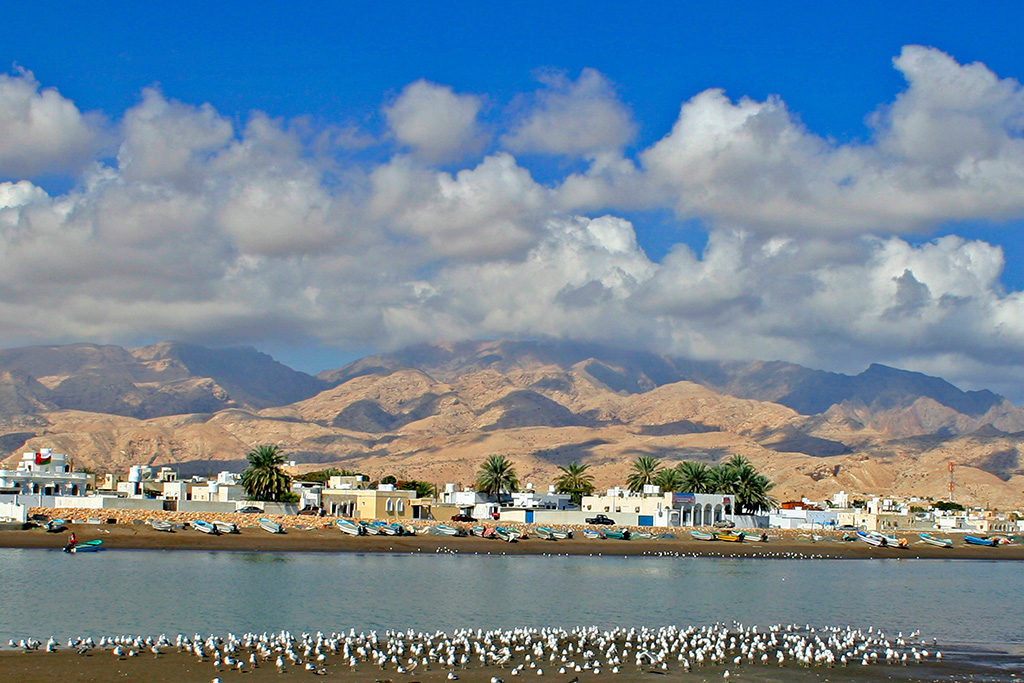
The small coastal village of Quriyat comes to life in the early morning hours as local fishermen take off to sea, and when they return a few hours later to unload their catches on the beach. (This can can be said of every coastal village you will pass on the long coast of Oman). Beside fishing, the area was also known in the past for its horses, raised and exported by local merchants, which brought extra wealth to the town. That was until the Portuguese, lead by Alphonso Albuquerque, raided the town in August 1508 and set it ablaze. Keeping the town under their rule, holding the inhabitants captive, the Portuguese were finally ousted by Imam Nasir Ibn Sultan Al Yurabi in 1648. It is under his rule that the fort was built. Other sources claim it was build by Sayyid Saeed bin Khalfan al Busaidi some two hundred years ago. As always finding out the goods about local architecture can be tricky.
When the government decided to renovate the fort, it transformed it into a museum displaying authentic Omani historical artifacts and handicrafts, as well as books. Rooms have been refurnished to show you how it used to be.
23°15’51.93″N – 58°53’47.32″E
Take right at the junction, leaving the Wadi bed to enter the town. Follow that street (Al Musalla St.) all the way till its end, and turn left in Al Hesn St. (I’m noting down the street names for reference, but they are not often marked, and not always in english. So don’t try too hard to find them. Just Turn left) Having a google earth print out of the various towns along the way always help if you don’t have downloaded the GPS trail.
Once on Al Hesn St. Stay on that main street towards the town Fort.
23°15’55.05″N – 58°54’56.40″E
This is the old town fort. Park in front and have a tour. It has been recently renovated. Opening hours are week-days from 8h30 to 14h30. At the time of writing their was no admission fee. A local guide was offering a brief tour rewarded by your generosity, as it is often the case in smaller cultural attractions.
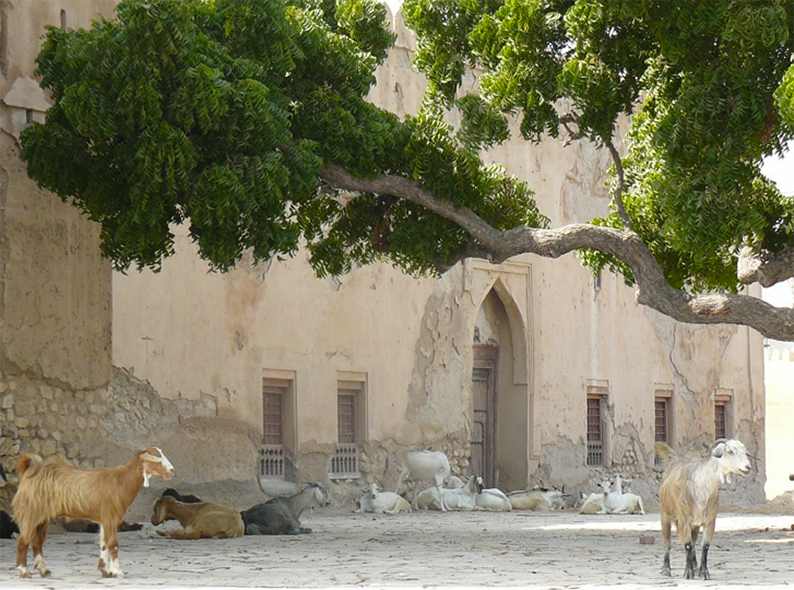
From the fort drive East towards the beach. Once at the beach turn right, pass the small Harbor, follow the road right towards Al Hesn St.
23°15’21.04″N – 58°54’37.72″E
At the T-Junction, take left on Al Hesn St.
23°14’34.46″N – 58°54’11.21″E
You have a gas station where you should refill. (There will be two more options for you before you enter the wadii)
23°13’34.56″N – 58°53’40.73″E
Second gas station, this time on the other side of the road.
23°12’37.52″N – 58°52’12.00″E
At the T-Junction turn left. A third gas station is on your left.
23°12’14.34″N – 58°52’39.00″E
At the round-about, take the second exit, to pass above the Highway 17. On the other side, at the round-about take the first exit on your right.
23°11’02.09″N – 58°53’13.75″E
At the T-Junction, take right.
23°09’59.17″N – 58°52’06.00″E
At the T-Junction, take left. You are on your way to Wadi Al Dayqa.
23°08’01.45″N – 58°53’43.30″E
You have a dirt track on your left leading to Wadi Al Dayqa. There is a gate closing the access, but there is plenty of space on the side for you to pass anyway. (at least at the time of writing. If the access is for some reason blocked for you, turn around, drive back to the T-Junction 23°09’59.17″N – 58°52’06.00″E and take right towards Hayl Al Ghaf. Follow the road all the way to the wadi and enter there. It’s a great drive, but a bit more technical than the proposed section)
Pass on the side and carry on. As you reach the large wadi about 700 meters later, turn right and follow the main track. You’ll see the remnants of an old falaj on the side of the mountain on your right. There will be a few water crossings along the way, most if not all very shallow.
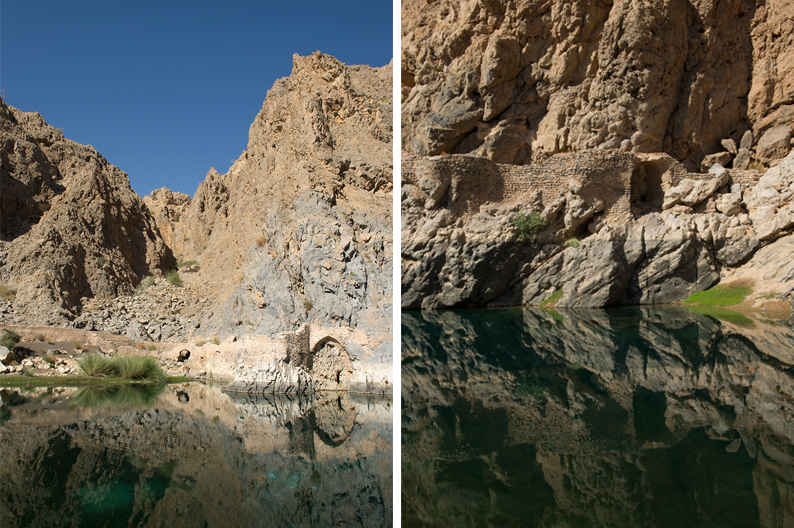
23°05’56.04″N – 58°54’20.29″E
Time to exit the wadi for the dirt track on your left.
23°04’59.62″N – 58°55’01.76″E
Keep straight.
23°04’50.38″N – 58°55’31.74″E
You have a small faint track going straight as the main track curbs left, stay on the main track going left.
23°05’11.75″N – 58°56’58.57″E
You’re reaching a road. Do not get on that road. Stay on the dirt track on the right side of the road as it goes up and turns right. Follow that track.
23°03’52.84″N – 58°57’07.78″E
At the Y-Junction take right.
23°03’02.48″N – 58°56’50.24″E
At the cross road, Keep straight. In front of you is a Hamlet called Fayq. The following section is steep, rocky and demands driving skills. If you don’t feel you have the vehicle or the experience for this type of challenging drive, you can now switch to the Oman Trail guide which is turning right at this intersection and leading you through a much easier and still very scenic trail all the way to Qhalat. (Click here for the corresponding way point)
23°02’56.48″N – 58°56’50.45″E
At the junction take right.
23°02’43.75″N – 58°56’35.04″E
At the junction take left.
23°02’36.70″N – 58°56’31.71″E
At the junction keep left, then right at the following near after.
23°02’16.87″N – 58°56’04.54″E
Keep climbing ! This is where it gets interesting. It climbs to scary percentages on a narrow and (at the time I passed) poorly maintained track. Deep gulleys, loose rocks in sharp turns make this climb a nerve test for the inexperienced driver. You can’t do it without a decent 4×4 with low gear. If you are alone on this journey, have a walk through first before you decide to engage, because it is often too narrow to turn around.
All that being said, it is not impossible by any means and offer a great off-road challenge local shepherds tackle without a sweat ! The track might even be in a much better shape today and offer no challenge at all besides being very steep. You’re feedback is precious, feel free to share your impressions in the comment section.
Finally the sign on the side of the road in Arabic, warns you that you are about to enter a protected natural area.
23°01’32.40″N – 58°54’22.35″E
Bravo, you’ve made it. Keep straight on the main track, that track on your left leads to a very isolated house. The kind you’d want if you don’t like being annoyed by neighbours !

The plateau is the land of goats. In the distance (picture up left) women guide the herds from pastures to pastures.
23°00’31.85″N – 58°52’39.74″E
At the junction keep left, the track going right leads to an abandoned hamlet with ancient ruins.
22°59’52.15″N – 58°52’50.26″E
At the junction take right. On your left is the newly built village called Klof.
22°59’55.19″N – 58°52’43.25″E
At the junction take the second track on the left down towards the small wadi bed.
22°55’37.00″N – 58°54’51.81″E
Keep straight on the main track.
22°55’29.44″N – 58°56’36.98″E
Take right at the junction.
22°55’05.48″N – 58°57’19.53″E
Take left at the junction.
22°55’05.33″N – 58°57’34.41″E
Keep right on the main track.
22°52’43.15″N – 58°59’36.03″E
Keep right at the junction.
22°52’02.92″N – 58°59’44.69″E
Keep left on the main track.
22°50’34.06″N – 58°59’40.83″E
Keep right on the main track, and keep on it as it passes through the houses on each side.
22°50’07.63″N – 58°59’35.61″E
Take left at the junction. Same at the next one just after as you keep now climbing back up.
22°49’36.47″N – 59°00’07.72″E
Keep straight up. And it will be steep on some coming parts ! There will be a few instances were you’ll need to get in 4-Wheel-drive Low to climb.
22°49’33.52″N – 59°00’42.92″E
On your left is a small “cafeteria/drinking place”. I have yet to see it open, but friends have told me it does. If it is feel free to stop and check it out.
Regardless just turn left at the intersection.
(this junction is where you will return tomorrow morning to pursue with the trail)
22°49’57.74″N – 59°01’30.37″E
Keep straight towards one of the last attraction of the day, the
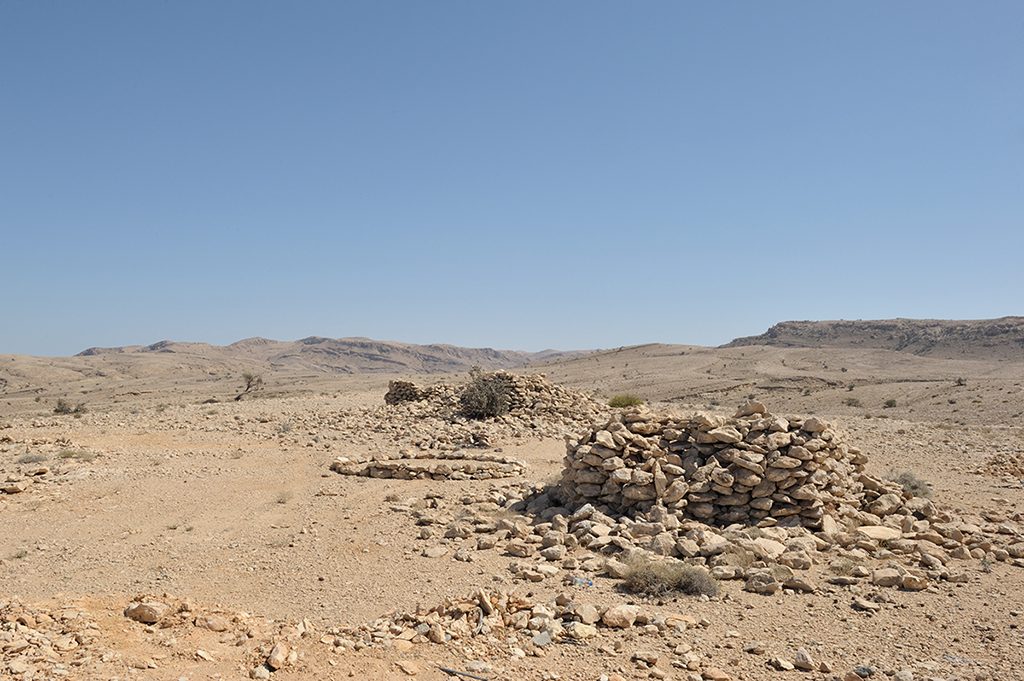
22°48’55.34″N – 59°03’17.74″E
Welcome to the Jabal Bani Jabir Haffit beehive tombs, also called the Jaylah tombs.
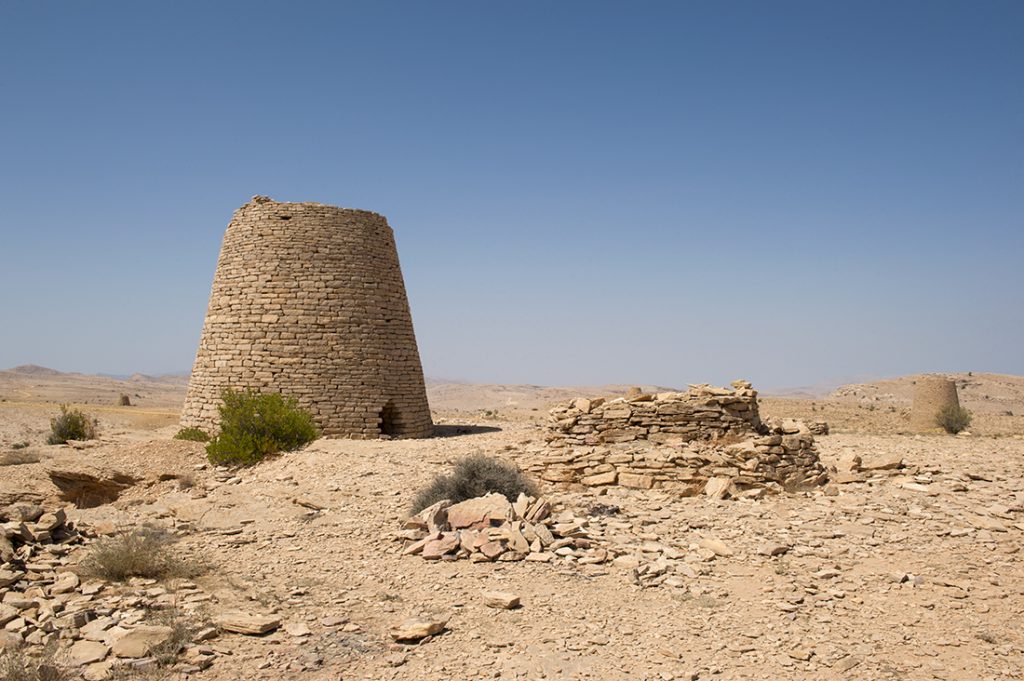
Let me first start by clarifying one thing. Even though it has been agreed to consider those monuments tombs, we actually have no evidence whatsoever they ever were. Indeed, no bones or other fragments have been found in any of them. Here or anywhere else in Oman. It is only because they remotely resemble in shape the Hili tombs found in Al Ayn in the UAE, that we assumed they were related in concept. While those of Hili were of a later date, were larger, had several entrances, multiple inside chambers, the ones you now see, are just plain silos. As such it would be better to admit that we have no idea yet what those structures are, instead of reaching to hasty conclusions we can’t back with any facts.
As such, there isn’t much I can’t tell you about them, beside the fact that it is stunning how such simple structures, made by pilling up surrounding flat stones on top of another some 5.000 years ago, still stand today in front of us. It shows us how, during what we call the Hafit period, roughly the early stages of the Arabian bronze age (3.100 to 2.700 BC), people lived and prospered in this desolated landscape.
It brings out so many questions we have no answers for. How did those people live ? Since we can see no houses or related structures around, where those there shelters ? What did they survive on ? How come we have found no remains, not only it what we pretend to be necropolis, but also in the surrounding area ? Etc, etc…
When I was here I had the chance to be greeted by a large group Egyptian vultures circling around the “tombs”. I wish you the same luck.
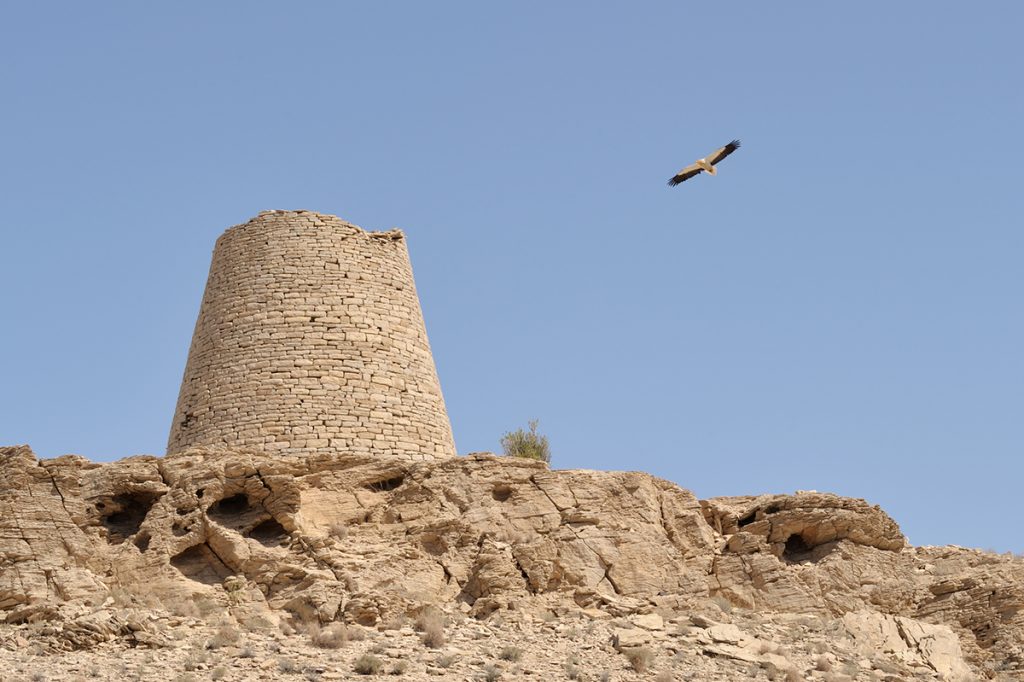
Once done with the visit, get back on the track and look for a place to camp. Be discrete and respectful of your surroundings as you are in a natural reserve.
This is the end of day 10.
Day Eleven
Jabal Bani Jabir to Fins
100 km.
Introduction.
This is our last day on this trail, as we drive back down towards the ancient town of Qalhat, before finishing the day in wadi Shab or wadi Tiwi, and a final night on the indian ocean.
Recommendations.
Today’s drive is much easier than yesterday’s. No particular difficulties as you drive down the mountains towards the beaches below.
The drive.
Starting Point.
From where ever you decided to camp, return to the main track you left yesterday and return to the Cafeteria junction at 22°49’33.52″N – 59°00’42.92″E. There you will take left.
22°48’53.23″N – 59°01’12.13″E
Take right at the junction. Do the same at the next one following up.
22°48’24.72″N – 59°01’09.43″E
Keep straight on the main track.
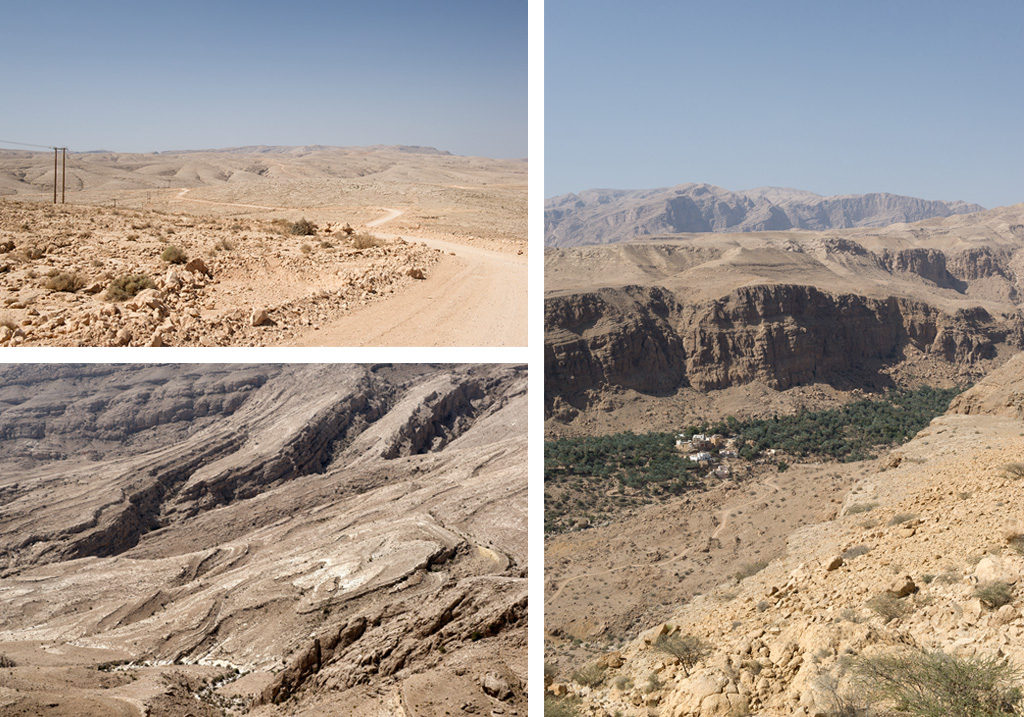
If you take the time to observe the landscape you will notice how tortuous some stone formations are, revealing the forces at play during the formation of the Al Hajar Ash Sharqi.
22°46’44.97″N – 59°03’05.88″E
Keep left at the junction. For info, the track on the right is part of the Oman trail and leads you all the way the wadi Bani Khalid. (If interested in jumping to that trail click here.)
22°46’09.63″N – 59°04’04.86″E
Keep left on the main track.
22°44’55.50″N – 59°06’09.91″E
Take right, cross the wadi and climb back up.
22°43’48.20″N – 59°06’52.82″E
Keep straight on the main track. Do the same as you cross the hamlet ahead.
22°42’21.86″N – 59°08’34.66″E
Keep on the main track. The one on your right leads to a pylon/observatory station.
22°43’09.05″N – 59°13’02.71″E
Take right at the junction.
22°42’36.67″N – 59°14’49.39″E
Take right at the junction.
22°41’00.82″N – 59°19’28.71″E
Keep straight.
22°41’52.34″N – 59°22’11.84″E
Turn right and cross the wadi, then climb up to the plateau to see the ruins of the old Qalhat.
Qalhat.

When I went the site was closed for archeological research. Yet, if you ask nicely the guard on site, he will let you in. (Being polite I went to ask first if I could enter, others didn’t bother and just went in anyway) This area being of major touristic interest, I can’t imagine it being close like this for ever, and you might not see anyone restricting its access by the time you go.
It is hard to imagine by looking at what is left of Qalhat, that it used to be a splendid ancestral city, visited and described in eloquent terms by such figures as Ibn Battuta or Marco Polo. First erected by Persians around the II° century, the town had reached its peak by the XII° century, where it was known as an influent harbor full of ships coming and going as far as India and China, exchanging horses and dates for exotic goods. All came to an end with the arrival of the Portuguese, and Albuquerque, (again!), destroying the town in 1508.
What you are looking at on that small plateau overlooking the Indian Ocean are the remnants of what was a beautiful mosque build by the Persians, and named after a saint Bibi Miriam. It was then surrounded by fortified walls protecting houses and shops, supplied with fresh water by a sophisticated falaj system coming down from the mountains.
Once done with the visit, cross the wadi again and take right on the road you just left. It is a good time to bring your tires back to their standard road pressure. Follow that road all the way to Highway 17. There get on the highway, direction Muscat.
From here you have two choices. Either stop and visit Wadi Tiwi, or Wadi Shab. Both are beautiful and worth the stop. To reach either get off highway 17 at 22°48’51.67″N – 59°15’53.61″E.
Wadi Tiwi.
22°49’32.60″N – 59°15’39.25″E
Take left at the junction. The road will pass underneath Highway 17 and enter wadi Tiwi. Keep driving all the way through, passing villages and plantations. (at times the drives gets tricky – narrow streets, steep portions, etc)
When you feel you can’t go any further, park your car so you don’t bother local villagers and start your trek up or down the wadi.
For info I parked at 22°46’17.25″N – 59°12’50.86″E which is by Mibam. You can’t go any further by car. The main attraction of the wadi, its waterfall, is right below, but a bit challenging to reach. Once down, go either up stream or down stream.
Wadi Tiwi is not as busy as wadi Shab, because its exploration is more technical and requires more physical endurance. (Nothing too hard nevertheless) However, just like wadi Shab, you’ll need to hike and swim your way through.
Wadi Shab.
22°50’22.35″N – 59°14’48.66″E
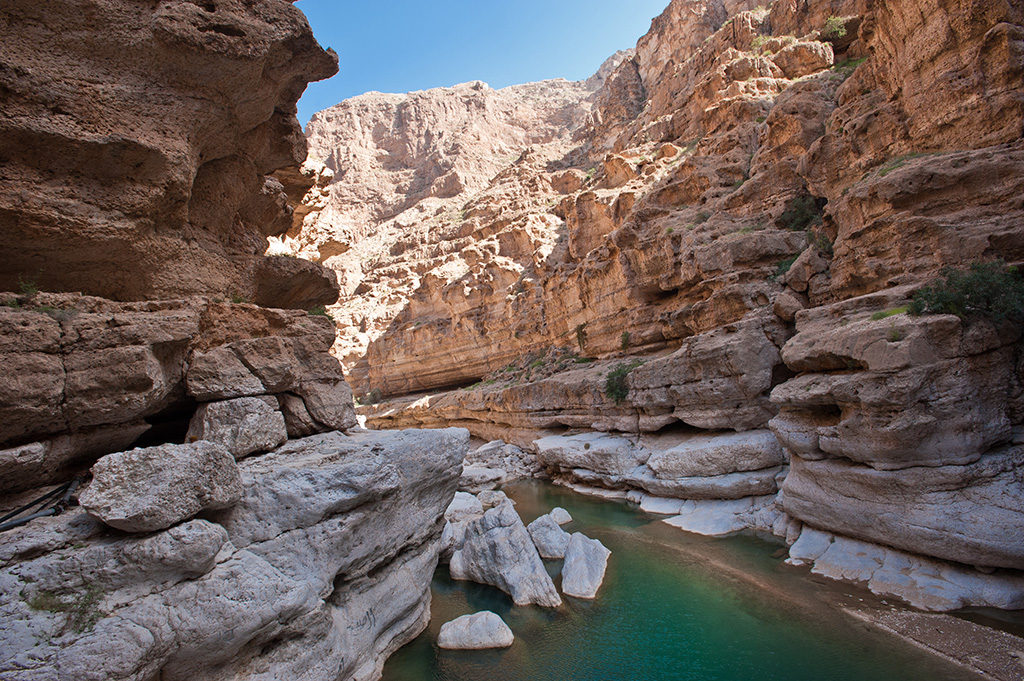
Take left, pass underneath the Highway and park your car. You are now at the entrance of beautiful wadi Shab. You then need to get on the rowing boats across the pond if the water level is high (price 1 Rial per person). From there you can hike and swim through, the main attractions being the clear water pools and the waterfall in one of the caves which stands about 45 minutes away.
This wadi is a very popular attraction being so easily accessible and still fairly close to Muscat. It is on every tour operator’s list of places to see. As such it can be busy. But most people don’t go very far in, most stopping when you must get wet to pass through the first pools. It gets far less crowded after that and the further in you go.
To reach the cave and its waterfall, you have to swim through. Depending on the water level you may have to dive to pass through. Once in you have ropes installed you can use to climb up and dive in the pool.
Enjoy the swim, be safe, and take your trash with you, which should be understood by all, but unfortunately isn’t !
Once done with either wadii, get back on the highway direction Muscat and get off at the Finns exit 22°54’53.61″N – 59°11’48.55″E. Take right and drive towards the beach. At the T-junction take right and follow along the beach.
22°53’38.21″N – 59°13’11.62″E
Take left towards the beach and set-up camp. Note that on a week-end the place is very popular (means noisy!)
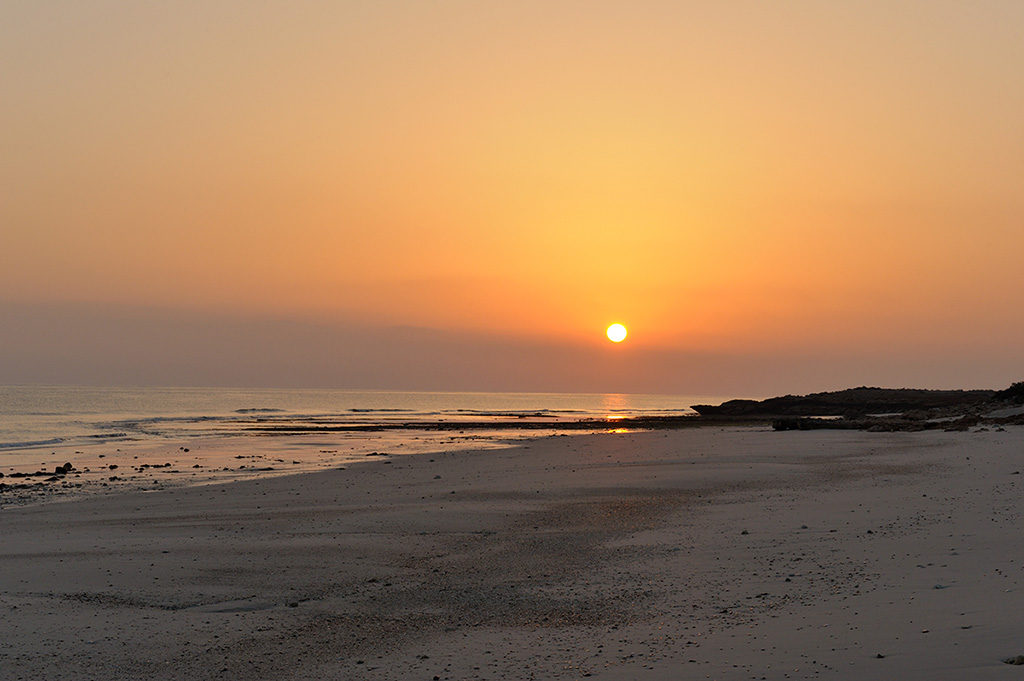
End of day 11.
CONCLUSION
I hope this journey is one you’ll never forget, and will make you want to discover more of the amazing region. If you are, I invite you to check our other local guide called the Oman trail, which links to this one on several occasions. If you have time on your hands, just keep on going as it will take you all around the southern parts of Oman.
If not, have a safe return home. From Fins, you need to get back on Highway 17 toward Muscat, then get the road connection back to Dubai.
Make sure to leave your comments and feedback as we need your updates to keep this road book accurate, interesting and safe.
A special thank you to the Oman Ministry of tourism for letting me use some of their beautiful pictures along mine.
Happy Adventuring !
Share this trail on Pinterest.


well done, fantastic work….
Thank you very much Paul.
It looks absolutely amazing !!! Thank you for those beautiful images.
Thank you, I appreciate.